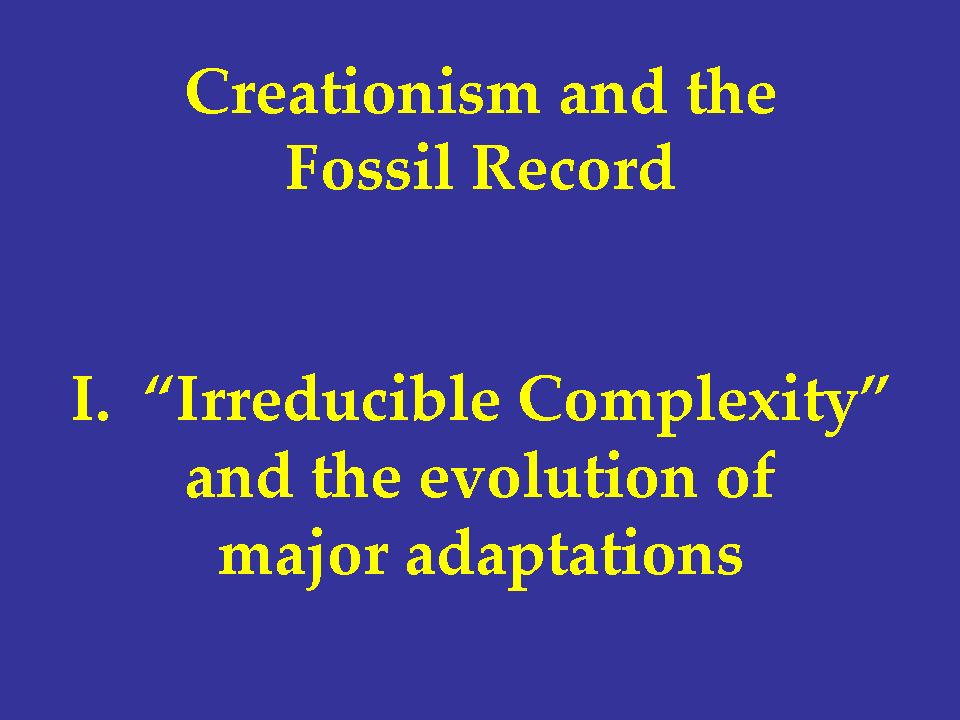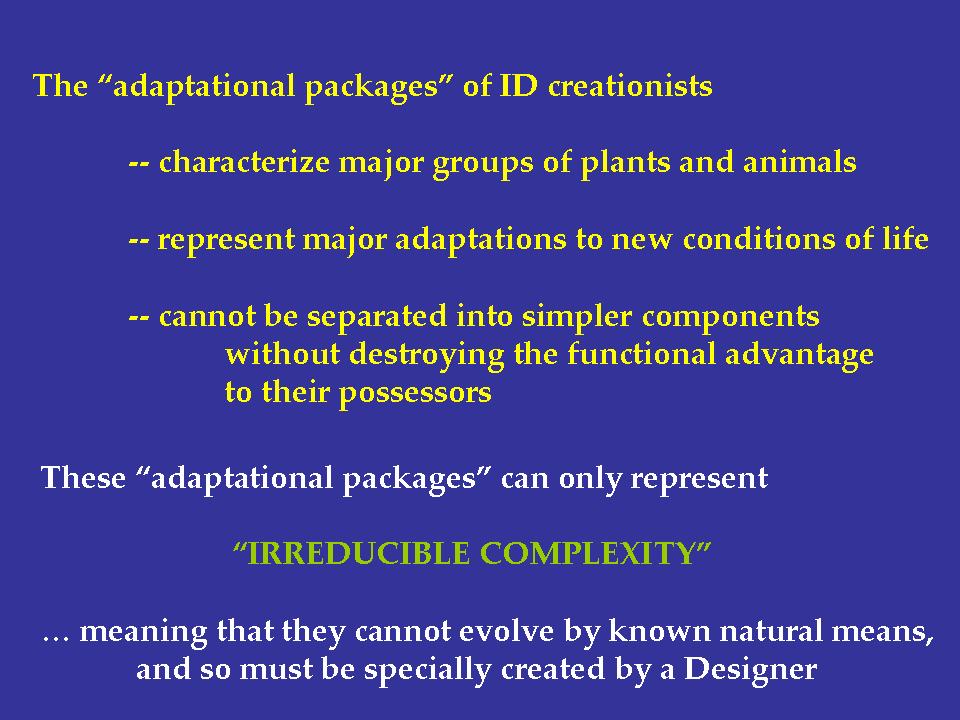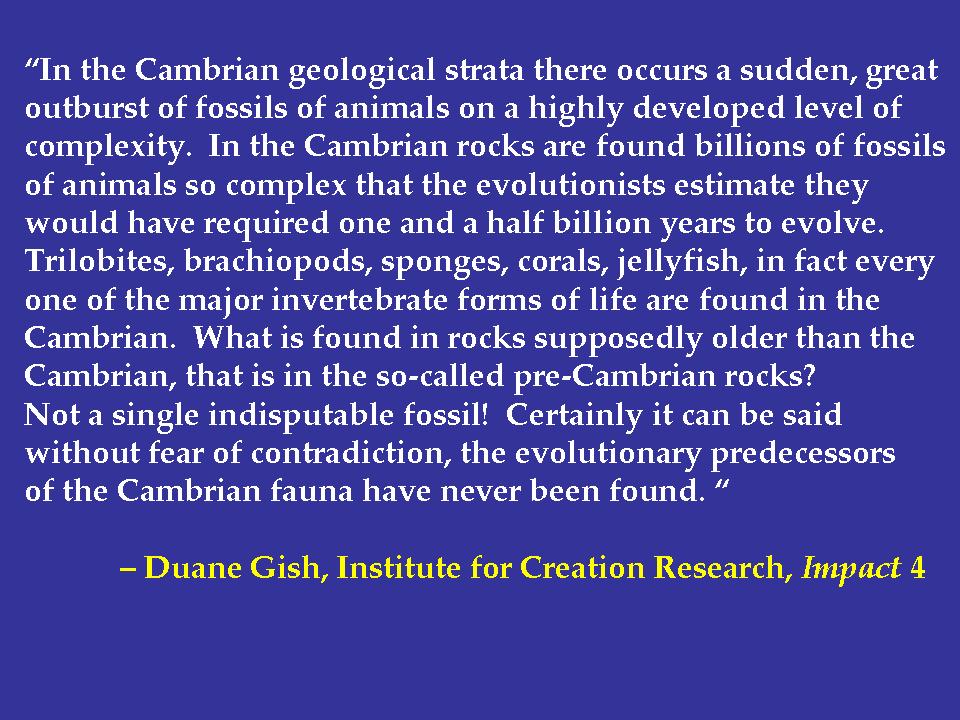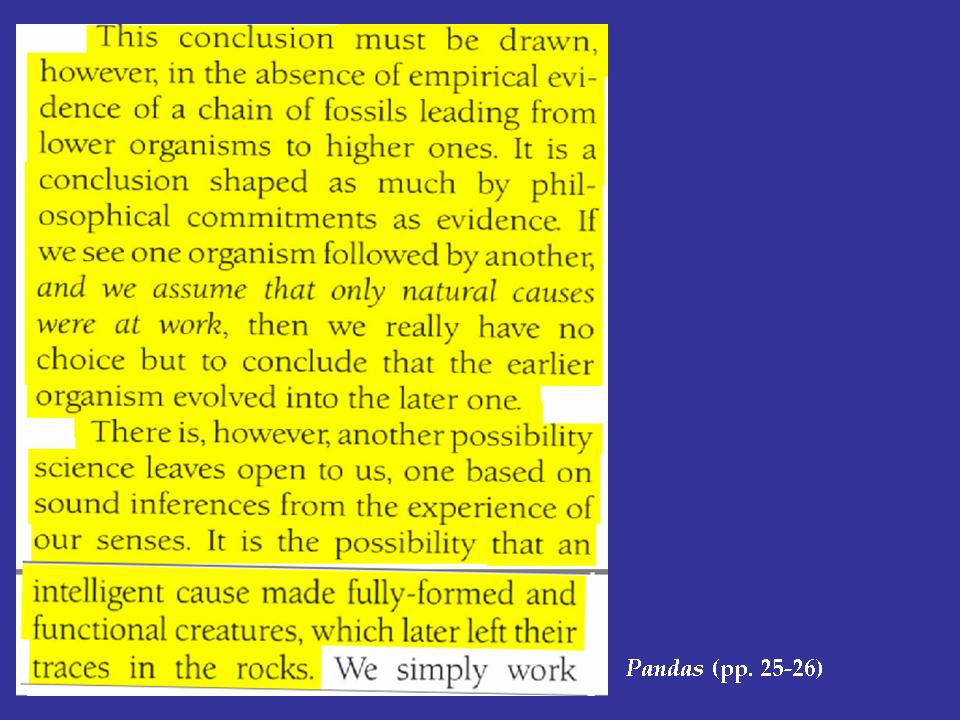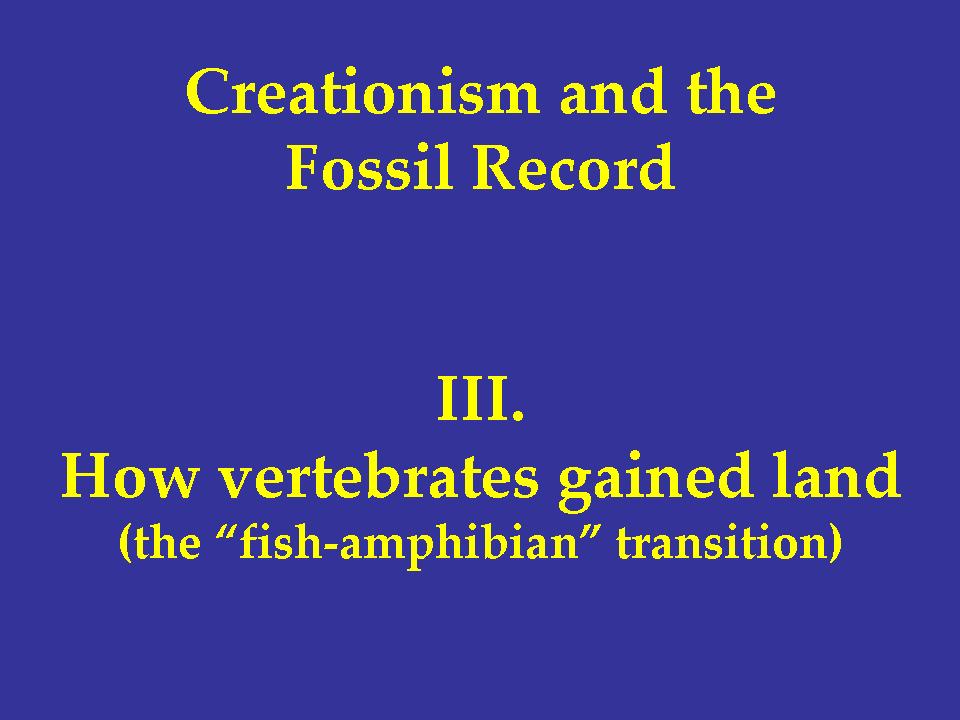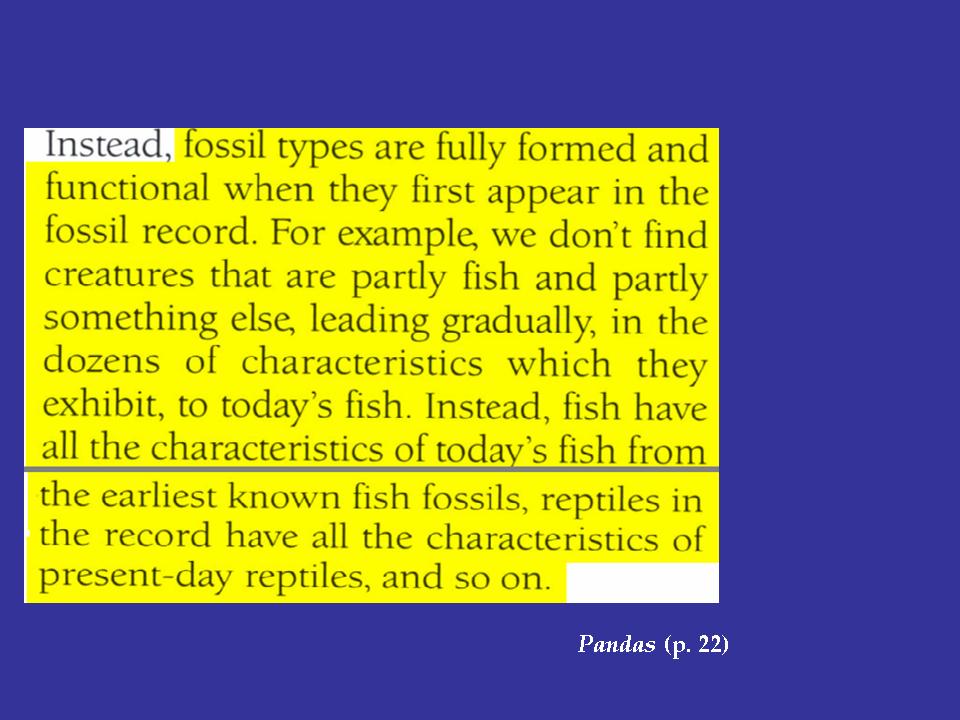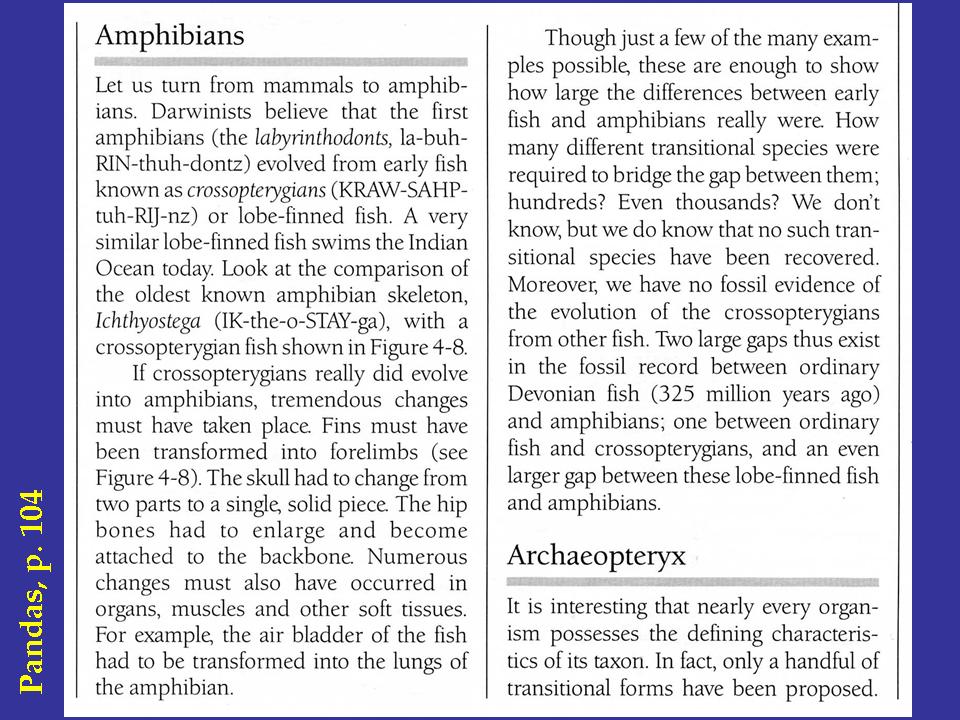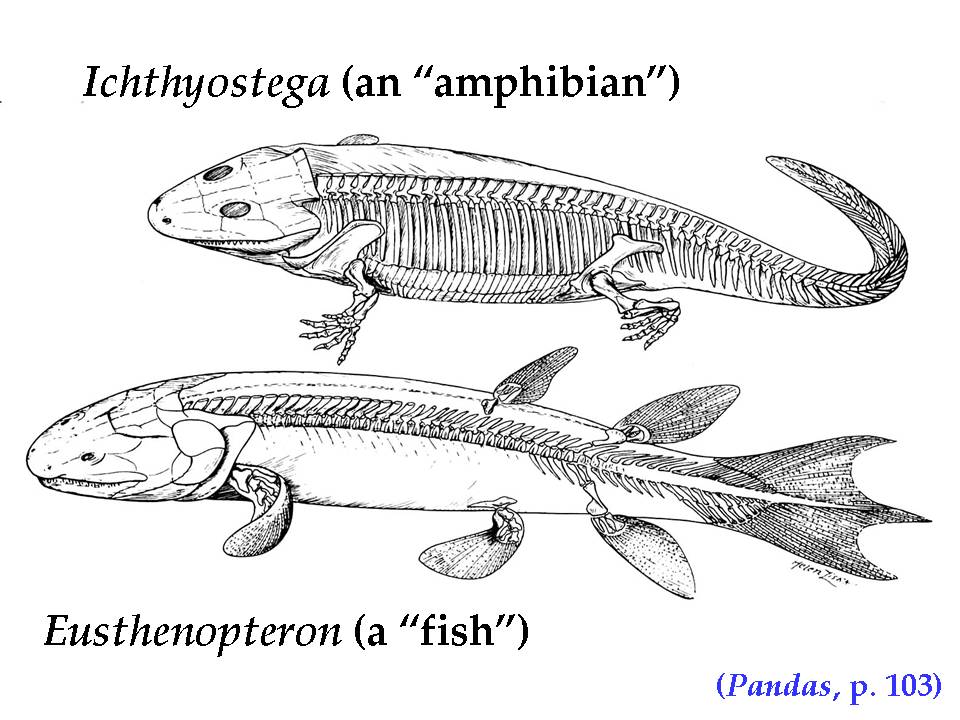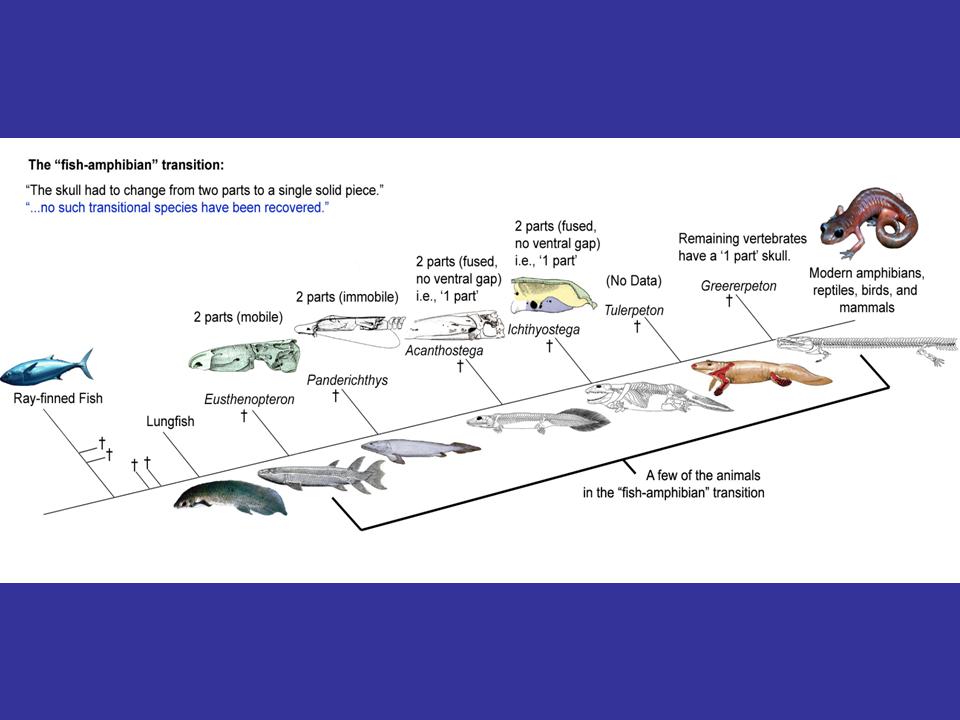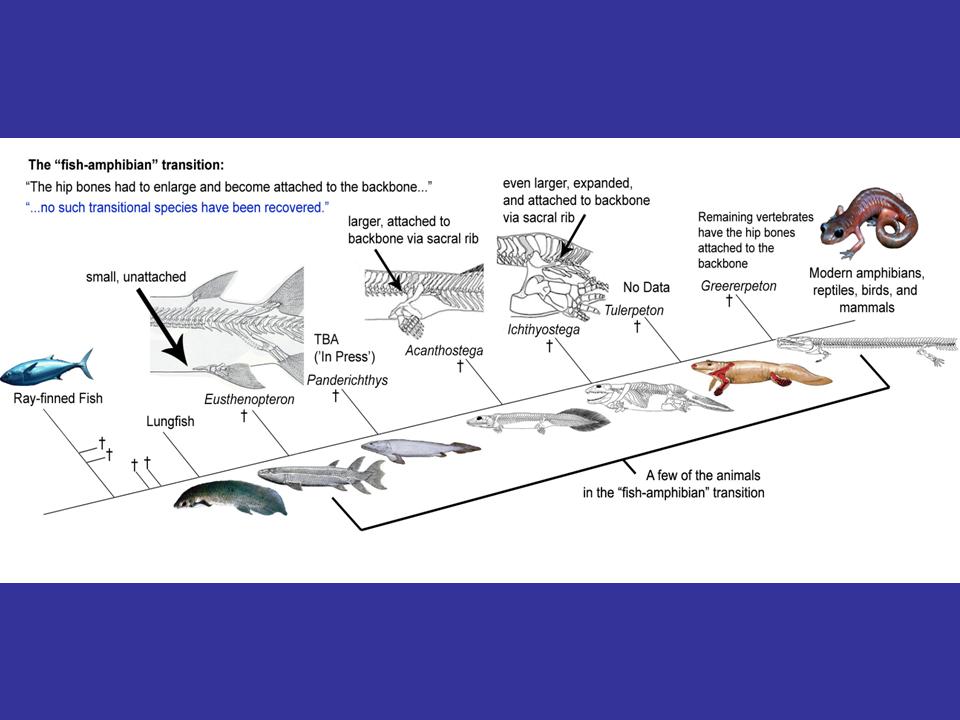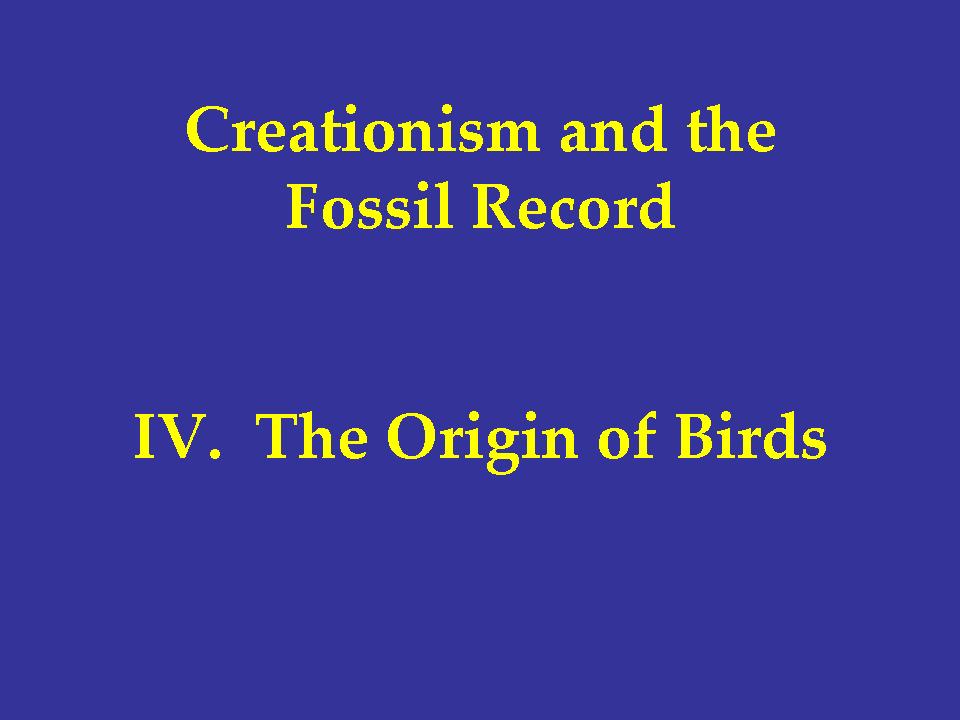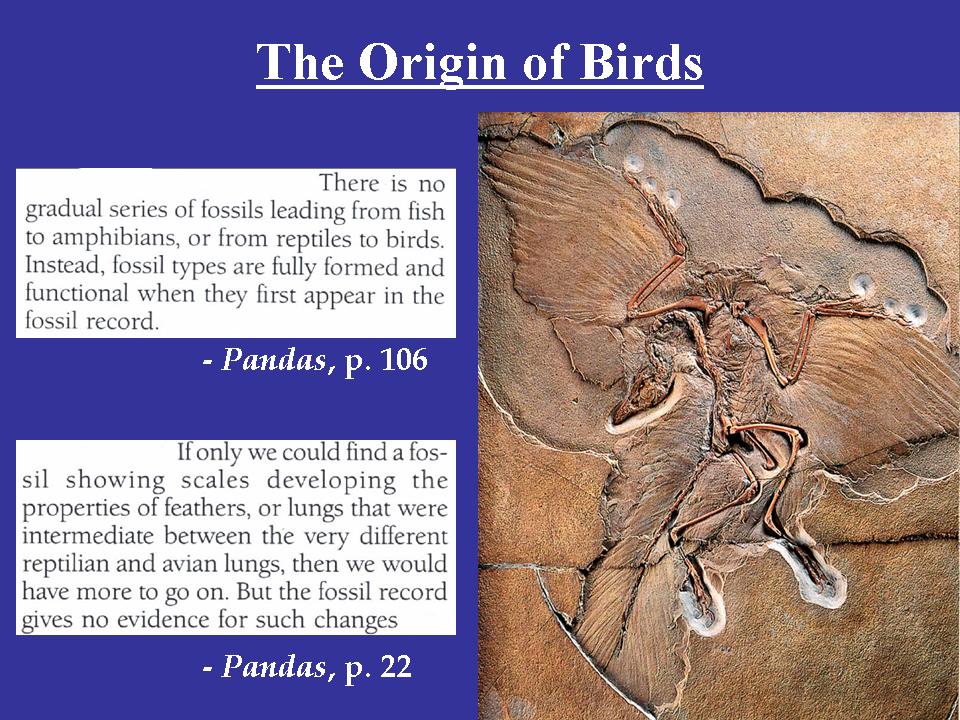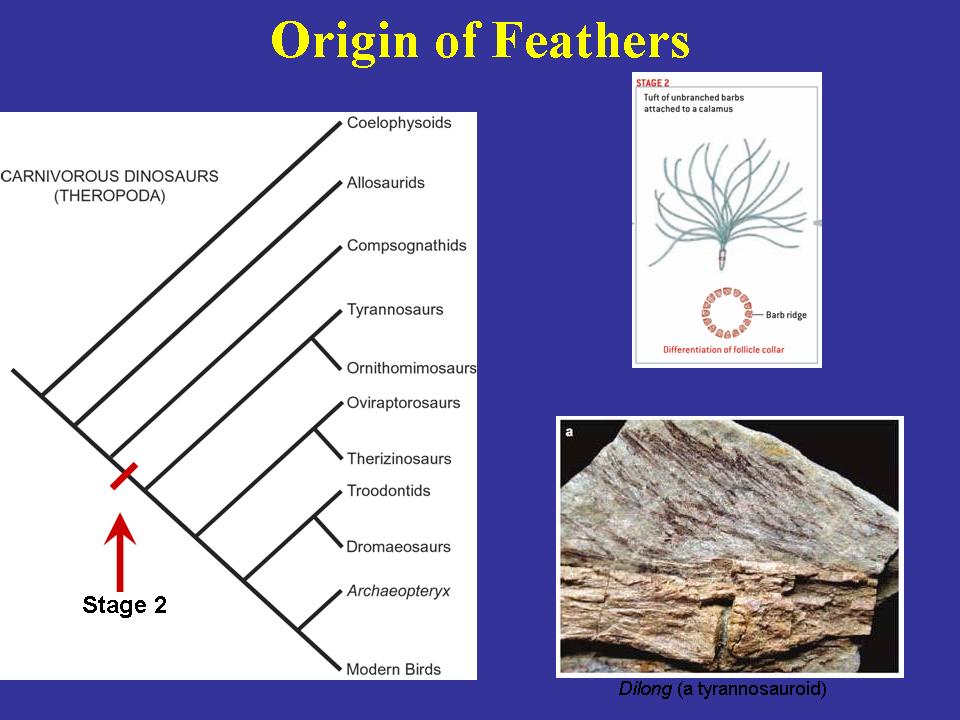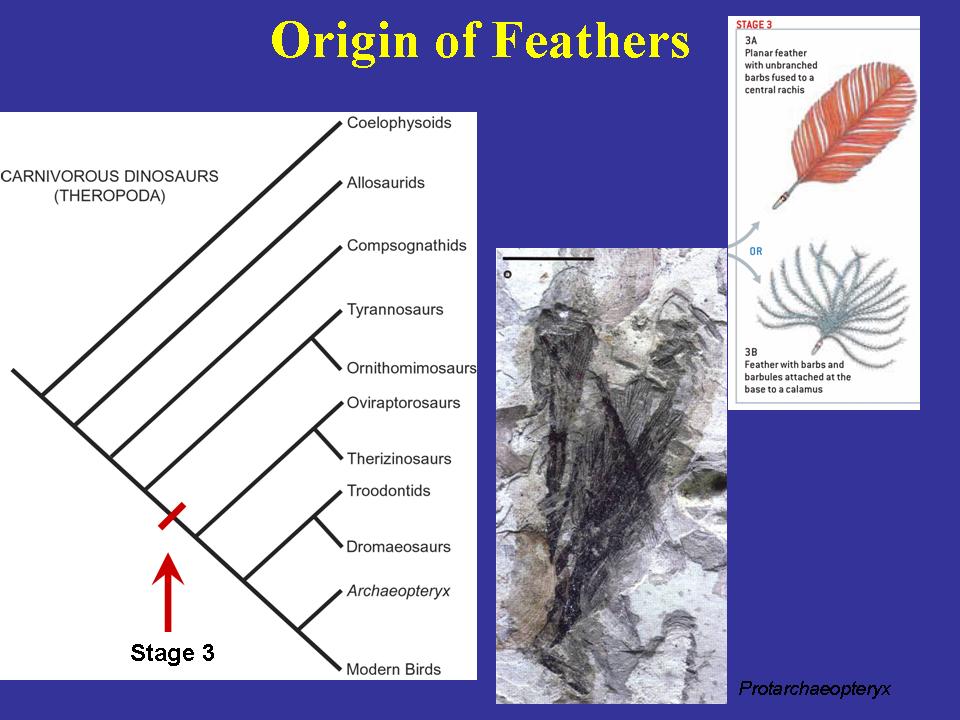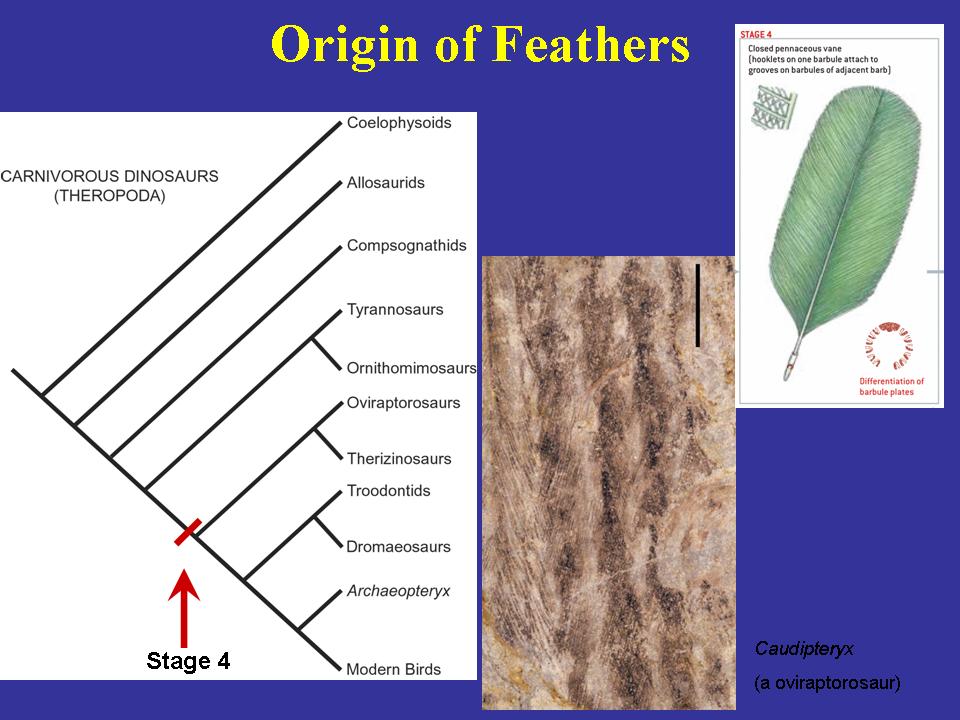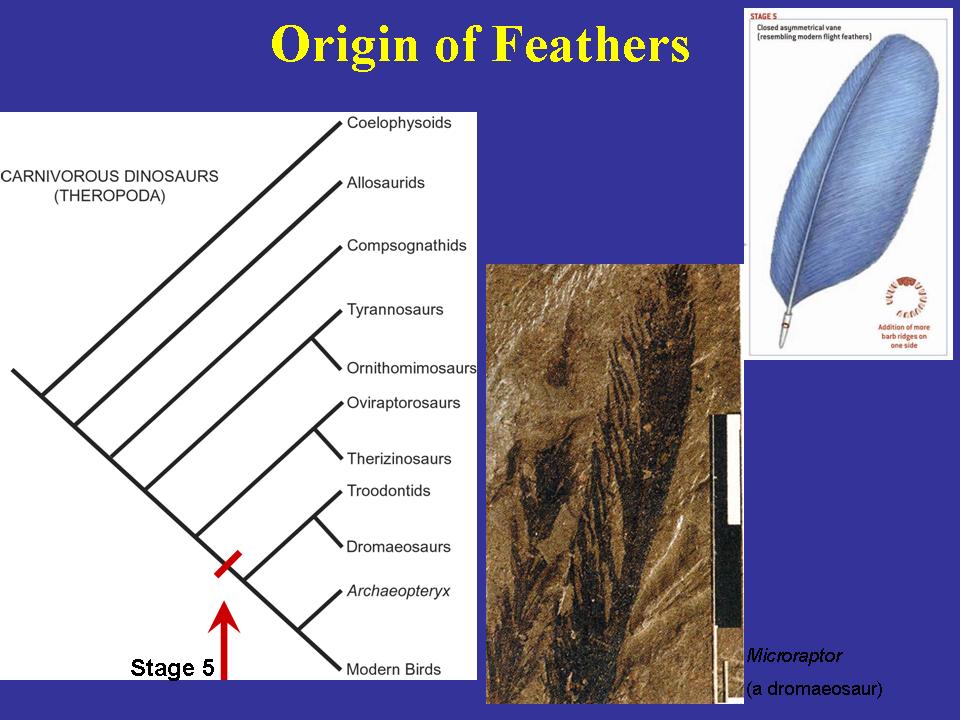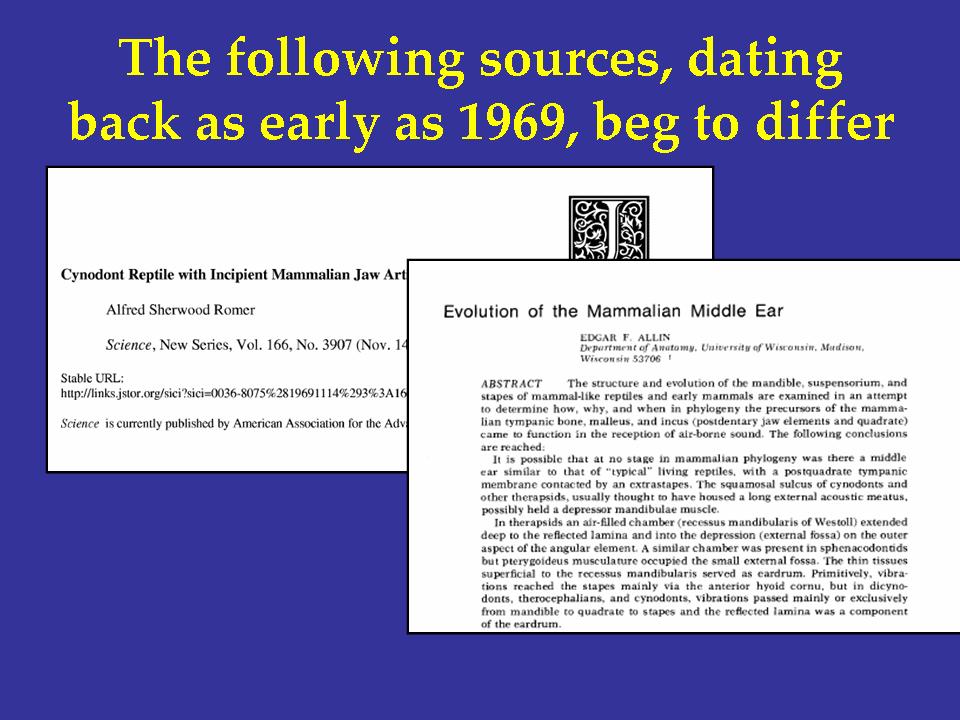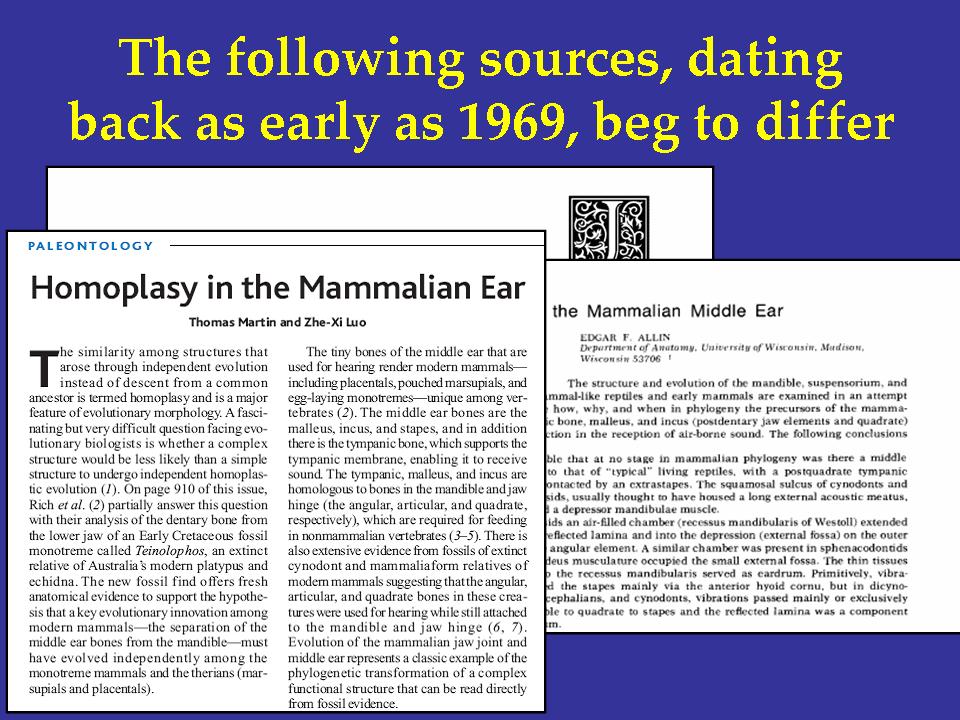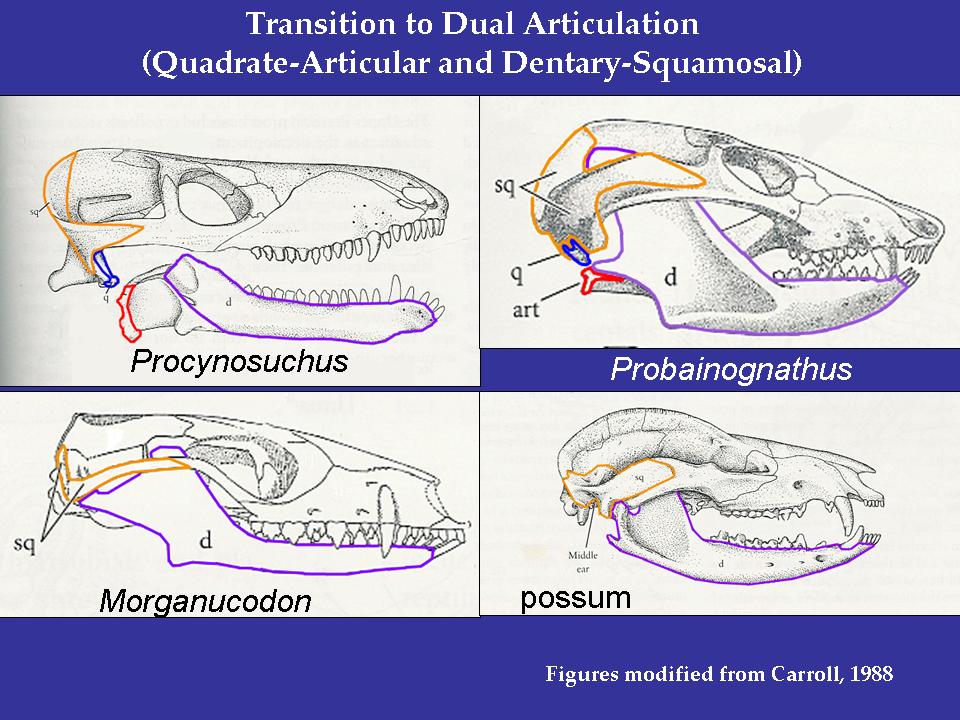I. "Irreducible Complexity" and the evolution of major adaptations
Q. I'm going to talk about the use of the term "irreducible complexity" and "adaptational packages" as it's used by intelligent design proponents.
Can you explain to us how Pandas uses the term "adaptational packages"?
A. Well, the last slide showed you lineages of organisms that seem to have a sudden appearance and no substantial change during their histories and of no relationship to any other lineages in this diagram.
This suggests quite strongly, and the Pandas authors are making this point, that organisms that they regard as major types of organisms suddenly appear with all their major features intact and that they do not change. These are characterized in works like Pandas as adaptational packages, which they say cannot be separated into simpler components without destroying the functional advantage that they provide to the organisms that have them.
And so these adaptational packages for ID proponents represent the concept called irreducible complexity, which means that they can't evolve by known natural means, they're too complex to do so, and so they must be specially created by a designer.
|
|
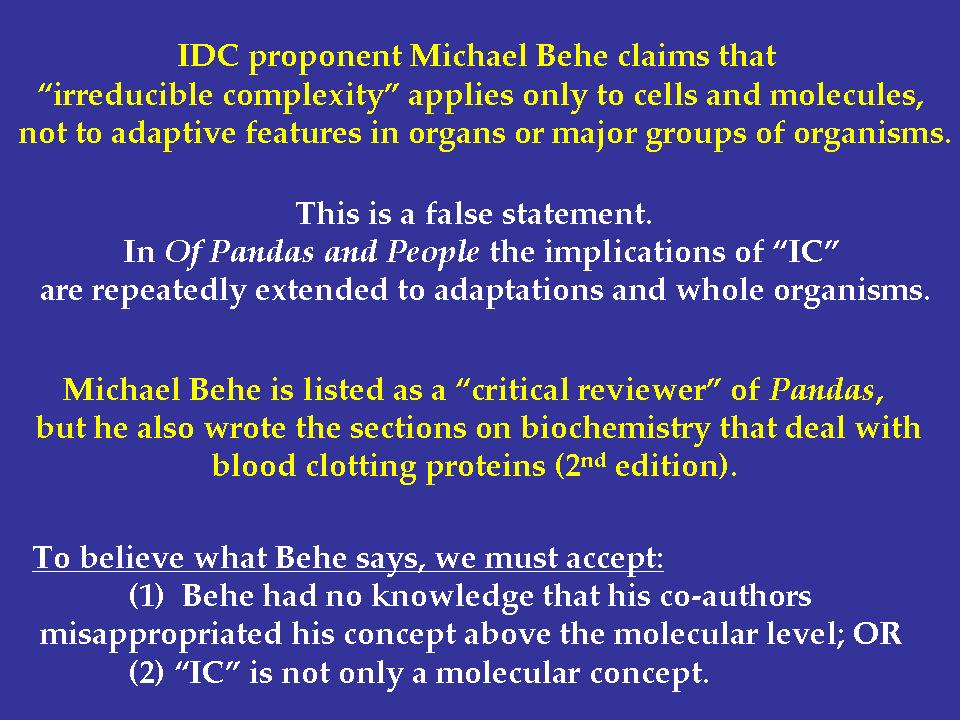 |
| Slide 22: Behe's claim that the "irreducible complexity" argument applies only at the molecular level is contradicted by Pandas, which applies the argument to whole organs and organisms. |
| (Right-click to download pdf.) |
Q. Now, that term "irreducible complexity," is that one, to your knowledge, that's found in Pandas?
A. To my knowledge, the exact words are not found in Pandas. I believe the first place where that is really brought out as a major term is in Michael Behe's book Darwin's Black Box in 1996. But in 1993, when I believe Professor Behe was working on the second edition of Pandas, these concepts are brought out in the second edition of that text.
Q. So Dr. Behe's concept of irreducible complexity is contained in Pandas even though that term is not used?
A. Yes. And before, even in the first edition, these adaptational packages are represented. They are essentially one of these ideas that, again, has a long pedigree, that there are such complex forms out there they couldn't possibly have evolved. We've heard these arguments since the 1800s, so they do have a long history.
Q. Perhaps you could help explain to us these adaptational packages and irreducible complexity.
A. Well, there seems to be some conflict among the ID proponents about this. Dr. Behe claims that irreducible complexity applies only to cells and molecules, and that's his specialty, of course, he's a biochemist, and that it does not apply to adaptive features in organs or to major groups of organisms.
But if you look at the whole corpus of intelligent design work, including Pandas, on which Dr. Behe worked, the implications of irreducible complexity are extended time and time again to large-scale tissue and organ adaptations and, indeed, to whole organisms.
And so if we're going to accept this, we have to accept that Dr. Behe had no knowledge that his coauthors were going to take his concept above the cell and molecular level, or irreducible complexity is, in fact, not only a molecular concept and we cannot accept Dr. Behe's view on that point.
Q. And have you identified an example to show how this irreducible complexity does apply above the molecular level?
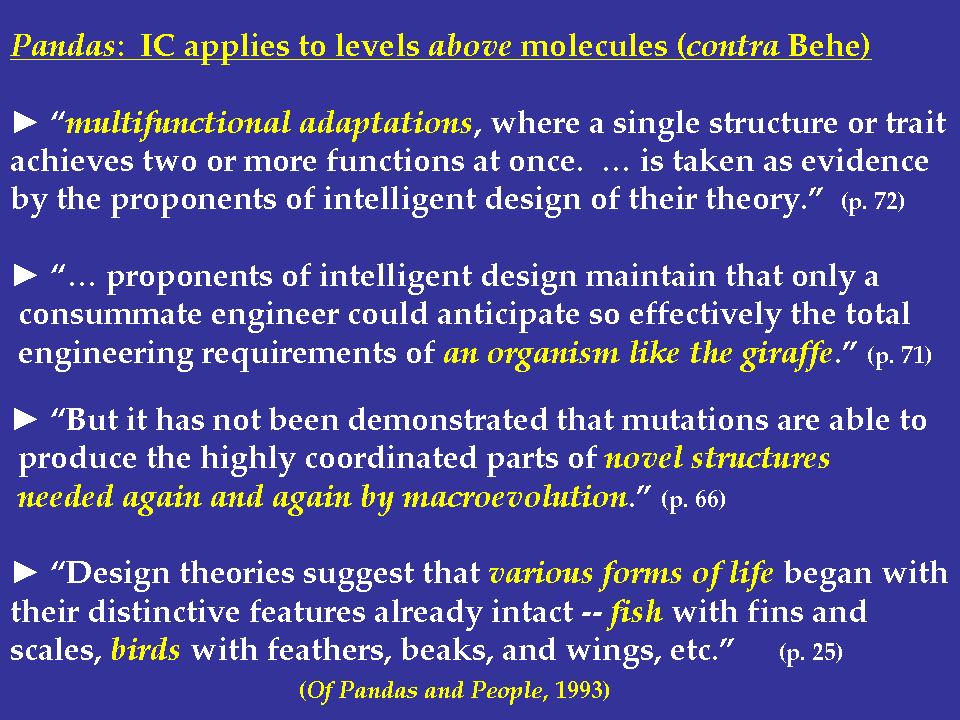 |
| Slide 23: Examples of Pandas making the IC argument above the molecular level, at the organismal level. |
| (Right-click to download pdf.) |
A. Yes. I'll give a number of them from Pandas just to show that they actually are there. The next slide, I believe, shows several quotations from Pandas that indicate that it applies to levels above simply molecules. A quote from Page 72 indicates that multi-functional adaptations where a single structure or trait achieves two or more functions at once. This is not restricted to the cell level.
A quote from Page 71 talks about, quote, the total engineering requirements of an organism like the giraffe, unquote. So here they are talking about the whole organism, a giraffe, not simply a cell or a molecule.
The quote from Page 66 says, quote, It has not been demonstrated that mutations are able to produce the highly-coordinated parts of novel structures needed again and again by macroevolution.
Now, recall here that macroevolution, to intelligent designers, is the origin of new types of organisms, not of new cells, not of new molecules. So they are really looking at the large-scale structural tissue, organ, individual organism level. And, finally, the quotation from Page 25, which I believe is maybe even repeated more or less on Page 99 --
Q. So that's not an error, that is on Page 25?
A. Oh, yes, it's 25, as well.
Q. And this is from the introduction, overview of the book?
A. Yes, it's from the overview of the book. It says, quote, that design theories suggest that various forms of life began with their distinctive features already intact, fish with fins and scales, birds with feathers, beaks, and wings, et cetera. So they are talking about various forms of life, not molecules, not cells.
And here's an example, just to show you a page from Pandas, that does this with respect not to the giraffe as a whole, I've already showed you how they've dealt with the consummate engineering requirements of the giraffe as a whole, but this is just a set of structures in the giraffe's head, neck, and brain.
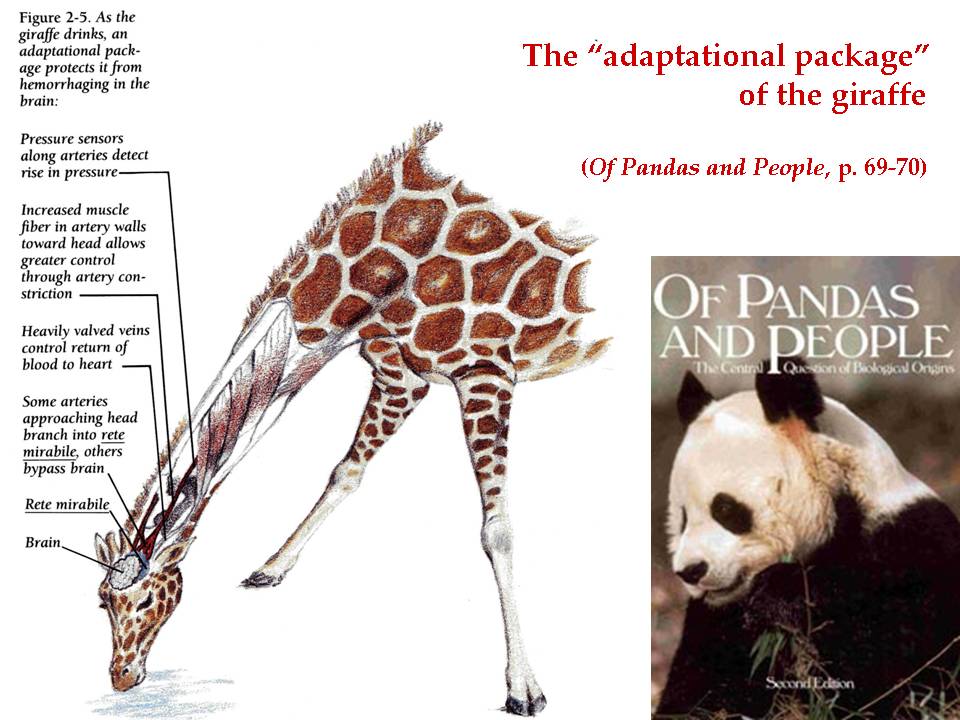 |
| Slide 24: Pandas used the giraffe as an example of an adaptational package (pp. 69-70). |
| (Right-click to download pdf.) |
|
Credits: Giraffe from Pandas Figure 2-3, p. 70. ©1993 by Foundation for Thought and Ethics, Richardson, TX 75083-0721 |
Q. And could you identify the figure and page number?
A. Oh, yes, I'm sorry. This is Figure 2.5 from Pages 69 and 70.
Q. And that's in Pandas?
A. In Pandas, second edition. And so they are talking about an adaptational package in the caption that protects the giraffe from hemorrhaging in the brain. And this is all perfectly reasonable. Pressure sensors along the arteries, muscle fibers in the artery walls, heavily valved veins, and the arteries that approach the head they say correctly branch into what's called rete mirabile, which is a network of capillaries that prevents the brain from exploding when it gets a flood of blood coming up to it suddenly.
These are correctly understood by physiologists as part of an adaptation of the giraffe, but I just want to point out here that this is not a discussion of cells and molecules, this is a discussion of tissues and organs.
Q. Now, I want to turn to the fossil record, and I've asked you to identify from the book Of Pandas and People various examples where they claim that certain types of organisms could not have evolved naturally.
Can you show us where you believe that Pandas misrepresents the science? I believe you want to start with the Cambrian explosion?
A. Well, I'd like to start with a few examples that are of some concern to scientists because the representation of the science in these pages is really quite different from what scientists understand and understood when Pandas was written.
The next slide, I guess, starts with several quotations from Pandas about the Cambrian explosion. Now, I should explain that what is meant by the Cambrian explosion is a sudden appearance of organisms that are shelled marine organisms within a geologically rapid time, relatively speaking, 10 to 30 million years as the smallest possible increment, which seems like a long time to us as humans. If my testimony goes very long, I think it's going to seem like several million years, but --
THE COURT: You're doing fine so far.
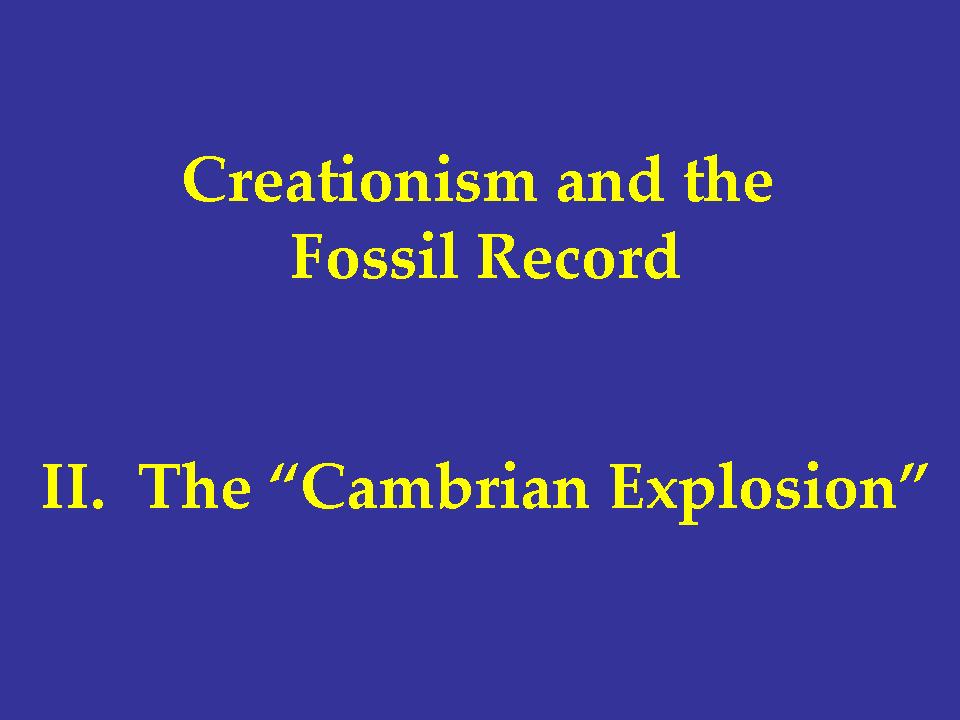 |
| Slide 25: Padian addresses the "Cambrian Explosion," a favorite argument of creationists/ID proponents. |
| (Right-click to download pdf.) |
II. The "Cambrian Explosion"
THE WITNESS: You know, time to paleontologists means something quite different than it means to ecologists and normal people. But these organisms appear over 500 million years ago. And we find records mainly of these shelled sea creatures, marine invertebrates we call them, snails and clams and their relatives back in that time.
Before this the record is a bit more difficult. It preserves different kinds of fossils that are a little bit harder to suss out. And this has been a really interesting area of study for paleontologists, biologists, geochemists, geophysicists for many, many years.
The way that Pandas treats this is to say that organisms appear with these adaptational packages intact at the Cambrian boundary, multicellular life first flowers here. No evidence whatsoever of fossil ancestors.
Q. Now, I'm sorry, is that a direct quote from Pandas?
A. This is a direct quote from Pandas, Page 71 and 72. They go on to infer directly that only an intelligent designer could do this. They state, on Page 94 and 95, that the great majority of these animal phyla, by which is meant sort of these major groups of invertebrates, the arthropods and the annelids and the echinoderms and the mollusks and so forth, brachiopods, appear in a remarkably brief period of time, again, 10 to 30 million years.
We'll have recourse to that 10 to 30 figure in a second. But they say they're not connected by evolutionary intermediates, and there's an unexpected lack of fossils bridging the evolutionary distance between these phyla to document evolutionary origins for them.
Q. What does that mean?
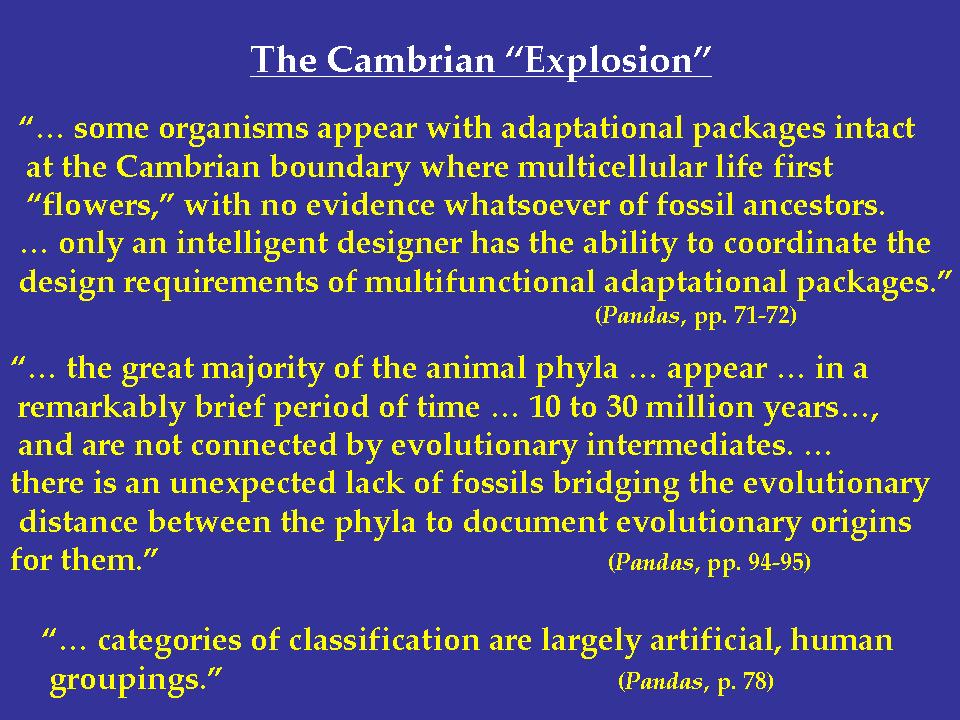 |
| Slide 26: Assertions from Pandas on the origin of phyla at the beginning of the Cambrian. |
| (Right-click to download pdf.) |
A. I'm not sure. There are some code words there. I would agree that the fossil record is not complete. It will never be complete. On the other hand, how many intermediates do you need to suggest relationships, and what do you accept as intermediate?
And in the previous paragraph, there is some text that's even more worrisome because they say that these are adaptational packages that appear at the Cambrian boundary, by which they mean the boundary between the pre-Cambrian and the Cambrian. They say that multicellular life first flowers there, whatever that means, but they say there's no evidence whatsoever of fossil ancestors.
Q. And is that true?
A. Well, I think the record will show us something different. Before we go to the next slide, however, I want to point out at the bottom that after talking about phyla, groups of phyla, these major divisions of animals that are apparently having no bridges between them and no ancestors, they then go on to say that categories of classification are largely artificial human groupings.
I would agree with that, but it contradicts what they say in the previous passages, because if you treat phyla as somehow real entities that you cannot bridge, then how can you also say that these categories are largely artificial?
The next slide shows a bit of this pedigree, again from scientific creationism. A quote here from Henry Morris, who is head of the Institute for Scientific Creationism outside San Diego, from his textbook of more than three decades ago claiming that all of these kingdoms, phyla and classes unchanged since life began, that things appear suddenly, no incipient forms leading up to them. There may have been changes within kinds, but they haven't varied since the beginning except for those that have become extinct.
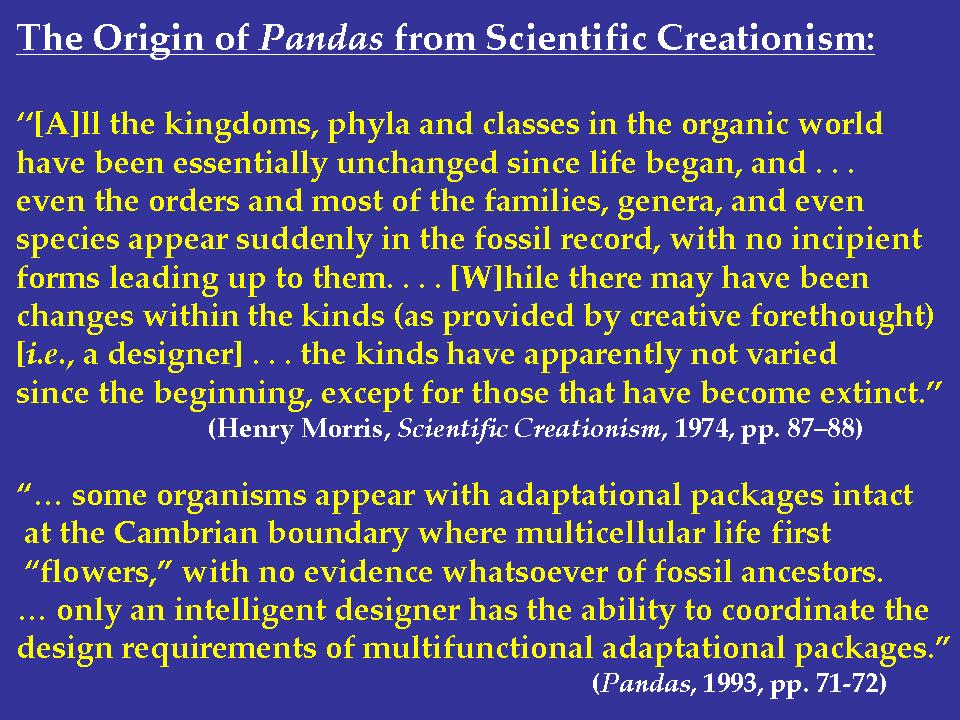 |
| Slide 27: Henry Morris, the founder of scientific creationism and co-founder of the Institute for Creation Research, made the same argument. |
| (Right-click to download pdf.) |
Q. And that's what Henry Morris said?
A. That's what Henry Morris said as a scientific creationist. This language is, I think, identical to what you see in Pandas. And, again, the statement from Pandas that I just read is below that.
Q. And that's from Page 71 and 72 of Pandas?
A. Yes.
Q. And is that accurate?
A. Is it an accurate representation of science?
Q. Yes.
A. I believe it's a little more complex than that. The next slide is another quotation from Duane Gish, who we've seen before as the vice president for the Institute for Creation Research. Duane Gish is talking about the Cambrian geological strata, a sudden great outburst of fossils, and he says that what is found in rocks supposedly older than the Cambrian, that is, in the so-called pre-Cambrian rocks, he says not a single indisputable fossil, unquote. This is very reminiscent of the language we've just seen in Pandas where they say there aren't any ancestors.
And if I could show the next slide. This quotation, also from Pandas, implies quite directly that there are no chains of fossils leading from lower organisms to higher ones. They stress that we can only accept evolution if we assume that only natural causes were at work to explain these things.
But then they say there's another possibility that science leaves open to us, and that is that an intelligent cause made fully formed and functional creatures which later left their traces in the rocks. This is as close a definition as I could come to special creation. I don't see how else you could interpret that as the possibility that natural processes could have gotten you from one form to another.
Q. And you are just quoting from Pages 25 and 26 of Pandas?
|
|
A. This is Pages 25-26 of Pandas.
Q. And what is this slide, Professor Padian?
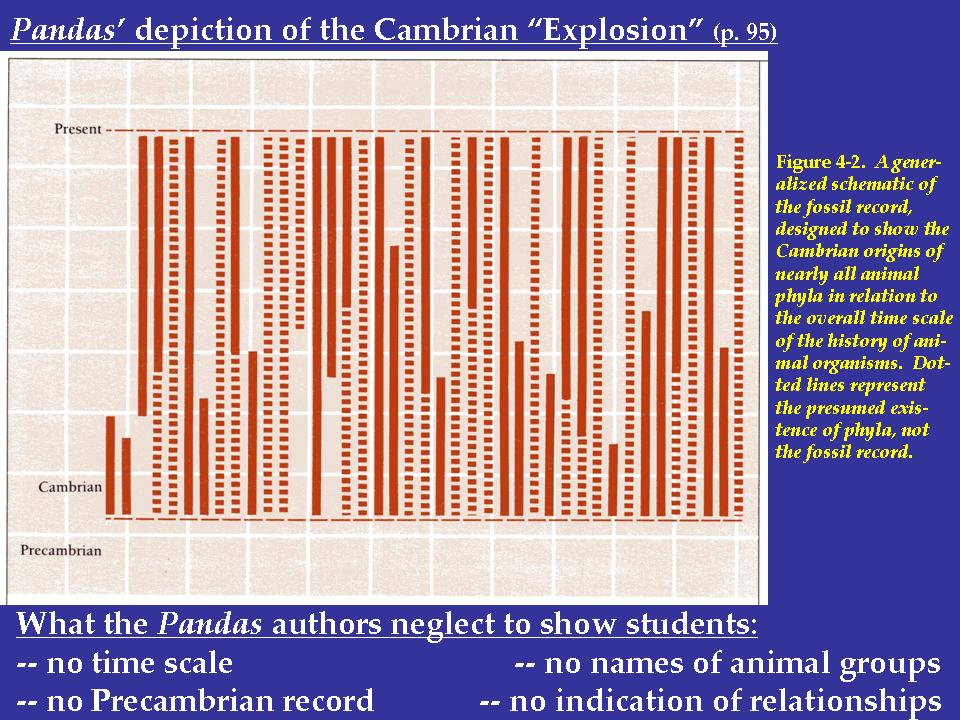 |
| Slide 30: This figure from Pandas attempts to depict the Cambrian "Explosion," but leaves out crucial data such as the time scale and Precambrian fossils. |
| (Right-click to download pdf.) |
|
Credits: Cambrian Explosion figure from Pandas Figure 4-2, p. 95. ©1993 by Foundation for Thought and Ethics, Richardson, TX 75083-0721 |
A. This diagram comes from Page 95 of the second edition of Pandas. It's Figure 4.2. I can best describe it by the caption provided, their own caption, which says, This is a generalized schematic of the fossil record that's designed to show the Cambrian origins of nearly all animal phyla. Dotted lines represent the presumed existence of phyla, not the fossil record.
Again, I'm not sure what this chart is meant to represent, because what students are not being shown here or, indeed, any readers, there's no real time scale on here, so the implication clearly is that the vast majority of these things appeared all at once at the Cambrian/pre-Cambrian boundary. Boom, there they are. And if you look at that line below the Cambrian, where it says pre-Cambrian, there is no record whatsoever. There are no fossils as far as they're concerned.
They say in the caption this is a generalized schematic of the fossil record. They don't tell you which animal groups they're talking about, and they don't give you any idea that there could be any possible relationships among these organisms.
And so the question of whether that's an accurate depiction of the fossil record may be illustrated by this diagram from Kevin Peterson and his colleagues in Paleobiology earlier this year.
Q. I'm sorry, what is that text?
A. Paleobiology is a peer-review journal in our field.
Q. And that's 2005?
A. 2005. What the authors have done here is essentially to turn the rock column on its side, so time is now going from the lower left to the lower right as we move up into the Cambrian early and late. And you can see the boundary here between the Cambrian and the Ediacaran period right before that.
Q. Professor Padian, you have a pointer, a laser pointer there. It might be helpful to show that.
A. Okay. We'll see if it works. I can see that there. Okay, I can kind of see it myself. I'm not sure if that's visible to you.
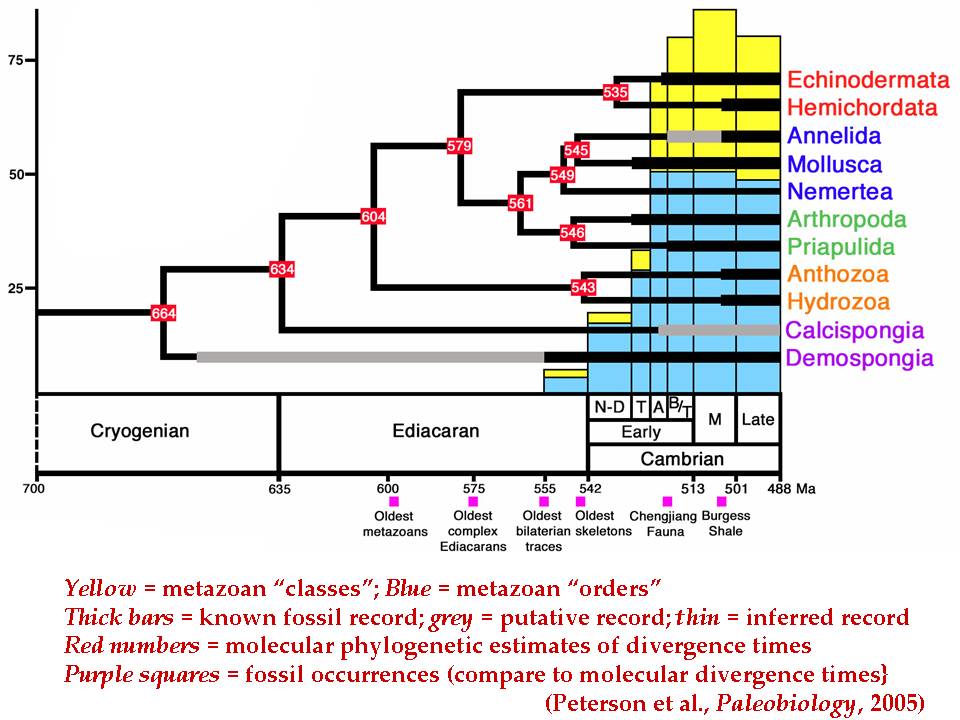 |
| Slide 31: This figure, from a 2005 paper in Paleobiology, shows the data that Pandas ignored, including Precambrian fossils, and the fact that even on a narrow definition based on the appearance of clear bilaterian fossils, the "explosion" took at least 30 million years. The chart also shows that fossil diversity (the blue and yellow bars) increased relatively rapidly, but not all at once. |
| (Right-click to download pdf.) |
|
Credits: Diagram from Figure 2, page 4 of: Peterson, Kevin J.; McPeek, Mark A.; and Evans, David A. D. (2005). "Tempo and mode of early animal evolution: inferences from rocks, Hox, and molecular clocks." Paleobiology 31(2_Suppl), 36-55. (DOI) Copyright 2005, the Paleontological Society. Reproduced with permission. |
THE COURT: We can see it.
THE WITNESS: Okay. The dark bars here, the dark black bars, are the actual fossil records of organisms. The gray bars you see here, these are cases where there are fossils that are supposed to be this old, but they haven't been verified yet.
The lighter colored black bars here are inferred existences that are inferred by a different line of evidence. These red boxes with numbers in them are dates by which scientists estimate when the divergences between -- that is, the separations between lines like this took place, the annelids and the mollusks.
You may ask, how is this done? And the answer is, well, molecular biology looks at the configurations of genes on chromosomes. By lining up the genes, the sequences of the genes are homologized and matched up with each other, and the closest matches and the more derived similarities, the unusual features of evolution, tell us which groups are most related to which.
Now, in the Pandas diagram, all of the names on the right-hand side in these various colors, the names of the major groups of organisms were not given, and there was no indication that we had any idea that these lines could be related to each other.
But, in fact, we had morphological ideas based on fossils, on embryology, and on the shells and tissues of these animals. Molecular biology has now come through with a whole other wealth of data. And this is --
Q. I'm sorry, in the red boxes, those are dates?
A. The red boxes are numbers that are estimated dates of when each of the lines in question would have separated from each other based on how much their molecules differ or resemble each other.
Q. So that would be the age of the fossils?
A. That would be the age of the splits of the lineages. The fossils may not extend back that far. Sometimes they get nearly that far, and sometimes they don't.
The fossils are represented by the little purple boxes below the slide here. There you see the purple boxes at the bottom. And, for example, here at about 600, we have listed the oldest metazoans. Metazoans are multicellular animals with several distinct tissue layers, so they would include actually all the animals here on this slide except the bottom two, and the bottom two, as their names suggest, are sponges.
And it turns out that the molecular date shows a divergence time at about 604 years. The oldest metazoans are dated, estimated in the fossil record at this date, as well.
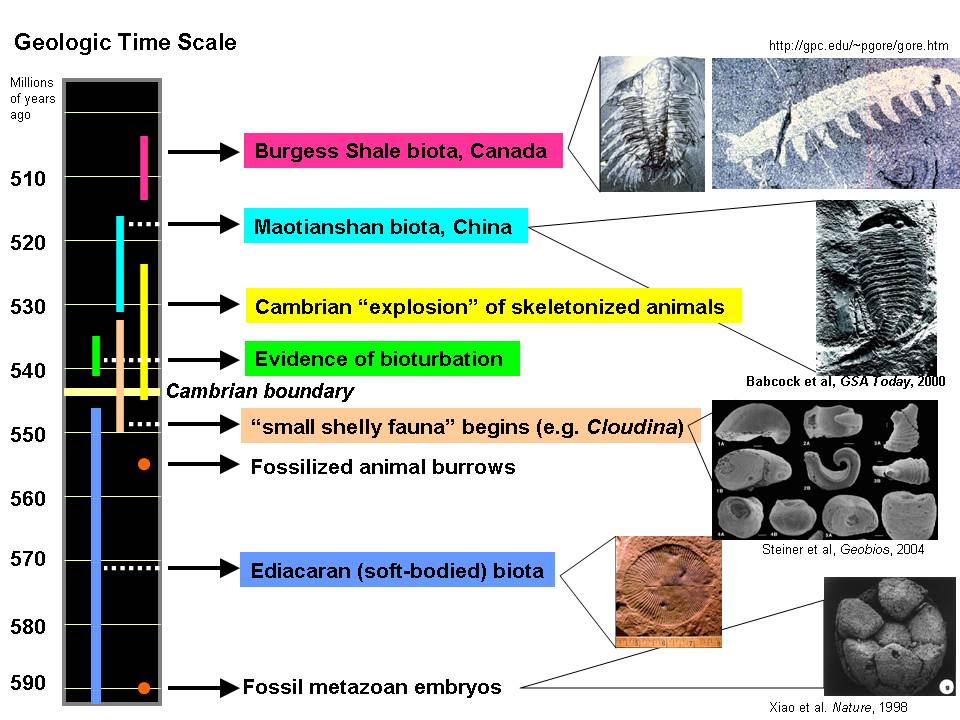 |
| Slide 32: Fossils spanning the late Precambrian and early Cambrian. The early Cambrian was preceded by Ediacaran fossils, the tracks and burrows of wormlike fossils, and the beginning of the "small shelly" fauna, which increases rapidly in diversity in the early Cambrian, mostly before recognizable body fossils (e.g. trilobites) are found. (Note: A 1998 paper in Nature claimed that fossils in the Doushantuo formation in China were early-stage metazoan (animal) embryos (Xiao et al., 1998). This would push fossil evidence of animal life back to perhaps 590 million years ago as shown in the slide. However, this interpretation was questioned by another paper in Nature, published in January 2007, which made a substantial case for the idea that the "embryos" are actually clumps of giant sulphur bacteria (Bailey et al.). This interpretation has some issues as well, since a recent Science paper has claimed that nuclei can be observed in some of the fossils, which would indicate that they are not bacteria (Hagadorn et al. 2006). See Donoghue's (2007) summary in Nature for a semi-technical overview of the issues.) |
| (Right-click to download pdf.) |
|
Credits: Trilobite (Olenoides serratus) and oncychophoran (Aysheaia) reproduced with permission from Pamela Gore's Burgess Shale Page. Primitive arthropod (Fuxianhuia protensa) from Figure 1, p. 4 of: Babcock, Loren E.; Zhang, Wentang; Leslie, Stephen A. (2001). "The Chengjiang Biota: Record of the Early Cambrian Diversification of Life and Clues to Exceptional Preservation of Fossils." GSA Today, 11(2), 4-9. (DOI) Reproduced with permission. Small shellies from: Figure 8, page 272 of: Steiner, M.; Li, G.; Qian, Y.; and Zhu, M. (2004). "Lower Cambrian Small Shelly Fossils of northern Sichuan and southern Shaanxi (China), and their biostratigraphic importance." Geobios, 37(2), 259-275. (DOI) Copyright 2004 Elsevier. Reproduced with permission. Ediacaran 'vendobiont' (Dickinsonia) courtesy of Lisa-Ann Gershwin and the UC Museum of Paleontology (source page). Reproduced with permission. Precambrian embryo from Figure 5g, page 556 of: Xiao, Shuhai; Zhang, Yun; Knoll, Andrew H. (1998). "Three-dimensional preservation of algae and animal embryos in a Neoproterozoic phosphorite." Nature 391(6667), 553-558. (DOI) Reprinted by permission from Macmillan Publishers Ltd., copyright 1998. |
Q. I'm sorry, you said 604 years. That's 604 million years?
A. Million years, yeah. The next slide I think will give an indication of not so much the relationships of these organisms, but of the fact that, indeed, before the so-called Cambrian explosion, there was a lot of evolution.
For example, the Cambrian explosion listed here in yellow -- and I'm not sure if I can make this -- yeah. The Cambrian explosion here of skeletonized animals is seen by scientists as really mostly a preservational artifact, although a lot of evolution is going on. But this is the point in history in which a lot of skeletons begin to be preserved, where before this we're not getting that much.
So the Cambrian explosion here is occurring along this yellow bar from about the Cambrian boundary well up into over 520 million years ago. It's not a single abrupt process but rather it's a process that takes quite a long time.
Even after this so-called Cambrian explosion, there are amazing preservations of fossils, soft-bodied critters that show us remains that we don't find earlier just because they're not preserved. It's very difficult to preserve fossils.
And at this Cambrian boundary where, according to works like Pandas, there are no fossils before that, there are no transitions, there are no possible ancestors, well, one of the things I pointed out before is that, you know, we're not always looking for direct ancestors, we're finding things that have the same features as the organisms that we're trying to understand the relationships of.
And so this pre-Cambrian record is actually quite interesting. We have fossilized animal burrows, and the burrows of these animals go in sort of all sorts of curvy lines and wavy lines that indicate that the animals were proceeding front to back, so they were what we call bilaterian, that is, two-sided things like us, like snails, like worms, like things that are -- have a left and a right side. This is the way they walk.
So even though we didn't have their shells or other remains of them, we have their burrows that could only have been made by complex metazoans that were also bilaterians, that is, two-sided animals. We can even go back --
Q. I'm sorry, and those have been dated before the Cambrian boundary?
A. Oh, yes. Everything that you see at the Cambrian boundary is over 540 million years old, and these are things that are still older than that.
Q. And on the right-hand side of this slide, there are several photographs. Can you tell us what those are?
A. These are photographs of the actual fossils. This is the actual fossil evidence that is preserved. These are taken from, in some cases, peer-reviewed books and journals and in some cases Web sites where the specimens are well known from other sources.
I want to point out that at about 590 million years there's a little dot there where it says "fossil metazoan embryos" at the bottom of the slide, and there's a picture of one of them.
This is a really amazing find because it shows us that some 50 million years before the Cambrian boundary and even longer before some of the Cambrian explosion took place, we have evidence of metazoan embryos. By that we mean the embryos of organisms that belong to one of the groups I showed in the previous slide.
How do we know this? We know this because the embryos themselves have characteristics of metazoans. They are not simply one-celled organisms. And if there are these embryos then, then there are metazoans present. That doesn't mean that there are full-blown trilobites and snails and brachiopods and so forth, but it does mean that there was some kind of metazoan life.
Q. And is this well established in science?
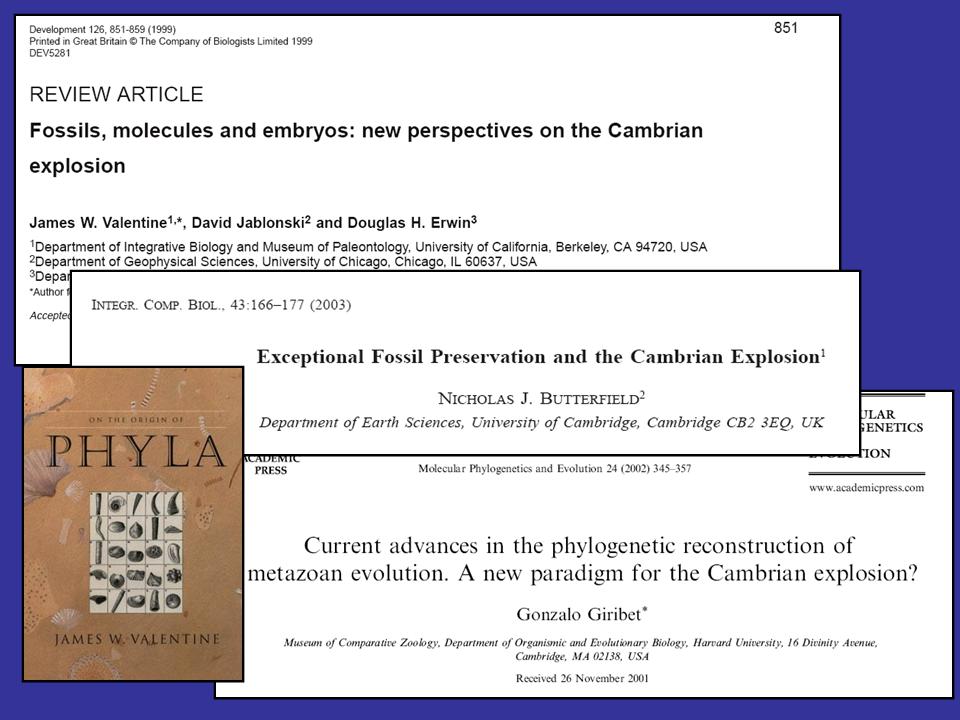 |
| Slide 33: Recently published advances in research on the origin of phyla. |
| (Right-click to download pdf.) |
A. Oh, yes. It's the subject of countless articles and books and papers. And a few of them just are here, along with a recent book by Jim Valentine, who is emeritus professor in my department, member of the National Academy of Science, and one of the four or five most important paleobiologists of the last century, and he treated this problem and all its ramifications in depth.
Q. And if you could just read the titles and the journals from which they came into the record.
A. The top one is, Fossils, Molecules, and Embryos: New Perspectives on the Cambrian Explosion. This comes from a journal called Development.
Now, Development is about developmental biology. Would you expect to see fossils in developmental biology? Well, as I said before, this is the new age of integrative biology. Fossils are really important to all kinds of evolutionary study. They're incredibly indispensable to this sort of work.
A. A paper below that from Integrative and Comparative Biology, which is, again, not a paleontological journal, by Nick Butterfield called, Exceptional Fossil Preservation and the Cambrian Explosion, because we see this as a problem of preservation, not just of quick evolution. Both things are going on here.
And, finally, below in a journal called Molecular Phylogenetics and Evolution, again, not a journal you'd think the average rock hound would be publishing in, but we have Current Advances in the Phylogenetic Reconstruction of Metazoan Evolution, a New Paradigm for the Cambrian Explosion?
And these are all journals and articles that show the integration of molecular techniques with the fossil record, with developmental biology, and this is why it's one of the most exciting areas you'll find.
Q. And so the statements you've read to us a few minutes ago about the way Pandas characterizes the Cambrian boundary and says that there are no fossil ancestors before that boundary, that's not supported by the state of science today?
A. Well, as we can see, there are some metazoans that appear well before the Cambrian boundary. If you are looking for direct ancestors, if you insist on an unbroken stream of intermediate fossils to document a case, I'm afraid that that's going to be difficult to get under any circumstances, but it's also equally impossible for the historical record of humans.
If we had to come up with evidence of every one of our direct linear or collateral ancestors and know everything about them, it would be impossible, yet we don't question the parentage of our friends and neighbors because they can't do that.
III. How vertebrates gained land (the "fish-amphibian" transition)
Q. Now, we talked about the evolution of invertebrates. Can you talk to us about how Pandas portrays the evolution of vertebrates?
|
|
A. Yes, I would like to talk a bit about some of the major transitions that are discussed in Pandas that relate to backboned animals, which are closer to home, as far as we're concerned, because we belong among the backboned vertebrates. The text from Pandas says that fossil types are --
Q. I'm sorry, are you quoting?
A. I'm quoting from Page 22. Fossil types are fully formed and functional when they first appear in the fossil record. For example, we don't find creatures that are partly fish and partly something else leading to today's fish.
They say, Instead, fish have all the characteristics of today's fish from the earliest known fish fossils, reptiles in the record have all the characteristics of present-day reptiles, and so on. This is, again, the abrupt appearance theory, sudden appearance complex adaptive packages, irreducible complexity argument.
Q. So this says fish were formed intact?
A. Yeah, pretty much, yep. Here is their treatment of amphibians.
Q. And this is a slide from Page 104 of Pandas?
A. Page 104, yes. They say at the upper left column, Darwinists believe that the first amphibians evolved from early fish. "Darwinists believe," that's problematic language. It suggests to students that these are just matters of faith without any evidence. And for myself, I'd prefer to reserve matters of belief and faith for things that are not tested empirically.
The Pandas authors say in the next paragraph that if Crossopterygians, by which they mean the fish-like things, really did evolve into amphibians, by which they mean the first animals that came on land, tremendous changes must have taken place. Fins must have been transformed into four limbs, the skull had to change from two parts to a single solid piece. The hipbones had to enlarge and become attached to the backbone. Numerous changes must also have occurred in other soft tissues and so on.
They say in the next paragraph, How many different transitional species were required to bridge the gap? Hundreds even thousands? We don't know, but we do know that no such transitional species have been recovered.
|
|
Q. The next slide, is this a diagram from Pandas?
A. This is a diagram from Pandas of two forms from the fossil record. Eusthenopteron, which they take to be a fish, and Icthyostega, which they take to be an amphibian. Eusthenopteron doesn't look much like any fish you know. Neither does Icthyostega look much like any living amphibian. But in naming them like this, the editors, authors of Pandas are really giving them assignments to different whole groups of organisms and suggesting that the transition between them would be very difficult to achieve.
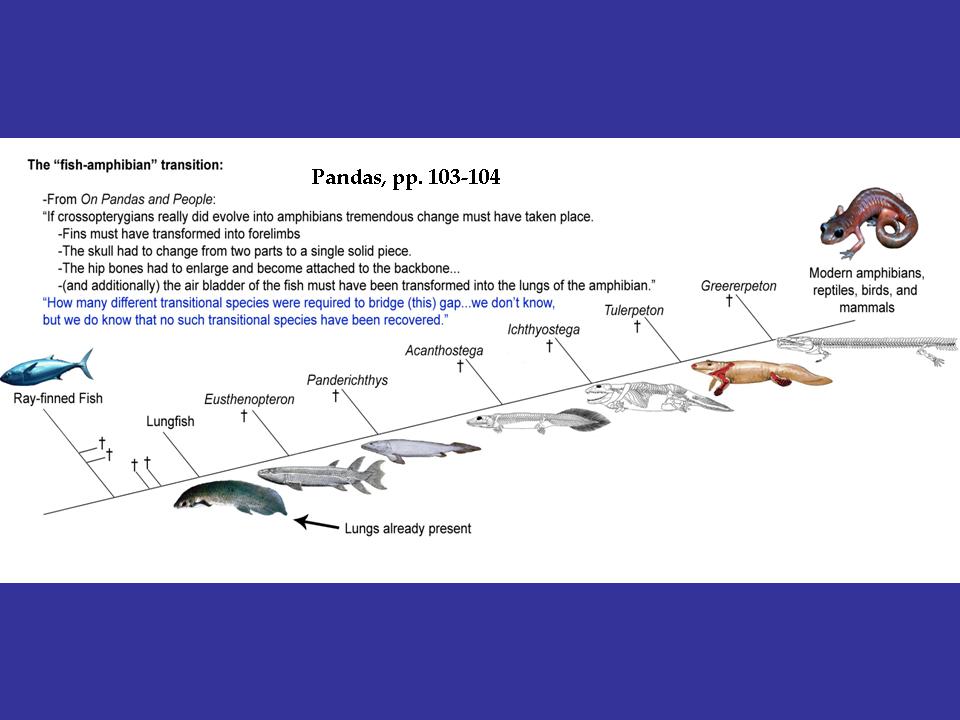 |
| Slide 38: A series of fossils with transitional features exist between "fish" and modern tetrapods. Padian lists a number of the claims Pandas makes (pp. 103-104) and compares them with the fossils. |
| (Right-click to download pdf.) |
|
Credits: Neoceratodus modified from p. 135 of Long, J. (1995). The Rise of Fishes, Johns Hopkins University Press. Original photo credit: Dr. Alex Ritchie, Australian Museum. Panderichthys, Tulerpeton, phylogeny, modified from p. 58 of: Clack, Jennifer A. (2004). "From Fins to Fingers." Science 304(5667), 57-58. (DOI) Art by Emese Kazar -- http://www.emesekazar.com/, reproduced with permission. Acanthostega (2005 reconstruction) from Figure 1c, page 137 of: Ahlberg, Per Erik; Clack, Jennifer A.; Blom, Henning (2005). "The axial skeleton of the Devonian tetrapod Ichthyostega." Nature, 437(7055), 137-140. (DOI) Reprinted by permission from Macmillan Publishers Ltd., copyright 2005. Ichthyostega (2005 reconstruction) from Figure 1a, page 137 of: Ahlberg, Per Erik; Clack, Jennifer A.; Blom, Henning (2005). "The axial skeleton of the Devonian tetrapod Ichthyostega." Nature, 437(7055), 137-140. (DOI) Reprinted by permission from Macmillan Publishers Ltd., copyright 2005. Greererpeton from Figure 1a, p. 77 of: Godfrey, S. J. (1989). "The Postcranial Skeletal Anatomy of the Carboniferous Tetrapod Greererpeton burkemorani Romer, 1969." Philosophical Transactions of the Royal Society of London. Series B, Biological Sciences. 323(1213), 75-133. Reproduced with permission of the Royal Society and Stephen Godfrey. Ensatina salamander photo © 2005 Tom Devitt, U.C. Berkeley Department of Integrative Biology and Museum of Vertebrate Zoology. Reproduced with permission. Thunnus modified from this image at the Monterrey Bay Aquarium. |
Certainly there are differences between these two skeletons. There are differences in the way they're drawn, as well as many features of their specimens that we find in the fossil record. And the next slide --
Q. I'm sorry, and that was from Page 103 of Pandas?
A. Yes. We've prepared some slides that show a bit more accurately the way that scientists understand this fossil record. What we've done here is to take the text from Pandas on Pages 103 and 104, but to illustrate our illustration of some of the major fossil animals that are known that move from aquatic, fish-like critters, up into the first animals that appear on land.
We're including in this Eusthenopteron, which is the second guy from the bottom left, and Icthyostega, which is three more guys up to the right from him, which are the two animals you saw in the last slide in Pandas. Pandas is giving you two animals and inviting you to draw contrasts between them. What we'd like to do is show the evidence that scientists have to show comparisons and to show the transitional features that the Pandas authors say do not exist.
So, for example, the text in the upper left taken again from Pandas insists in blue that no transitional species have been recovered.
Q. Could you read that please, that quote?
A. It says, How many different transitional species were required to bridge this gap? We don't know, but we do know that no such transitional species have been recovered.
Now, here, of course, we're going to focus on what are you defining as a transitional species? Does it have to be a direct ancestor, does it have to be intermediate in all features? Do you have to know that it had the same genetic antecedent composition and therefore could only have been the great, great, great, great, great, great grandfather of the next animal along the way?
That seems like a very difficult standard of evidence to live up to. We can't do that with humans most of the time, and I'd be surprised if we could do it with animals that are 350, 400 million years old.
The next slide looks a lot like the one you just saw. The Pandas authors say in blue that there are two large gaps in the fossil record that we're talking about here. One is between ordinary fish and Crossopterygians, what they would regard as the organisms that are closest to the land animals, and an even larger second gap between these lobed-finned fish and amphibians, again, the transition to life on land.
This slide just points out where the ray-finned fish are on the left. Ray-finned fish include the 25,000-odd species of fish that live today that we would all think of as fish, that is, tunas, trout, salmon, monkfish, angler fish, catfish. It would not include sharks, for example, which are cartilaginous animals. And it doesn't include any of the animals you see running along the right side of this slide. No one thinks that an animal like a trout directly gave rise to an animal like a frog.
Q. When you say "no one," no one in science?
A. No one in science, but I don't think any creationist obviously wouldn't think so, either. But scientists don't think this. Rather, we find that ray-finned fishes, this great radiation of 25,000 species today reaching back into the remote past, have a long history that's independent from the other watery creatures, so to speak. And, in fact, their histories are quite separate.
The two little crosses below the ray-finned fish and the two little crosses to the left of the lungfish are representations of two pairs of fossil species are that listed on the right-hand side. We call them stem taxa because they are ancient relatives. Their names here, just for a couple of examples, Moythomasia and Howqualepis. The names are really unimportant. And on the other side, Psarolepis and Achoania. Again, the names are unimportant.
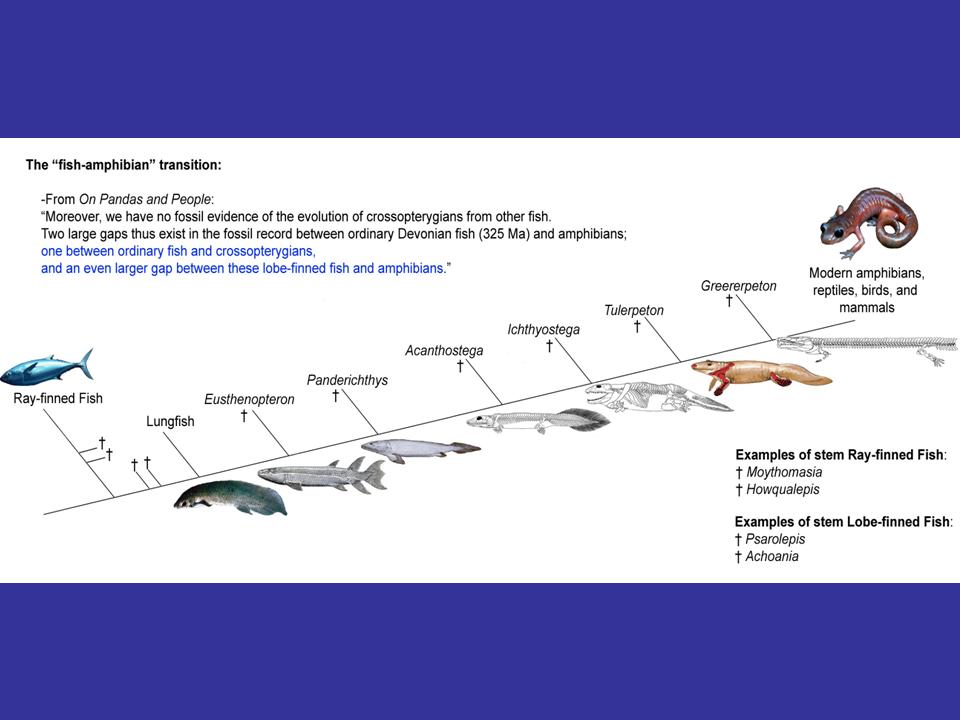 |
| Slide 39: Pandas' claim about "two large gaps" in the fossil record of the fish-amphibian transition, one on each side of the crossopterygian Eusthenopteron, is challenged. Panderichthys and Acanthostega fill in the gap on the tetrapod side (they were joined by Tiktaalik in 2006), and fossils in the stem groups of both lobe-finned and ray-finned fishes fill in the gap to "ordinary fish." |
| (Right-click to download pdf.) |
But it just goes to show you that we have extinct relatives outside the lungfish. We have extinct relatives outside the ray-finned fishes that indicate that the ray-fins are not directly ancestral to the lungfish and all the other animals on the right side. They are rather a separate evolutionary branch, and they have been since way back in the Devonian, 400 or so million years ago.
The next slide talks a bit about another transition here where the Pandas authors note that fins must have transformed into four limbs, which is certainly fair enough, but they say that no such transitional species have been recovered.
Well, again, here is this cladogram that you see here. And I want to stress, as I did before, that the cladogram in question, that is, the way that we have -- the way that we have developed the relationships of the lungfish, the Eusthenopteron, Panderichthys, and all the other animals on this slide are not just based on a couple of features, they're based on dozens and dozens and dozens of skeletal characters of which we're only going to show a few. But this is backed up by a lot more evidence in peer-reviewed publications that I'll show you at the end of this.
The Pandas authors say that no such transitional species have been recovered, but, in fact, we have indications here, beginning with Eusthenopteron, of a limb that is a very interesting limb with branching bones in it.
Q. I'm sorry, the photograph just below the blue text on Pandas there, what is that?
A. That's a photograph of a limb of Eusthenopteron. And you'll have to excuse me, I'm showing you some Paleozoic road-kill. That's the best way I can describe it. It's pretty ugly. But I wanted to show you the actual fossils so you could see that we have them and then to show you next to that a drawing of what these bones actually are.
This doesn't look much like an arm of any animal today, but scientists have been able to compare the elements, which we've put here in the same colors, by the process of homology, which I'll talk to you about later. And there really is no dispute about the fact that these are, in fact, the precursors of limbs that we see in animals today, the same kinds of structures, the humerus here in yellow, the radius, and ulna, which are, I guess, in green, and then some of the features that become parts of the hand and the other digits in a darker color there.
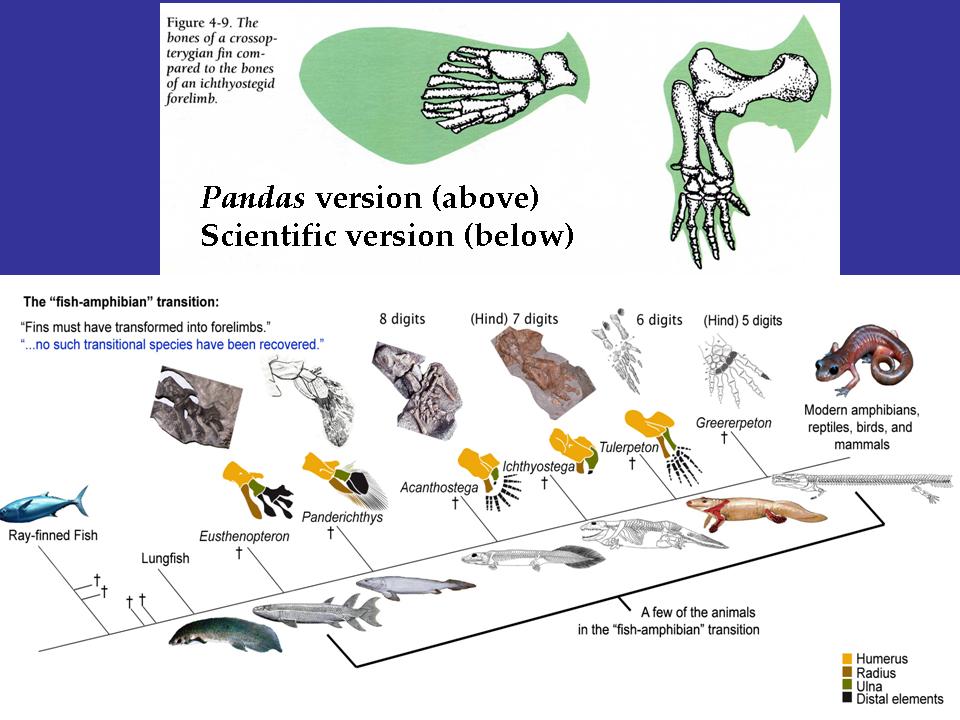 |
| Slide 40: The fossils show transitional features specifically in the limbs, where Pandas' figure 4-9 claims there is a gap. |
| (Right-click to download pdf.) |
|
Credits: Phylogeny, forelimbs, Panderichthys, Tulerpeton modified from p. 58 of: Clack, Jennifer A. (2004). "From Fins to Fingers." Science 304(5667), 57-58. (DOI) Art by Emese Kazar -- http://www.emesekazar.com/, reproduced with permission. Fin/forelimb figure from Pandas Figure 4-9, p. 104. ©1993 by Foundation for Thought and Ethics, Richardson, TX 75083-0721 Greererpeton forelimb from Figure 26b, p. 118 of: Godfrey, S. J. (1989). "The Postcranial Skeletal Anatomy of the Carboniferous Tetrapod Greererpeton burkemorani Romer, 1969." Philosophical Transactions of the Royal Society of London. Series B, Biological Sciences. 323(1213), 75-133. Reproduced with permission of the Royal Society and Stephen Godfrey. |
You can also see that in the course of evolution, animals that begin having eight digits, such as Acanthostega here, reduce to seven digits, to six digits, and to five digits. I don't know how we could find anything more in the way of transitional forms or features unless we went to six and three-quarters or five and a half digits. But, I mean, that may be as good as we'll get in the fossil record in terms of a transition.
So we do have a very clear change, not just in the reductions of digits, but you'll also notice that they look a lot more digital-like the closer you get to the animals that we recognize as living amphibians and so forth.
In contrast, above, when Pandas teaches this to students, it gives them two animals and invites them to draw contrasts. It essentially does not identify any of the bones, does not indicate that you could have any identification between those two bones, places them in different positions, reconstructs an outline for them that may not be unreasonable, but it's certainly in a different orientation.
And its function, the cumulative effect is really to sort of confuse students, and certainly I'm confused looking at it about what I'm supposed to take out of a diagram like this, except the fact that, boy, these are different, and I don't see how we could get from one way to the other. It would have been so much nicer if they had used a diagram like the one at the bottom or acknowledged that we did at least have some transitional features that we could discuss.
Q. And that's Figure 4.9 from Pandas at the top of the slide?
A. That is Figure 4.9. The next slide is another feature. The Pandas authors, as noted before, said the skull had to change from two parts to a single solid piece, but, again, no such transitional species have been recovered.
Q. And, I'm sorry, that's what Pandas authors say?
A. That's what Pandas says, yeah. But as you can see, on this slide we can go easily from two mobile parts to two immobile parts to two parts that are fused and lack a ventral gap, that is, a one-part skull, to all the remaining vertebrates which have a one-part skull. This is a perfectly reasonable transition, morphologically and physically, and it's difficult to see how you could become any more transitional than this.
Q. So these are transitional fossil forms that have --
A. These are drawings of actual specimens and reconstructions of them from the scientific literature.
The next slide I think will indicate that although the Pandas authors say that the hipbones had to enlarge and become attached to the backbone, no such transitional species have been recovered, according to the Pandas authors.
|
|
But we can see, moving from Eusthenopteron up through Acanthostega and Icthyostega, that, in fact, you can go from small, unattached hind limbs and hipbones to become somewhat larger as you can see in Acanthostega and attached to the backbone by what we call a sacral rib. Our sacroiliac is the human equivalent of that.
And as you can see in Icthyostega and other animals, it gets even larger, expanded and attached to the backbone as these animals begin to use their limbs more in support of the skeleton. And as they come out on land, this will be even more important, as it is, of course, in the living animals which -- almost all of which have at least two sacral ribs attaching to their backbones.
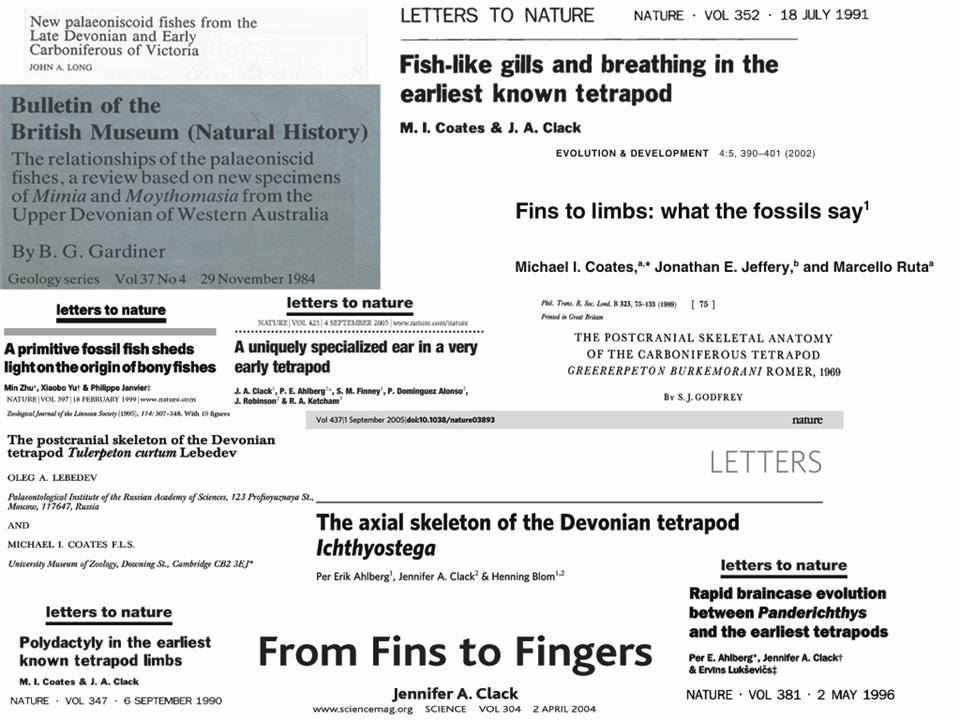 |
| Slide 43: A number of the important papers published on the fish-amphibian transition. |
| (Right-click to download pdf.) |
So I think the next slide is just a depiction of some of the references from the scientific peer-reviewed literature from which the slides I've just shown you have given us the information.
Q. Could you just maybe read a couple of the titles into the record, please?
A. Yes. Fins to Limbs, What the Fossils Say, that appeared in Evolution & Development. Again, you can see where paleontology and developmental biology are seeing a great cooperation and a great number of new insights. From Fins to Fingers, again, a paper published in Science by Jenny Clack, who is a paleontologist at Cambridge. Fish-Like Gills and Breathing in the Earliest Known Tetrapod. So we can actually find fossil evidence even of some soft tissues which tell us a bit about these sorts of things. And I'd like to point out that these works are published in Nature, in Science, in the Bulletin of the British Museum of Natural History, and in the Philosophical Transactions of the Royal Society of London, among other publications.
Q. Dr. Padian, I note that some of these articles appear to be pretty old, for instance, Fins to Limbs appears to have been published in 1969, Bulletin of the British Museum is 1984. These were published before Pandas was written.
A. Yes.
Q. So the fact that there were, in fact, transitional fossils is something that was known to scientists at the time Pandas was being written and was published?
A. Yes. There were many fossils that had transitional features that were available in the scientific literature, as scientists understood them. And so for whatever reason, these were not included by the authors of Pandas. Perhaps they didn't accept it as evidence.
Q. And do you know why in Pandas they would misrepresent, it seems, or not accurately portray the state of scientific knowledge at the time?
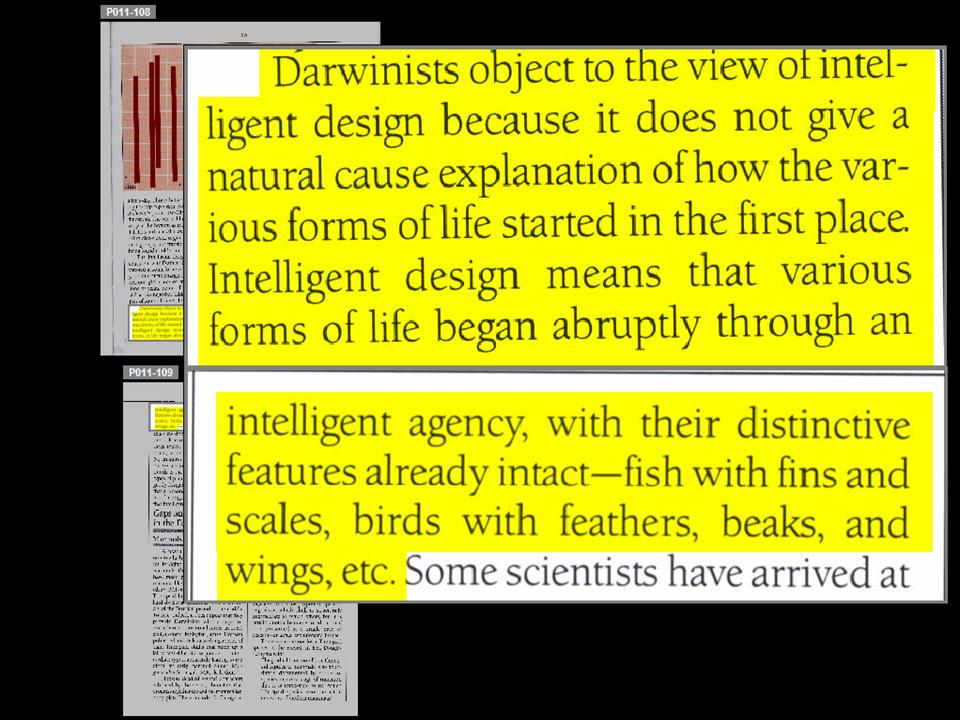 |
| Slide 44: The famous quote from Pandas, pp. 99-100, which said that intelligent design "means that various forms of life began abruptly," including "birds with feathers, beaks, and wings," which Padian will cover in the next section. This quote also explicitly contrasts ID with "natural cause" explanations |
| (Right-click to download pdf.) |
A. Well, the Pandas book, as noted, promotes the view of intelligent design, which they state here means that various forms of life began abruptly through an intelligent agency with their distinctive features already intact, fish with fins and scales, birds with feathers, beaks, and wings, et cetera. I believe this is from maybe Page 99.
Q. That's right. And what you've just shown us is an evolutionary pathway?
A. Well, this is sort of worrisome, because scientists would interpret this as an evolutionary pathway, and intelligent design seems to be excluding the possibility that you can actually get those pathways. Now, we should note that as you pointed out, some of those publications I just showed were available when Pandas was written and some of them appeared afterward.
But it worries me that students would be told that they have to make a conclusion in advance of all the evidence that you can't get from A to B, essentially, by natural means. This quotation from Pandas says, Should we close our minds to the possibility that the various types of plants and animals were intelligently designed? This alternative suggests that a reasonable natural cause explanation for origins may never be found and that intelligent design best fits the data.
And so the question I would have is, what is a kid supposed to think when you tell him that you can't get from Point A to Point B and then evidence is uncovered that shows that, well, in fact, it looks pretty conceivable you can get from Point A to Point B and we're not making up this stuff.
Is a student supposed to say, well, gee, I guess there's no designer? Or is the student supposed to say, well, I guess the methods of intelligent design are really not very good? Or is he supposed to conclude something else? The intelligent design proponents provide no guidance on this.
Q. So when Pandas asserts that fish must have been created abruptly intact with fins and scales, really science has refuted that proposition?
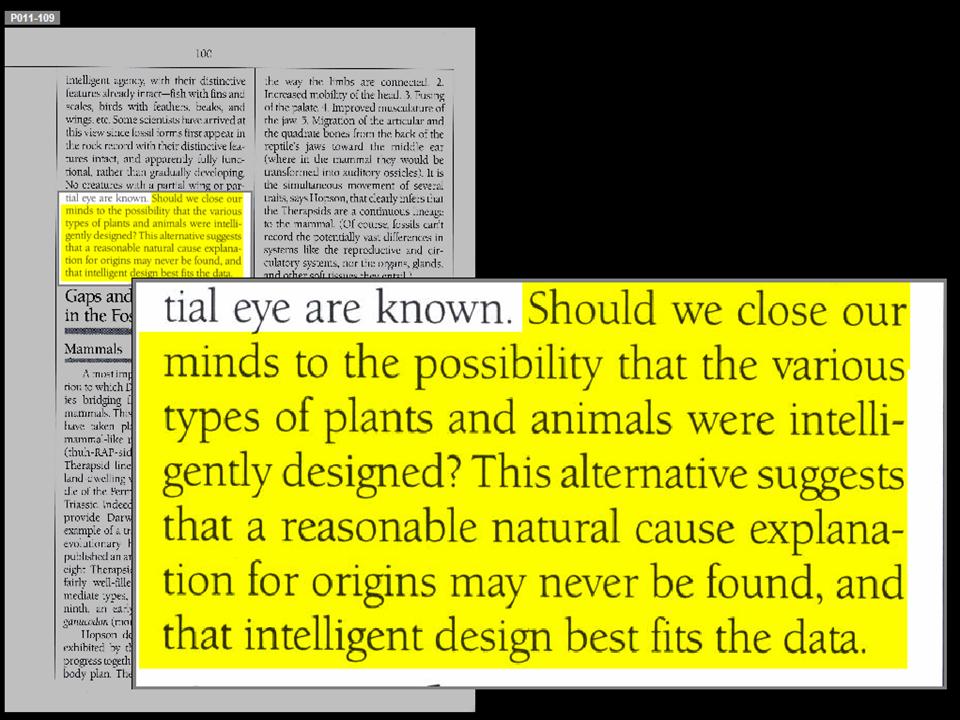 |
| Slide 45: Again on p. 100, Pandas contrasts ID with natural causes, saying that ID "suggests that a reasonable natural cause explanation for origins may never be found." |
| (Right-click to download pdf.) |
A. Yes.
Q. And in the passage which I think virtually every expert witness has focused on in this trial, Page 99 to 100, when they talk about fish being formed abruptly and the other animal that's mentioned there is birds with wings, feathers, and beaks already intact, can you talk to us about whether or not there is an evolutionary pathway, natural explanation for the evolution of birds?
IV. The Origin of Birds
A. Well, I'd be delighted to, if I can look at the next slide. As it turns out, when I went to graduate school, my advisor there, John Ostrom, is the person who actually established the origin of birds from carnivorous dinosaurs. And this became very well accepted over the next several years. We are now 30 years on into that, and it is one of the great achievements of 20th Century paleontology and that kind of science.
And I did work on this myself in the course of 30 years of research, the origin of birds and the origin of flight and of feathers. And so I'd like to show a little bit about what science has understood about this.
The next slide, I believe, gives you two quotes from Pandas, along with a picture of Archaeopteryx, which is the first known bird. It's about 150 million years old. It comes from Germany. It's a beautiful fossil. This is the Berlin specimen. It's known from a number of specimens, seven or eight now.
And as you can see, it's got beautiful wings, feathers, look very modern in their appearance, and yet Archaeopteryx has a long bony tail, its skull still has teeth, it's got various configurations of bones that we don't find in birds today. Many of the bones of its hand and foot are not fused like the bones of living birds. And so it's been known since its discovery in the 1860s, the time of the Civil War, right after Darwin published the Origin of Species, that scientists have accepted this as an animal that shows a lot of intermediate characteristics between birds and other animals, particularly certain kinds of reptiles.
Q. And what does Pandas say about this?
A. Well, Pandas says that there is no gradual series of fossils that lead from fish to amphibians or from reptiles to birds, rather these animals are fully formed.
Q. And you were quoting from Page 106 of Pandas?
|
|
A. 106, yeah. And that's one problem that they come up with. And a second problem that they talk about on Page 22 is that -- is their bemoaning the lack of fossils that show scales developing the property of feathers. They say, then we would have more to go on, but the fossil record gives no evidence for such changes.
I've picked out these two quotes because I want to emphasize that in the first case, there was very good evidence for the evolution of birds from dinosaurs when they wrote Pandas. And in the second case, they were right at the time, we did not have very many fossils that showed anything about the origin of feathers.
But in the past decade, we've had a bunch of remarkable fossils that have. And so this raises the question again of, if you tell children that you can't get there from here and then evidence is found, what are you going to do?
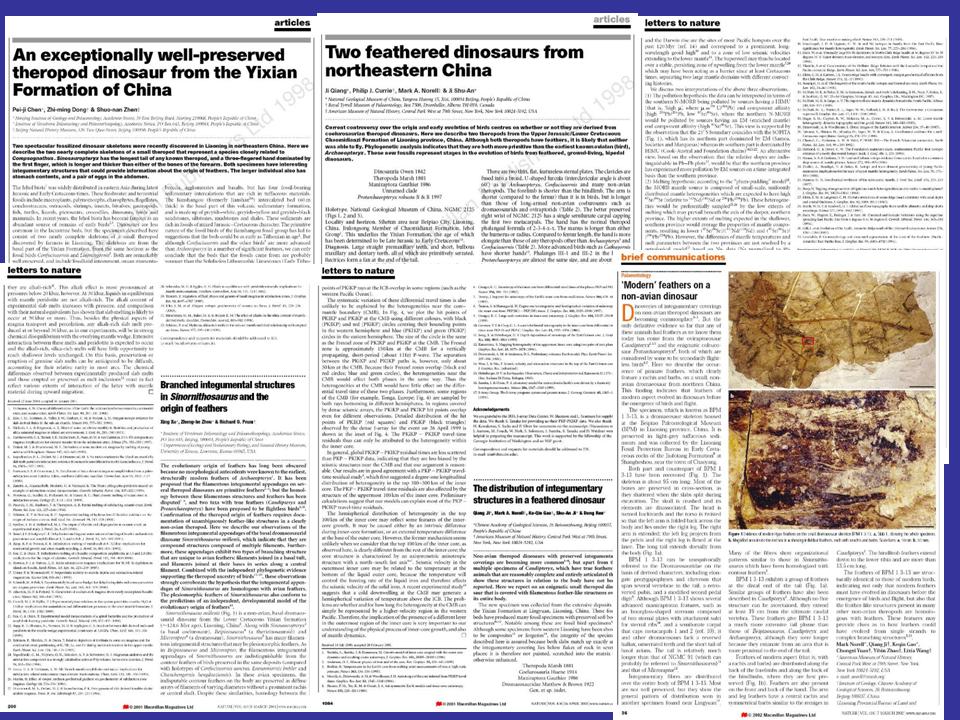 |
| Slide 48: A number of recent discoveries of fossil dinosaurs -- with feathers -- published in Nature in the last ten years. |
| (Right-click to download pdf.) |
The next slide, I believe, talks about some of the -- this is really just a montage of a few, I mean, it's just a very few of the papers about feathered dinosaurs, dinosaurs that are not birds, they didn't fly, but they had various kinds of very rudimentary feathers.
And these have been discovered in a remarkable deposit in Northeastern China, the first one in 1996, so this was after Pandas was written. And so we wouldn't expect those authors to know anything about these discoveries, but it just goes to show that there are some really interesting things that crop up.
Q. And could you just read into the record the titles of some of these?
A. An Exceptionally Well-Preserved Theropod Dinosaur from the Yixian Formation of China. This is a dinosaur with feathers. The next one is Two Feathered Dinosaurs from Northeastern China. Another one here is Branched Integumental Structures in Sinornithosaurus and the Origin of Feathers.
Q. In what type of journals were these published in?
A. These happen to be taken all from the journal Nature, which is one of those two magazines that I noted that all scientists are going to read every week. They're the most prestigious journals to publish in.
Q. And what you're going to show us now about the evolution of feathers is taken based on these peer-reviewed --
A. These and many others, yes. In the next series of slides, if I may, I'd like to show you three things going on at once, because I want to tell you that this is not simply a matter of speculation or of isolated observation and inference, that this comes from independent lines of evidence, not just the fossil record.
What I've done in this series of slides is to take, on the left, one of those hat rack cladograms that show you the relationships of organisms, and again I've turned it on its side. So you can see that Archaeopteryx and modern birds are on the bottom, and that successively the groups above them are various dinosaur groups that are closely related to them.
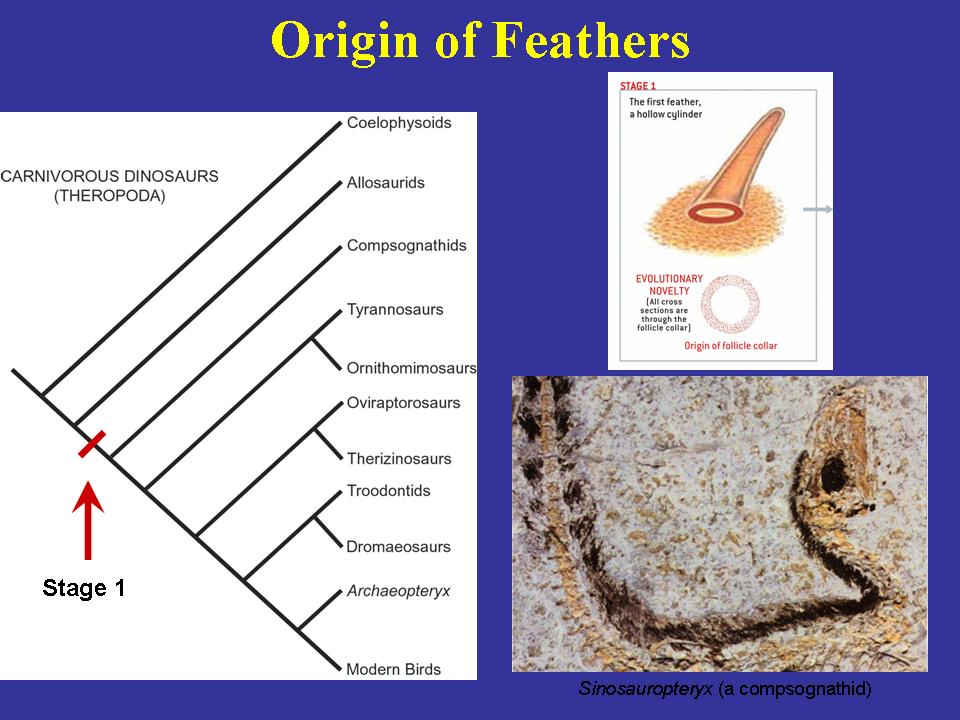 |
| Slide 49: Padian will show a number of feathered dinosaur fossils, showing where cladistic analysis places them in the phylogeny. The phylogeny allows the ancestral states (the stages, marked in red on the phylogeny) to be reconstructed. Here, a compsognathid fossil (Sinosauropteryx) with hairlike protofeathers down its back. This is exactly what Pandas demanded, a fossil "developing the properties of feathers." |
| (Right-click to download pdf.) |
|
Credits: Feather drawing by Patricia J. Wynne. From pp. 90-91 of: Prum, R. and Brush, A. (2003). "Which Came First, the Feather or the Bird?" Scientific American, 288(3), 84-93. Sinosauropteryx neck/head/feathers from Figure 2a, page 148 of: Chen, Pei-Ji; Dong, Zhi-Ming; Zhen, Shuo-Nan (1998). "An exceptionally well-preserved theropod dinosaur from the Yixian Formation of China." Nature, 391(6663), 147-152. (DOI) Reprinted by permission from Macmillan Publishers Ltd., copyright 1998. |
I want to stress that this scheme of relationships, again, is based on dozens and dozens of characteristics that are not controversial to any extent in the scientific community, and whereas we do have uncertainties about some of the minor relationships among these animals, this is the scheme that is generally accepted by paleontologists.
On the upper right, I want to show you a series of pictures that were taken from an article in Scientific American that reflects the work of Rick Prum at Yale and Alan Brush and Scott Williamson and their coauthors on the development of feathers, that is, how feathers develop in living birds.
And the reason for doing this is to couple this with a series of slides I'm going to show you on the bottom, which are of fossils of feathered dinosaurs, that is, dinosaurs that are not birds but that have feathers or some structures that are rudimentary feathers.
And what I want to show you is that as we proceed on the left up the tree leading to birds, we will also see that the feathers that are found in these little carnivorous dinosaurs in the lower right are becoming more and more complex and that they are reflecting the complexification of feather structure seen in the series of diagrams in the upper right as feathers develop embryologically.
So we're actually looking at phylogeny or relationships on the left, we're looking at fossils on the right, and we're looking at developmental structures and embryology on the upper left -- upper right, I mean. Fair enough? Okay.
Then in this stage, we see a little animal in the lower right, and that black fuzz that seems to be going along its backbone is recognized as the most basal traces of things that are going to become feathers. And these structures are hair-like. They look like the structures in the upper right. There has been observation suggesting that they are even hollow in their structure. And we find these at that point in the cladogram noted at Stage 1 on the left-hand side.
The next slide should show us Stage 2. Now we've just jumped up a notch in the cladogram. And here we're beginning to find not just these single filamentous features, but also feathers that begin to branch and begin to have different kinds of tufts involved with them. The specimen on the lower right I realize is a road-kill and it's difficult to interpret, but let me see if I can just give you a sense of -- there we go. Down here we have bones of the backbone, tail. And these black and white marks up in here are remnants of these branched, feathery structures that appear in these dinosaurs.
The next slide shows a further complexification of feathers in the next step up on the cladogram toward birds in which we have a gaggle of feathers there in the center. These are just a group of feathers that have, as you might be able to see, a central sort of stalk where you can see all these things gather in the middle. You can see this happening in the early development of a feather in the upper right. And then you see the feather differentiating into veins along a central stalk, just like you see in the next stage of the development of a feather in a bird that lives today.
|
|
||||||||
|
|
The next slide, again, at this stage we also see another kind of feather that is a feather that is organized very well into veins on each side. And these veins are very well organized along the central stalk. In this fossil I've shown you in the middle, you can see perhaps faintly the outline of these black and white structures radiating off along this white stripe, which is the central axis of the feathers.
And so these are several feathers from the tail of one of these animals that are just bunched up right next to each other in one of these fossils. And, again, this is mirrored also in the progress of development from the feather from a single follicle bud up to a complete feather that we'd see today.
The final stages I want to show you as we get closer to birds is a feather in which the veins are asymmetrical, that is, one side of the feather is bigger and the other side is smaller. And this is seen in birds today, but it's also seen in some of the other carnivorous dinosaurs that are close to birds, but not in all of them.
So, again, what we're seeing is as we move up the cladogram towards birds, we go from the simplest filamentous feathers up to more complex structures that are then gathered and around a central stalk that produce veins. These are interlocked by barbs and barbules, and they eventually become the aerodynamic structures that birds use in their wings.
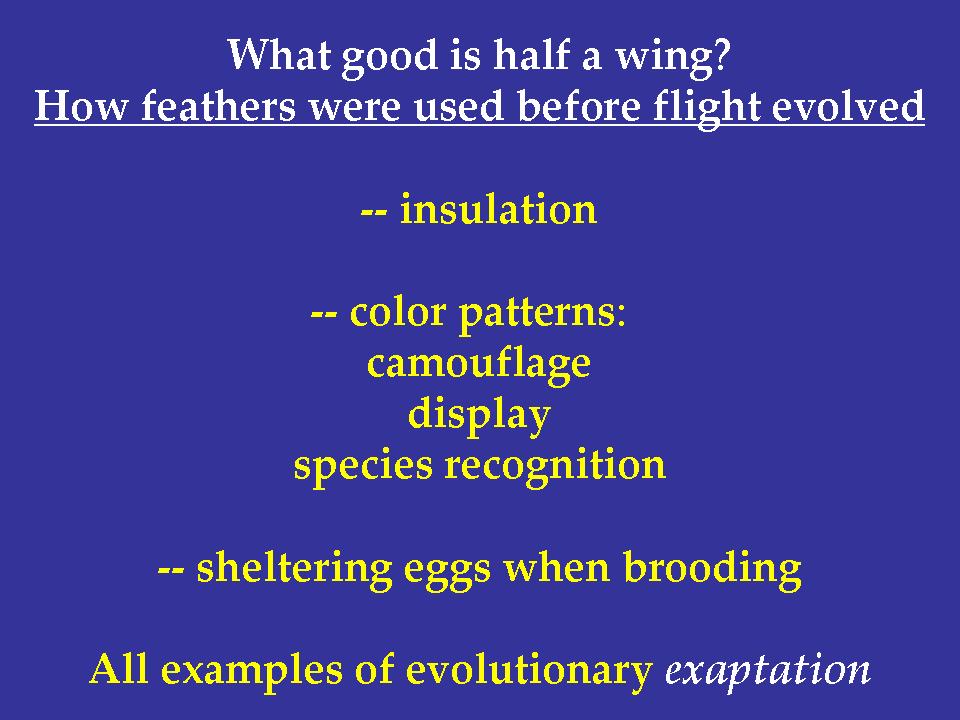 |
| Slide 54: What good is half a wing? Feathers have many known functions besides flight. |
| (Right-click to download pdf.) |
But I'd like to point out, if I can, in the next slide that the obvious question is, what are they doing with these feathers before they're flying? And the evidence that we found in the fossil record in the last ten years indicates beyond any reasonable question that feathers did not evolve for flight. Flight was an afterthought for birds. They somehow acquired that adaptation later on.
What do we know about those first little hairy feathers that we're looking at? Well, one thing we know is, if you put a fur coat on somebody, they're going to stay warmer. And this little covering of dense fibers is going to give you insulation. That tells us something about the metabolic status of these animals even then.
Another thing is, you may have noticed some dark and light color patterns on those feathers. The fossils preserve this. What good are color patterns? Well, on these animals, they could serve as camouflage, as display, or even to help them recognize species.
I'm going to show you another function in a second that indicates that these animals were also using the feathers to shelter the eggs as they brooded their young. And these are all examples of what we call exaptation and evolution. And by that I mean that a structure evolves for one purpose, but it's selected, in turn, to acquire a second purpose, without, of course, losing the first one instantly. It will retain the first one.
And as it develops the second one, because it has the ecological opportunity or the pressure to do so, that second structure, that second function, may become more and more important to the structure, it may be selected to change more to accommodate this new function. And this is how exaptation works to change one kind of function into another through evolution.
Q. You have at the top there, What good is a half wing? What do you mean by that?
A. Well, if you just -- this is the question that has always been asked of evolutionists. St. George Mivart asked this of Darwin in the 1870s, what good is half a wing?
And the answer is, well, if you don't think of it as something you have to use to fly with, you can find out other functions if you just let the evidence tell you. And these are some of the lines of evidence. I will briefly show, if I may, a couple of these other functions.
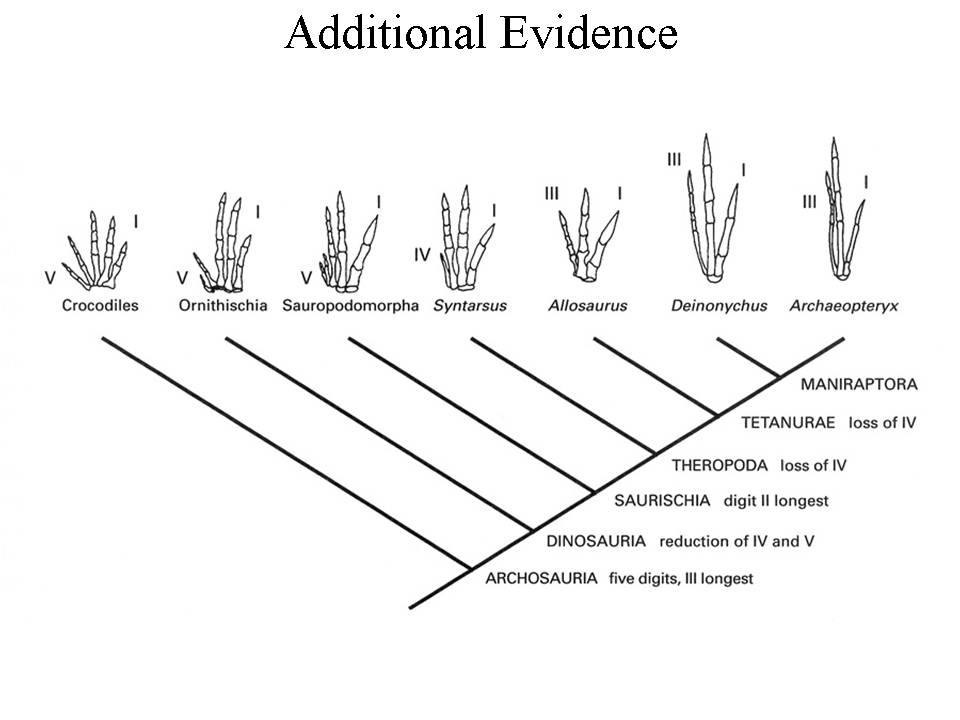 |
| Slide 55a: The pattern of digits in groups sister to birds. Digits were lost progressively -- first V, then IV. |
| (Right-click to download pdf.) |
The next slide provides some additional evidence of the other problem we talked about, not so much feathers, but the question of the evolution of birds. We have tremendous evidence on this, but one line of evidence comes from the hand itself. If you look at the hand of crocodiles, they have got five fingers. If you go all the way over to the left, you see Archaeopteryx, the first bird, that has only three.
Well, again, here's a cladogram of relationship diagrams of how these organisms are related based on many, many characteristics. And as we move up from the crocodiles through the various kinds of dinosaurs, we see that the fourth and the fifth finger, first the fifth and then the fourth, become reduced and finally lost, until, when you get up to animals like Allosaurus, Deinonychus, and Archaeopteryx, they have only three fingers, and those are the first three fingers. The second finger is the longest, and you can see that through time, these fingers and the hand bones become even longer and more gracile.
Those three fingers that you see in Archaeopteryx at the end are still separate fingers, but in birds today, they're fused up. You would know them better as the pointy part of the wing in the Kentucky fried chicken.
So if you were to dissect your Kentucky fried chicken, which I don't recommend, but I can tell you about turkeys and Thanksgiving, which is a lot of fun, you will find that you can get to the individual hand bones, we can watch the bird develop, and these are individual bones that later become fused. And this is because the bird is no longer using its hand for anything except flight. It's not using its fingers to pick up things or claw or scratch anymore.
And early in the evolution of birds, when they dedicated themselves to flying with the four limbs and very little else, there was no further need to use these fingers for anything, and it made more sense to fuse them into position rather than use muscles to hold them there. And this is the evidence that we have of how these organs evolve.
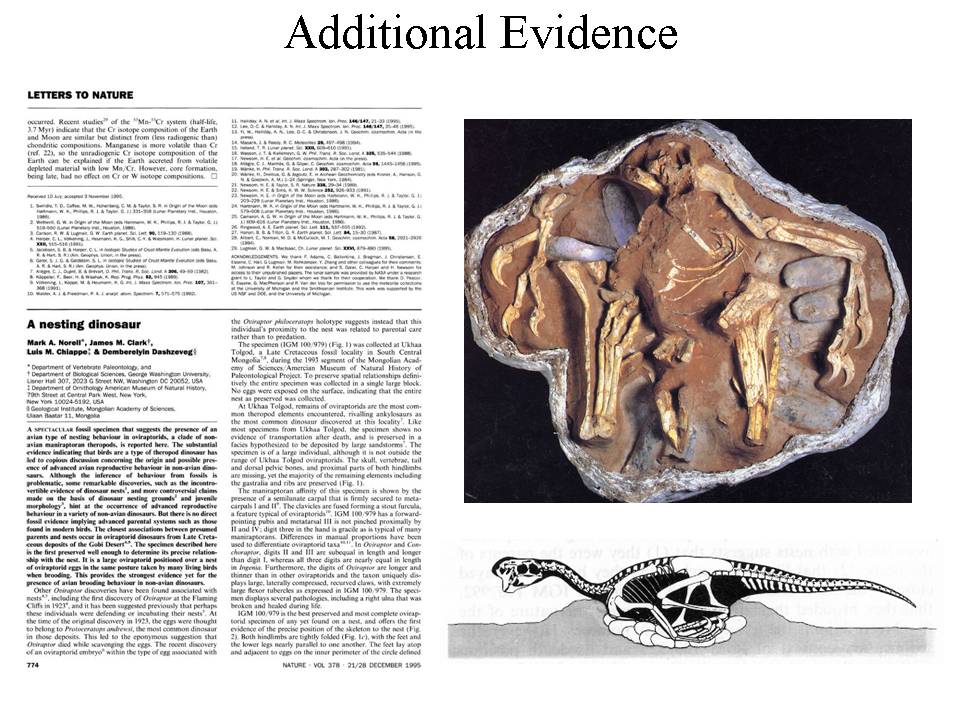 |
| Slide 55b: The fossil record preserves not only bones -- sometimes it even preserves behavior. This 1995 Nature paper shows an Oviraptor sitting on a nest. |
| (Right-click to download pdf.) |
|
Credits: Oviraptor from Figure 1a and Figure 2, page 775 of: Norell, Mark A.; Clark, James M.; Chiappe, Luis M.; Dashzeveg, Demberelyin (1995). "A nesting dinosaur." Nature, 378(6559), 774-776. (DOI) Reprinted by permission from Macmillan Publishers Ltd., copyright 1995. |
The next slide, I believe, will give us one more thing about feathers and behavior, too. This is a dinosaur, an extraordinary ostrich dinosaur relative. It's an Oviraptor dinosaur. The name isn't important. But one thing you can see about this specimen, which is very beautiful, it comes from the Cretaceous of Mongolia, is that in the photograph at the top, I'm going to show you, here is the right arm, here is the humerus, the bones of the forearm, and three clawed fingers of the right hand. Moving over to the other side, the arm comes out here, and here are the three clawed fingers of the left hand.
These white objects you see in this specimen are eggs. And here is the hind limb and the foot on the left side. Here is the hind limb and foot of the right side. Here is part of the tail. And the animal's rib cage is in here. There are more eggs underneath this animal. This critter was brooding its eggs in exactly the same position that hens brood their eggs today.
Furthermore -- well, one thing to draw from this is that some behaviors that we associate with birds did not evolve with birds, they actually apparently were already present in the dinosaurian relatives of birds, and they simply were passed on to birds as they evolved.
But the other thing this shows is a funny thing. The fingers, you'll notice, are spread so as to cover the eggs. And in the fossil relatives of this particular dinosaur, not this specimen because they aren't preserved, but we have feathers in other Oviraptor dinosaurs that come off the fingers that are long and gracile. And if this particular dinosaur had preserved its feathers, it would have been using them to shelter the eggs as it brooded them. This is evidence of behavior, not just of structure, that we can find very anciently in the fossil record.
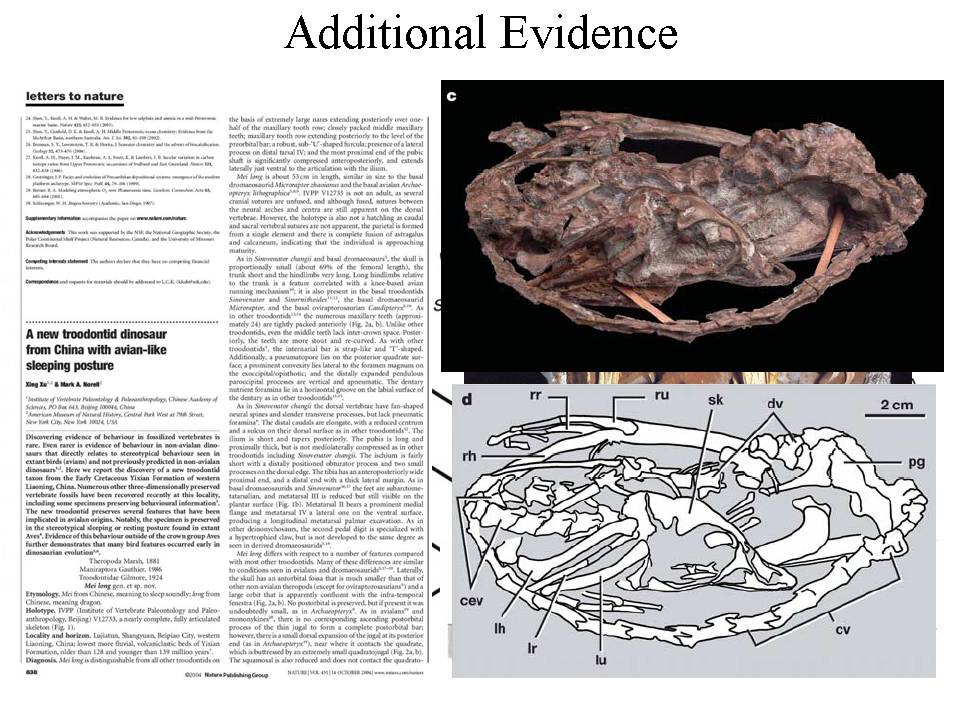 |
| Slide 55c: Another example of behavior preserved in the fossil record. This 2004 Nature paper shows a small troodontid dinosaur, Mei long, displaying "the earliest recorded occurrence of the stereotypical sleeping or resting behaviour found in living birds." The head is tucked under the wing. |
| (Right-click to download pdf.) |
|
Credits: Mei long from Figure 1c-1d, page 839 of: Xu, Xing; Norell, Mark A. (2004). "A new troodontid dinosaur from China with avian-like sleeping posture." Nature, 431(7010), 838-841. (DOI) Reprinted by permission from Macmillan Publishers Ltd., copyright 2004. |
The next slide, I believe, shows an equally extraordinary find. And this is of a dinosaur, not a bird. He looks a lot like a bird, but he's in a sleeping position. And what is unusual about this critter is that here's its skull here with its big eye right here, and here's its little beak and its tail, bones like this. Up here are the arm bones of the left arm. And what this animal is doing -- his tail end is back this way and his front end is really to the left, but he's tucked his head and neck underneath his left arm. In other words, he's sleeping like a bird does. This is not a bird. This is a little carnivorous dinosaur that's close to birds.
So, again, there is remarkable evidence that not just the structures of birds, but the behaviors of birds can sometimes be found in the fossil record and they precede birds. They actually are more general. They apply to the fossil record of many dinosaurs, as well.
Q. And, again, this is all based on peer-reviewed research?
A. The paper you see there is from Nature.
Q. And so do scientists today understand that, in fact, birds evolved and were not created abruptly?
A. In fact, that they evolved from small carnivorous dinosaurs sometime in the middle or late Jurassic period about 150 million years ago.
MR. WALCZAK: You Honor, I know there have been a number of references to food here. I have one more very short topic that I'd like to cover with Professor Padian, and that will be a good place to break.
THE COURT: After that point?
MR. WALCZAK: Yes.
THE COURT: That's fine. I thought we'd go to about no later than 12:15, but if it takes longer than that, that's fine. Let's break at whatever point you think is logical so that we don't break up the testimony unnecessarily.
Q. Professor Padian, you talked about this change of function, and I think you used the term "exaptation."
A. Yes.
Q. Is that a biological concept that's well established?
A. Yes, it is.
Q. And how do intelligent design proponents deal with exaptation?
A. Well, as far as I can tell, they don't really. It's very difficult for them to deal with exaptation because it implies that you can take a structure and change its function to a new function. And the whole purpose of intelligent design is to identify structures and functions that are too complex to have changed naturally from an antecedent state to a new state.
I believe that the evidence that I'm providing here is trying to show that we have, piece by piece, assembly of major adaptations. I believe that we've shown that with the transition of swimming animals up into the animals that came onto land, for example, a very good transition of features step by step by step, and that it isn't like an adaptational package of land animals that had to be assembled abruptly, but rather that structures are changed in their function.
So, for example, the fin of a fish moves up and down and helps it to negotiate the water, that is, to push water, pass it or to steer and do things like that in a medium that's a thousand times denser than air.
How do you get from that to an animal that puts its limbs under its body and stands on this limb? Well, as we've seen, what happens in the evolution of limbs from basic fins is that these bones become stouter and stronger. Their articulations change. They begin to be able to be much more able to support weight, and they change from having a lot of those individual sort of rays that you see in any fish fin to a fewer number of things that are covered by flesh. In fact, these are the fleshy fins that we have, our hands. They're exactly the same structures.
And we saw from the slides that these structures, the numbers of fingers, how they articulate, change in a very step-like pattern, not in an abrupt way at all. So the answer is that intelligent design proponents, this is the last thing they want to hear, because it would indicate to them that there are ways of getting from Point A to Point B when they want to talk about abrupt appearance and irreducible complexity.
MR. WALCZAK: I'd like to end abruptly now so we could get some lunch.
THE COURT: I don't know if there will be a run on chicken. But we'll break here until -- how are you proceeding time-wise?
We could take an abbreviated lunch, take an hour rather than the longer lunch, or we can go to 1:30, which might be a little bit more reasonable. I'll give you a crack at that because you know how much more you have on direct and you want to save time -- I know you don't want to bring this witness back -- you want to save time, reserve time for appropriate cross.
MR. WALCZAK: I'm guessing an hour, maybe a little bit more. We've got mammals, we've got whales.
THE COURT: Mr. Muise, if we stopped at 2:30 or if we gave Mr. Walczak until 2:30, if we reconvened at 1:30, would that give you enough time to cross-examine?
MR. MUISE: 2:30 and stop at 4:00, Your Honor?
THE COURT: Well, no, we'd stop at 4:30-ish. That would give you two full hours. But if you don't think that that's going to be enough, I want to try to regulate what we're doing here.
MR. MUISE: It's always hard to judge, Your Honor, you know, for cross-examination, depending on, you know, how the responses come, obviously.
THE COURT: Well, I'm saying I would hold Mr. Walczak, because I know there's an issue -- this witness has come a great distance. I would hold him to 2:30. You've got to keep it within two. Now, you may not use two, but I'm saying, is that enough? Now, if you want a little over, that's fine. I'm just trying to get a fix on --
MR. MUISE: Let's do an abbreviated lunch since we want to make sure we get done.
THE COURT: Let's take precisely an hour. We'll come back at 1:15. And then why don't you have a conversation during the lunch break about how you want to carve up the afternoon, because I think that's the appropriate thing to do.
So, Mr. Walczak, if you don't go too deeply into the afternoon and not give Mr. Muise enough time, in the interest of not bringing this witness back -- which I think is what you're striving to do. Am I correct?
MR. WALCZAK: That's right, Your Honor.
THE COURT: So as a courtesy, make sure he's got enough time. All right?
MR. WALCZAK: Yes, Your Honor.
THE COURT: We'll be in recess until 1:15.
(A luncheon recess was taken.)
V. Fossil Mammals
THE COURT: Be seated, please. All right, Mr. Walczak, you'll continue with the direct examination.
MR. WALCZAK: Your Honor, one of the things we did not do was formally move Professor Padian's as an expert, and I know that defendants have stipulated to his expertise.
THE COURT: Why don't you put the, I understand that, and I could refer back to this but it's easier for you to do it, state the exact purpose for which his testimony is being offered in the expert realm.
MR. WALCZAK: We would proffer Dr. Kevin Padian as an expert in paleontology, evolutionary biology, integrated biology, and macroevolution.
THE COURT: And then pursuant to the stipulation I assume you have no objections, Mr. Muise, is that correct?
MR. MUISE: That's correct, Your Honor.
THE COURT: All right. Then he's admitted obviously for that purpose nunc pro tunc. So let me ask you before you start your questioning, do you have an agreement as to how long you're going to go in order to reserve --
MR. WALCZAK: Oh, I'm guessing we have an hour to an hour and fifteen. As I told Mr. Muise, if we have to bring Professor Padian back on Monday, then it's not the end of the world and we certainly don't want to cut them short on their cross.
MR. MUISE: And I'll do my best to get it done before the end of the day.
THE COURT: All right. Well, we'll work with that, and you may proceed.
CONTINUED DIRECT BY MR. WALCZAK:
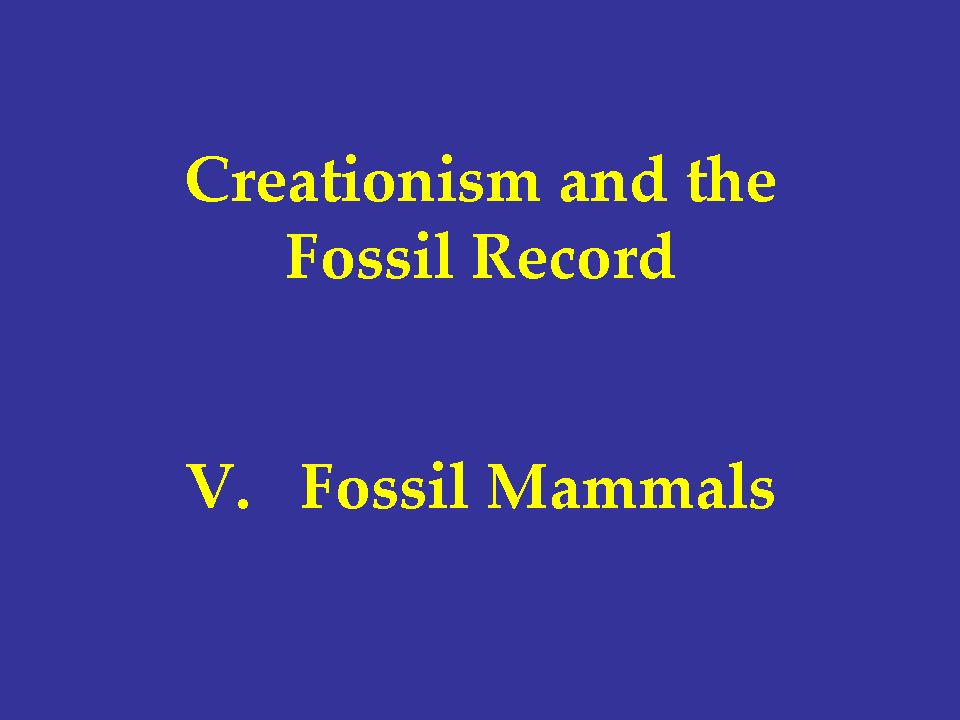 |
| Slide 56: Padian will now address the origin of mammals. In classical taxonomy, the ancestors of mammals were called the "mammal-like reptiles," but so many fossils with transitional features are now known drawing a line between mammals and "reptiles" became arbitrary. In cladistic classifications, mammals and their fossil relatives are called therapsids. |
| (Right-click to download pdf.) |
Q. When we finished we were talking about the evolution of birds, and just one last point I want to make on that before we move on to mammals. On page 99 to 100 of Pandas it makes the statement there that I think has been read previously in this trial that, "Intelligent design means that various forms of life began abruptly through an intelligent agency with their distinctive features already intact," and it says, "birds with feathers, beaks, and wings, etc." Now, in fact does the fossil record show whether birds evolved with those features intact?
A. You have a thing about the birds today. Dinosaur for lunch? To answer your question, it definitely doesn't show that these features evolved all at once intact, but rather in a step-like progression of features.
Q. So did the birds at first have just feathers and then the other features evolved?
A. We saw the simplification, we saw from a very simplified picture of all the feature that evolve in birds, but they start with very simple filamentous hair-like structures that are feathers, but if I had shown all the features of birds evolving we would have seen the wishbone appear very early before birds evolved and become a very boomerang shaped structure well before birds evolved or take flight. So that evolved for completely different purposes anyway, but birds do use the wishbone today as an anchor of some of the flight muscles. That wasn't the case originally for birds. There's just lots of features like that we could go through, sure.
The Evolution of the Ear in Mammals
Q. Let's talk about mammals. One of the examples that's referenced in Pandas is the mammalian ear, inner ear. Could you talk to us about how Pandas discusses the mammalian ear and what science shows about that? And you've prepared a demonstrative for this?
A. I put a couple of slides together about the transition in the evolution of the mammal ear, which is unusual compared to all the other vertebrates. The next slide I think shows a bit about this. This is going to get a little complex anatomically, but I hope it will only hurt for a minute. The bones of the middle ear, mammals have three of them. You might have heard of them as the hammer, the anvil, and the stirrup.
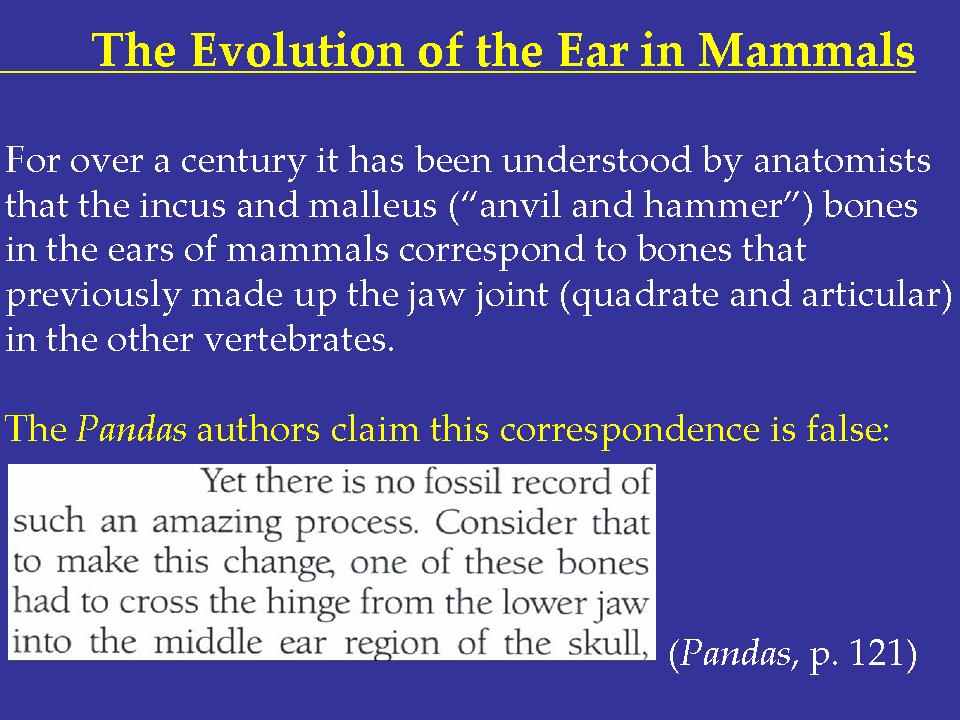 |
| Slide 57: The mammalian middle ear contains three tiny bones: the stapes, the incus, and the malleus (popularly analogized with a stirrup, an anvil, and a hammer). Other vertebrates have only the stapes in middle ear, but anatomical consensus for over 100 years has been that the incus and malleus are homologous to the quadrate and articular, bones found in the jaw of the other vertebrates. Pandas denies that this amazing transition is documented in the fossil record. |
| (Right-click to download pdf.) |
The stirrup is a bone that's always in the ear, but the mammals have this anvil and hammer thing which are just outside that stirrup bone. These anvil and hammer bones actually correspond to bones that previously made up the upper and lower jaw joint in all the other animals, not just reptiles or anything like them, but everybody pretty much. So the Pandas authors claim that to make this correspondence is really stretching it, because they said there's no fossil record of this amazing process.
Consider, that to make this change one of these bones had to cross the hinge from the lower jaw into the middle ear region of the skull. Again this is from Pandas page 121. So they're saying there's no record of this process and it would be an amazing thing to have to change. The next slide shows that there are actually many sources going back several decades that differ, and there are just a few of them there.
The first one was actually an article by Romer, who was the dean of American vertebrate paleontology for half the century, about a cynodont that has an incipient mammalian jaw articulation, and I'll show you what that is in a minute. That comes from the journal Science in 1969. Here's a somewhat later paper by Edgar Allen of Madison, and now it's Chicago, on the evolution of the mammalian middle ear, and then a third one I put there is very recent piece, a little piece in Science by Thomas Marin from Germany and Zhe-Xi Luo, who's curator at the Carnegie museum here in Pittsburgh just a few hours away, one of the great museums in the country, and they are talking about the evolution of these bones in the middle ear something that is uncontroversial as a principle in comparative anatomy of vertebrates in paleontology.
Q. Now, I note that first article I believe was from 1969.
A. Was.
Q. So this isn't a new development?
A. Oh, no. Oh, no. It's been known for decades.
|
|
|||||||
|
|
Q. So what you're going to show us is something that was known 25 years before Pandas was published?
A. Yes, and they discuss it. Sure. The next slide I think gives some detail of what's going on here. Trying to make this as painless as possible, there are essentially two sets of bones that are involved in one animal or another in the hinge between the upper and the lower jaw, and outlined in different colors in the skull on top I think you can see an orange bone and maybe a purplish type bone, and in the lower jaw you can see a red one and a blue one.
Now, this is an animal that is not a mammal. It's an ancient relative of mammals, and the jaw joint in this animal is formed by two bones, that blue one marked by a "Q" in the top jaw and the red one, which is called the articulator, in the lower jaw. So the quadrate and the articular are the two bones that in all other animals except mammals make up the jaw.
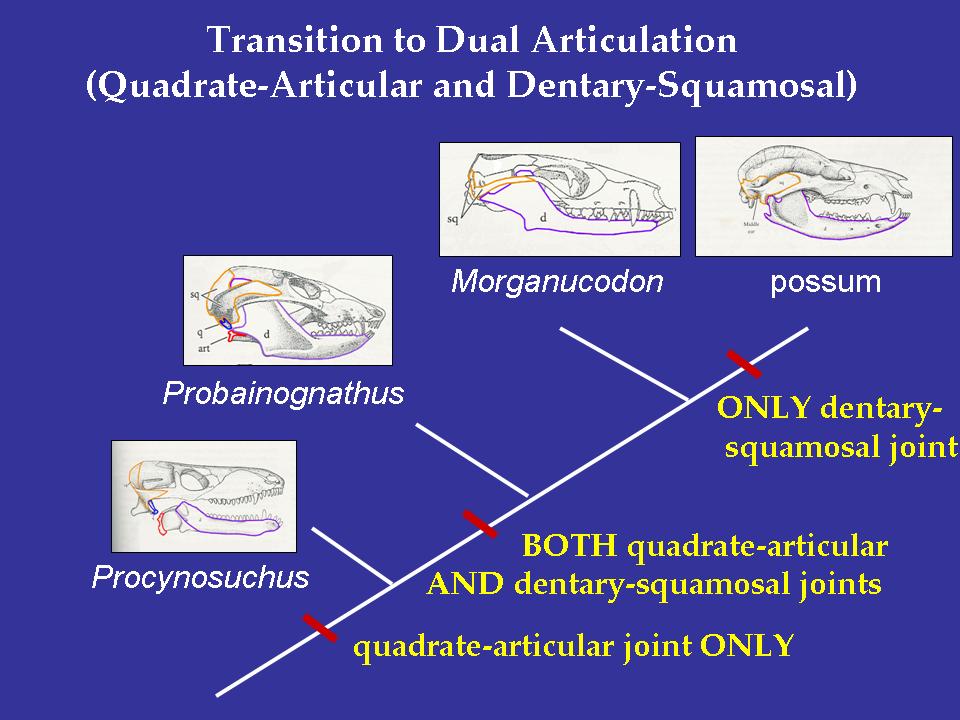 |
| Slide 62: The skulls in phylogenetic arrangement. Probainognathus and Morganucodon document exactly the transitional stage that Pandas claimed was undocumented. These fossils have jaws in which quadrate-articular and dentary-squamosal joints function simultaneously. |
| (Right-click to download pdf.) |
The next image is of a critter called Probainognathus, which again is not a mammal. It's a little bit closer to mammals than the first guy is, and in this animal you will see that now not only do we have the articulation between the Q bone and the art bone, which is the quadrate and the articular in the upper and lower jaws, but also there is an articulation between the bone in the lower jaw marked with a "D" called the dentary and the squamosal in the skull, and this can be seen perhaps if I can rouse it, sort of in this area here where the dentary and the squamosal would meet right next to the quadrate and the articular.
So these animals actually have what we call a dual jaw joint of two pairs of bones that are actually articulating next to each other on the upper and lower sides of the skull. The next slide is of Morganucodon, which is another animal, again slightly closer to mammals, that also shares this dual jaw joint of the two bones, and the top of the two bones with the bottom I won't bother with the details, and finally the fourth slide is of a typical garden variety, garbage pail variety possum, which has now changed this articulation so that only the dentary and the squamosal bones are connected.
The quadrate and the articular are no longer part of the jaw joint. So we have gone from a quadrate articular joint in which the dentary and squamosal don't participate to two animals, the second and third I showed, there are others like Diarthrognathus I could have shown, in which you have two pairs of bones sitting next to each other and articulating, making that jaw joint, to a situation in mammals, the possum is an example, but many, many mammals in the fossil record would do as well as all the mammals today in which just the new articulation the dentary squamosal is made.
So you might ask what happened to the quadrate and the articular bones, and the next slide shows that actually in the course of time you can see that, again just to summarize this, this transition, the next indication is of the original condition of the quadrate articular joint only to the next condition of having both the quadrate articular and the dentary squamosal joints which is present in these two animals to only the dentary squamosal joint, and this is the way that scientists understand this transition to have taken place.
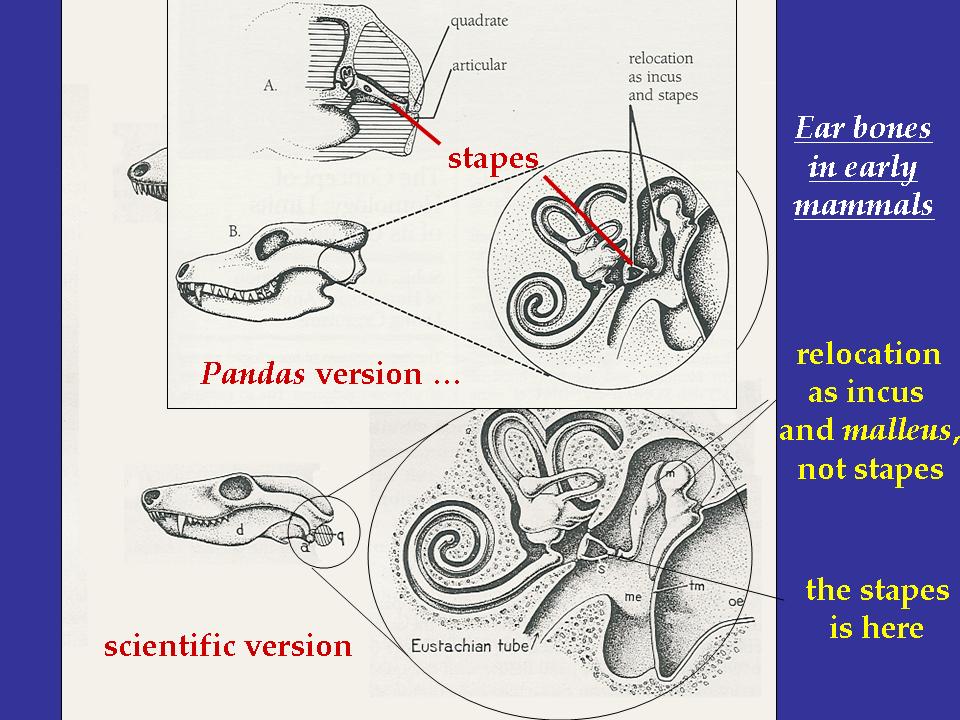 |
| Slide 63: Another mistake in Pandas. At top, Figure 5-7, p. 121 of Pandas says that "according to Darwinian theory" the quadrate and articular jawbones were relocated as the incus and stapes. But examination of a near-identical figure in Carroll's Vertebrate Paleontology and Evolution shows that it is actually the incus and the malleus that correspond to the quadrate and articular. |
| (Right-click to download pdf.) |
|
Credits: Middle ear from Pandas Figure 5-7, p. 121. ©1993 by Foundation for Thought and Ethics, Richardson, TX 75083-0721 Middle ear, scientific version from: Carroll, R.C. (1987). Vertebrate Paleontology and Evolution. W. H. Freeman and Co., New York. |
The next slide gives you a sense of what this anatomy is on the inside of the ear. Now what you're looking at in the top is a depiction of the ear bones in some of early mammals. Now, if you can see where the pointer is pointing here on this upper right diagram, this long structure here with a big hole in the middle is called the stapes, and this is an ear bone that connects up to the eardrum in the inner ear, this little funny snail shaped thing, this bone, the stapes, has been in animals ever since they came out on land.
In fact, even the watery ancestors of land animals have this in one form or another. Next to this you'll see a little "Q" and a little "A" which are the quadrate and the articular. These are the two parts that usually that before just made up the jaw joint, but now they are making up part of the ear bone. They are connecting up to it. On the bottom when you look at this, here is this stirrup shaped bone here which we would call the stirrup next to a bone marked by an "I", which is the anvil, and the bone next to it marked by an "M", which is the malleus, or hammer.
So malleus and the incus, or the hammer and the anvil, are actually the quadrate and the articular that used to be in the jaw joint, and now they are hooked up to the stapes here of the ear. They always were connected to the stapes, but now they are moved so that the hammer, or the articular, is now moved into the skull rather than being part of the lower jaw.
Now, Pandas says this is a very difficult transition to make, and yet we see it embryologically and we see this in the fossil record in the transition of the jaw joints. I think the next indication on the slide will give you a picture if I may, the next I think indication is the Pandas version of this, which identifies these bones as the incus and the stapes. The stapes as I have already shown is the stirrup. That's always been in the ear.
I'm not really sure why they call this a relocation as the incus and the stapes when it's been there when actually what is relocated is really the articular bone which used to be in the lower jaw and now is in part of the ear. So the anatomy here is a little bit confused, and I'm sure they didn't mean to do this purposely, but again if they get this wrong, how much else is wrong that we don't know about or that is not being shown to students or has not been obviously corrected in the second edition or in any subsequent work as far as I know?
I think the next slide shows where the stapes is in both things. That's just so you can see where the stapes is the comparable structures. They may look different. One is much more stirrup shaped than the other, which is more rod shaped, but they're the same bone. They hook up to the same structures.
Q. So again here the point that Pandas makes is that there cannot be and have not been natural processes that account for this evolution?
A. And this is just an example of the kind of argumentation that's made to try to say that these transitions are difficult to make and we have no evidence for them, but as I have shown and as you have seen there has been fossil evidence going back decades that show us animals with dual pairs of bones in the jaw joints which is perfect intermediate form. It's kind of like if you had a cup in this hand and you want to transfer it to this hand, well, you could go like that, just toss it from one to the other. But if you take it in both hands and then move it this way, but for a while you've got it in both hands. That's sort of what the mammal jaw was doing.
Q. Now, you've pointed out that what you have just testified about was well known 25 years before Pandas was written. I mean, that those articles were from the late 1960's. Are you familiar with qualifications or backgrounds of the authors of Pandas?
A. I know them as the authors of Pandas. I know very little else about them from firsthand experience.
Q. So that would be Dean Kenyon, Percival Davis, Nancy Pearcey, and Charles Thaxton. Have you ever encountered them at any meetings, paleobiology, evolutionary biology, seen any peer reviewed publications? What can you tell us about these authors?
A. I can say that none of those authors or the other people I know as consulting people on their masthead, I have never seen them at scientific meetings in my fields as far as I know. I've never known them to give papers at those meetings. I've never known them to publish in the peer reviewed literature of any of the fields related to evolutionary biology or paleontology if you want to go to specifics or anything else in related fields, and I haven't seen their work cited by scientists in those fields when discussing advances in science.
Q. Let me ask you the same question about two experts who will be testifying in the coming weeks for the school district. One is Michael Behe, and the other is professor Scott Minnick. Same question, are these folks who are recognized in the field?
A. Not in any of the fields in which I'm familiar, but it would hold they, like the authors of Pandas, may be qualified in other fields, but as far as I understand their experience, accomplishments in the fields related to evolutionary biology, I know of no particular work that they have done that would provide expertise.
Q. So you haven't seen any peer reviewed publications from these individuals involving evolutionary biology or paleontology?
A. Not in those fields, no. Although I don't doubt in their own field they might produce perfectly good work.
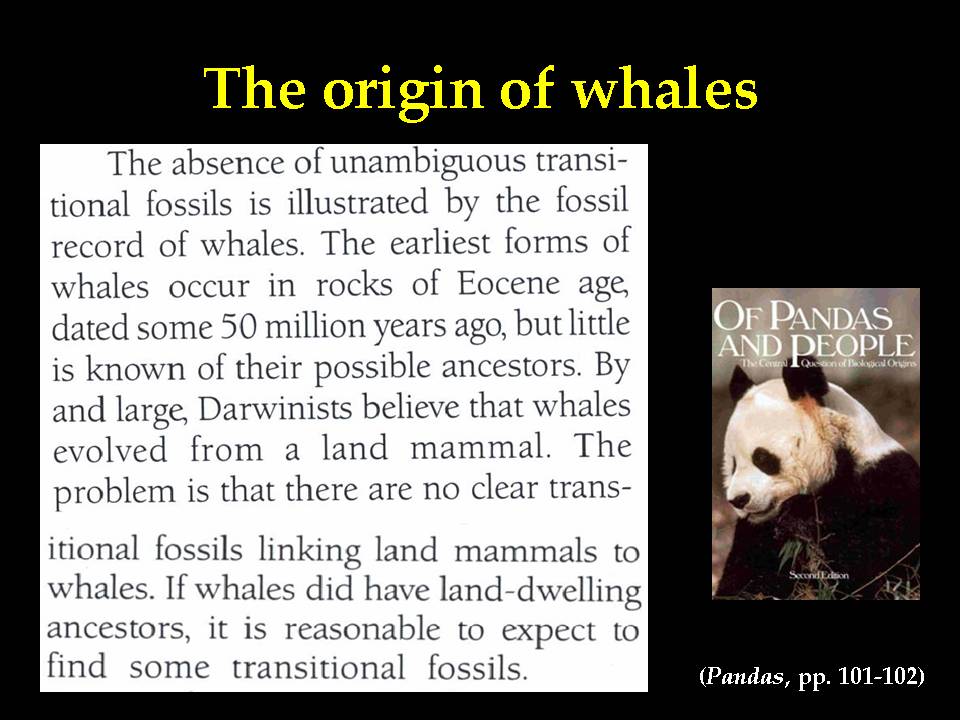 |
| Slide 64: Padian moves on to the origin of whales. Pandas claims "there are no clear transitional fossils linking land mammals to whales." (pp. 101-102) |
| (Right-click to download pdf.) |
The Origin of Whales
Q. Let's take one, just more example of the evolution of mammals, and one that Pandas identifies as not being able to evolve naturally is whales, and I'm wondering if, you've prepared a demonstrative to show us how Pandas treats the whales and then explain what science knows about the evolutionary process?
A. I would like to discuss this a bit if I may have the next set of slides. In Pandas, here on page 101 and 102 --
Q. Could you read that passage?
A. The whole passage?
Q. Yes, please.
A. "The absence of unambiguous transitional fossils is illustrated by the fossil record of whales. The earliest forms of whales occur in the rocks of the Eocene age, dated some fifty million years ago, but little is known of their possible ancestors. By and large, Darwinists believe that whales evolved from a land mammal. The problem is that there are no clear transitional fossils linking land mammals to whales. If whales did have land dwelling ancestors it's reasonable to expect to find some transitional fossils."
Q. End quote?
A. End quote.
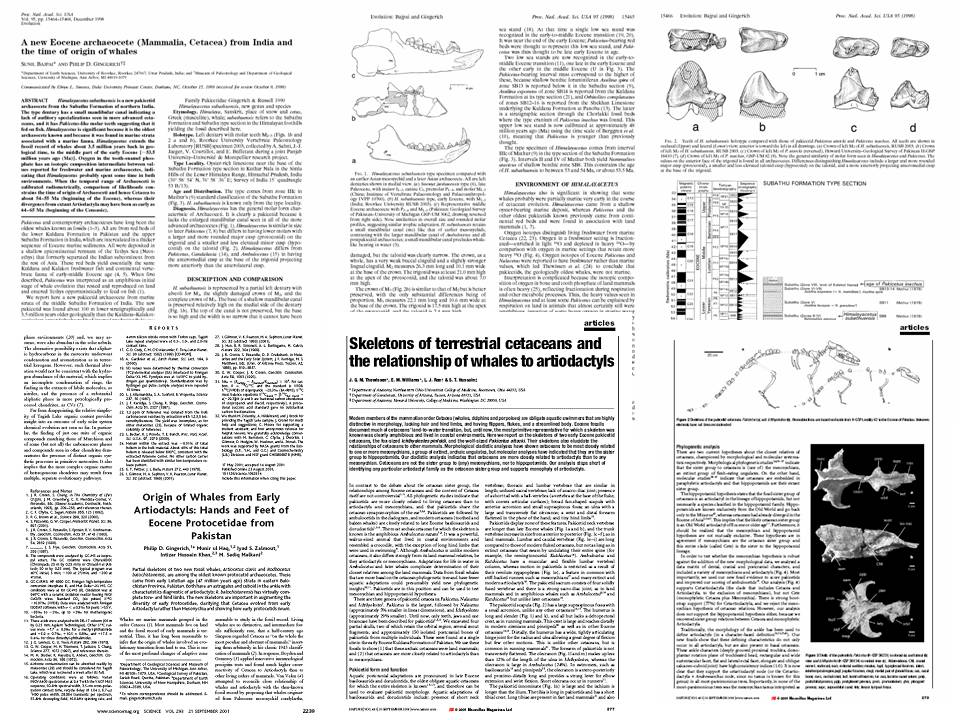 |
| Slide 65: Recent journal articles on fossil whales with legs. |
| (Right-click to download pdf.) |
Q. And in fact what does the science show?
A. Well, some of the disturbing things about that quote is apparently that the evolution of whales is something that Darwinists believe, and again it's sort of a faith based proposition that seems to have no real evidence. The Pandas authors then go on to say that there are no clear transitional fossils. It raises the question of what they might accept as a transitional fossil, but what I'd like to show you is what some of the evidence is accepted by fossils in ways of making these transitions of features.
Again on the screen here you saw some peer reviewed publications from Nature, Science, and the Proceedings of the National Academy of Science of the US A.
Q. Could you just read a couple of the titles and journal articles into the record?
A. A title here is Skeletons of Terrestrial Cetaceans, which are whales, and The Relationship of Whales to Artiodactyls, which are the hoofed mammals.
Q. And what publication is that from?
A. That comes from Nature I believe. Another article here from Science is called Origin of Whales From Early Artiodactyls, which again are the hoofed mammals, Hands and Feet of Eocene Protoceditae, which is an early group of whales from Pakistan. Those are couple of examples.
Q. So now the testimony you're about to give about whales, does this come from this and other peer reviewed studies?
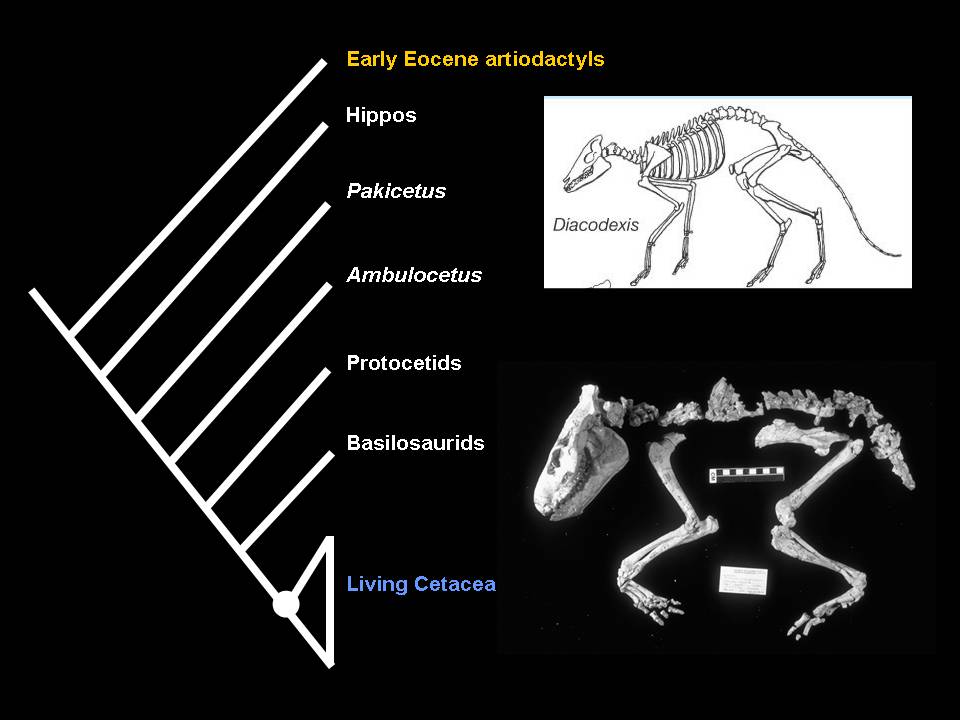 |
| Slide 66: As with birds and mammals, Padian will display the fossil relatives of modern whales and dolphins (cetaceans) in their phylogenetic context. The origin of whales was long debated, but in recent years molecular and fossil data converged to support the hypothesis that whales evolved within the artiodactyl group. Traditionally, the artiodactyl group included the even-toed ungulates (hoofed animals) -- animals like goats, cows, and hippos. These animals are large, herbivorous, and have thick hooves, but some fossil artiodactyls were small, with small hooves, and omnivorous (as are modern pigs). Shown in the slide are Diacodexis, the first artiodactyl (about the size of a rabbit) and an oreodont, another early artiodactyl. |
| (Right-click to download pdf.) |
|
Credits: Diacodexis reconstruction from Figure 1, page 259 of: de Muizon, Christian (2001). "Walking with whales." Nature, 413(6853), 259-260. (DOI) Reprinted by permission from Macmillan Publishers Ltd., copyright 2001. Reproduced with permission of the UC Museum of Paleontology. Source: http://www.ucmp.berkeley.edu/mammal/artio/artiofr.html. |
A. Yes. If I could have the next slide I can show you a bit about this. Once again we're going to use this hat rack cladogram relationship diagram, and again it's turned on its side so that you've got living cetacea, whales, on the bottom in blue. That group of whales and dolphins has a bunch of fossil relatives. The closest one are called basilosaurids. Outside them are protocetids, and there's a couple of forms from the Eocene called Ambulocetus and Pakicetus, and outside that are hippos, which are the closest living relatives of whales, and outside of that we've just listed some early Eocene artiodactyls, or hoofed mammals, from which we have recognized certain characteristics that are shared between hippos and whale, as odd as it might seem.
The skeletons you see there are some fossils from the Eocene of hoofed mammals, members of the group artiodactyl, the ones with the even toes, and we just put them up there to show that we do have fossils of such things.
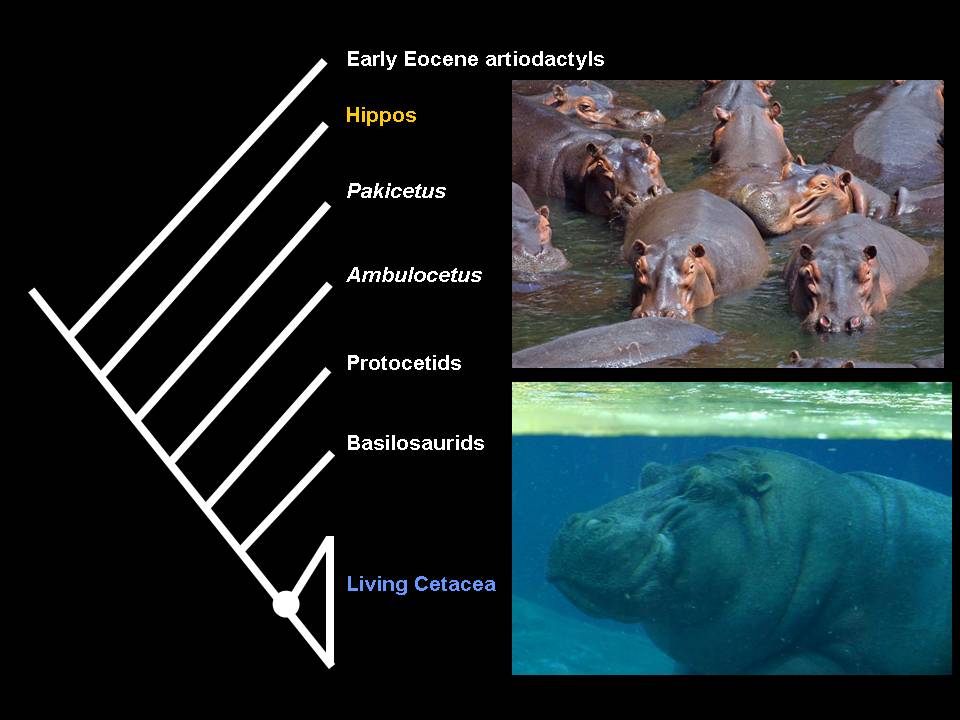 |
| Slide 67: Hippos are the closest living relatives of cetaceans. This relationship was indicated by molecular evidence in the 1990s, and confirmed by key morphological features shared between anthracotheres (the fossil ancestors of hippos) and early whales in 2005. |
| (Right-click to download pdf.) |
|
Credits: Photo by Aaron Logan (source: http://en.wikipedia.org/wiki/Image:Lightmatter_hippo.jpg), licensed under Creative Commons Attribution 2.0). Photo by Paul Maritz (source: http://en.wikipedia.org/wiki/Image:Hippo_pod_edit.jpg), available under the GNU Free Documentation License. |
The next slide gives you a sense of hippos, which no one needs any introduction to,...
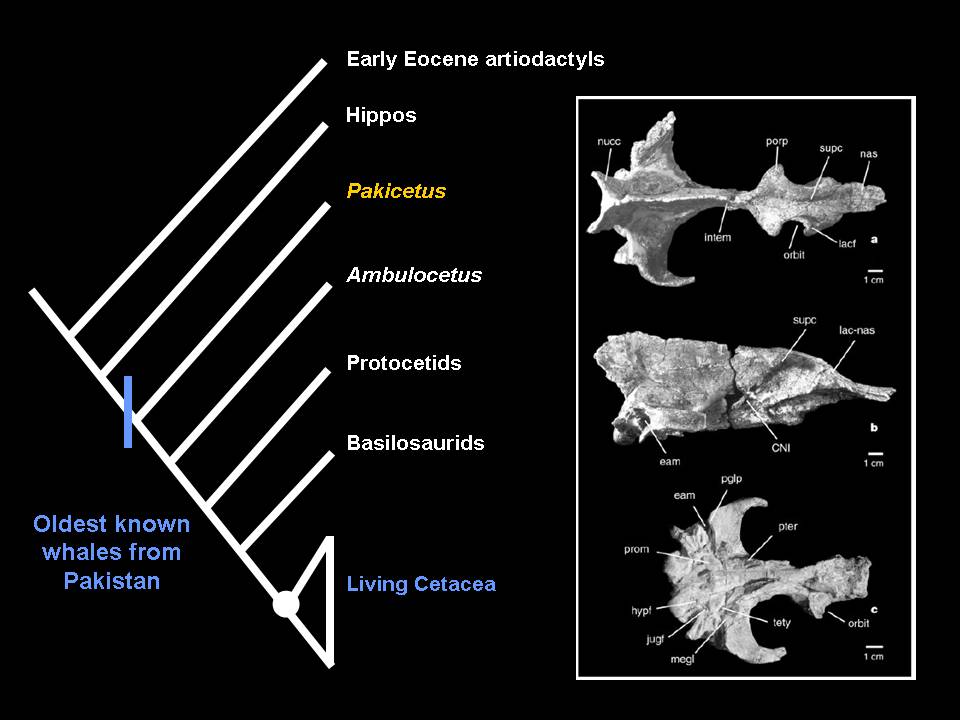 |
| Slide 68: Pakicetus is a whale from Pakistan, sharing key skull features with fully aquatic whales. |
| (Right-click to download pdf.) |
|
Credits: Pakicetus skulls from Figure 3, page 279 of: Thewissen, J. G. M.; Williams, E. M.; Roe, L. J.; Hussain, S. T. (2001). "Skeletons of terrestrial cetaceans and the relationship of whales to artiodactyls." Nature, 413(6853), 277-281. (DOI) Reprinted by permission from Macmillan Publishers Ltd., copyright 2001. |
...so we'll pass to the next slide, which is a particularly interesting set of photographic views of a skull, or a partial skull and brain case of an animal called Pakicetus, the critter in the yellow, well, orange or whatever that is, outlined term, that is again closer to whales of today than hippos and the other Eocene artiodactyls are.
This is a another of some of the oldest whales which come from Pakistan, India, Egypt, that area of the world, which once was the edge of an ancient sea in the early part of the Tertiary period, fifty, sixty million years ago when all this was happening. The images on the right are photographs of one of the brain cases and skulls of Pakicetus, and the reason for showing this is just to let you know, although I won't go into any detail, that what Pakicetus shares with whales that live today are not that it has a blow hole or flukes or anything like that, but that it has an ear region with features that are only found in whales.
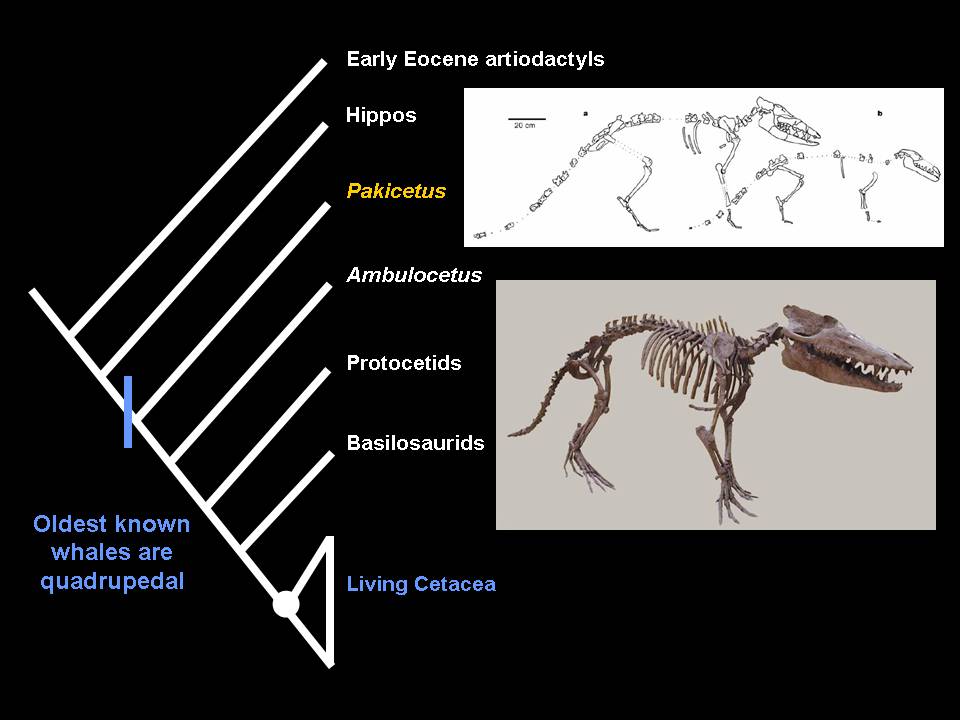 |
| Slide 69: However, Pakicetus was a whale with legs. |
| (Right-click to download pdf.) |
|
Credits: Pakicetus and Ichthyolestes reconstruction from Hans Thewissen's whale evolution page, http://www.nature.com/nature/journal/v413/n6853/fig_tab/413277a0_F2.html (public access granted) Pakicetus attocki fossil in the collection of: Northeastern Ohio Universities College of Medicine c/o Howard University - Geological Survey of Pakistan Collection. Photograph from http://www.researchcasting.ca/pakicetus.htm, reproduced with permission. |
And by this we infer that they share a common ancestor with the first whales. That would be fairly tenuous evidence if we didn't have other evidence, but the next slide will show you that the evidence of this animal does not make it look a lot like a whale either. It's obviously a four-legged critter. It is happy running around on the ground. It looks like a garden variety quadruped, four-footed critter that runs around doing its business, whatever it does, and except for this funny ear region you might not really get a sense of its relationship to whales.
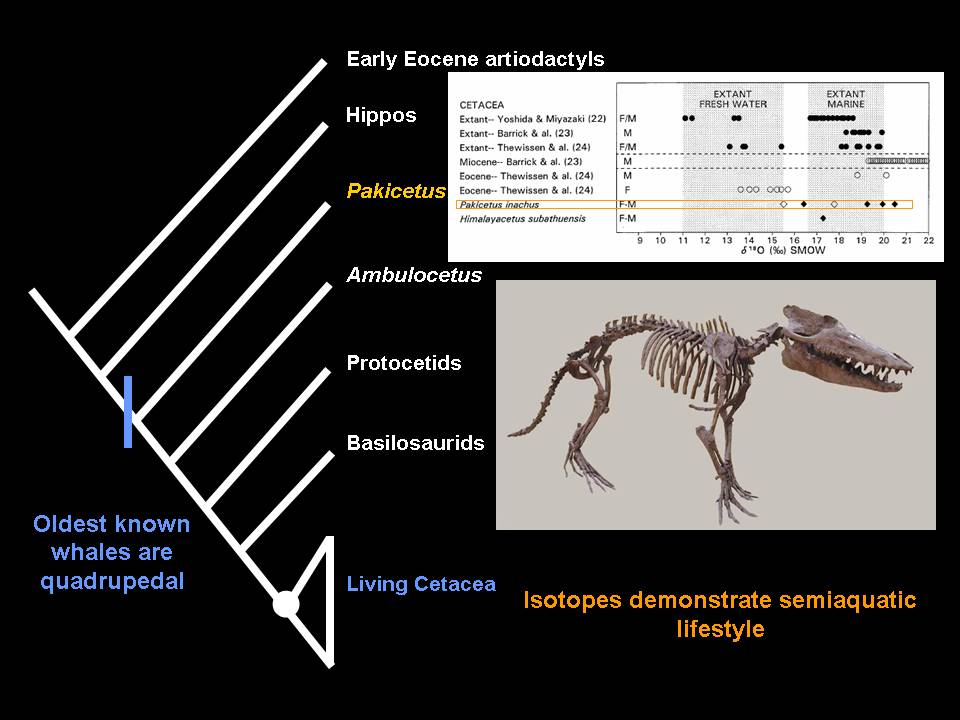 |
| Slide 70: Oxygen isotope ratios from the tooth enamel of fossils indicates that Pakicetus probably fed in the shallow Tethys sea and its estuaries. |
| (Right-click to download pdf.) |
|
Credits: Figure 4, p. 15467, from: Bajpai S.; Gingerich, P.D. (1998). "A new Eocene archaeocete (Mammalia, Cetacea) from India and the time of origin of whales." Proceedings of the National Academy of Sciences, 95(26), 15464-15468. (PNAS) Reproduced with permission. Copyright 1998 National Academy of Sciences, U.S.A. |
And so we note that they are quadrupedal, or four-legged, but the next slide shows you something interesting about them. That stop slide has now changed to just admit a little bit of the insights that we get from isotopes. These are isotopes of oxygen, and oxygen comes in different kind of molecular forms, and the percentage of those forms varies between terrestrial and aquatic horizons, environments, so that when we find bones that are made with oxygen elements that contain this isotopic signal, we can get an idea of whether these animals were primarily terrestrial or aquatic.
In the next slide there's a little indication on this slide there, you can see that the isotopes for Pakicetus demonstrates that it falls in the fresh water marine kind of realm. So we think if this evidence is correct that this animal was spending at least part of its time in water, including brackish or marine water. So it's already getting out there somewhere, but it's still a quadrupedal critter.
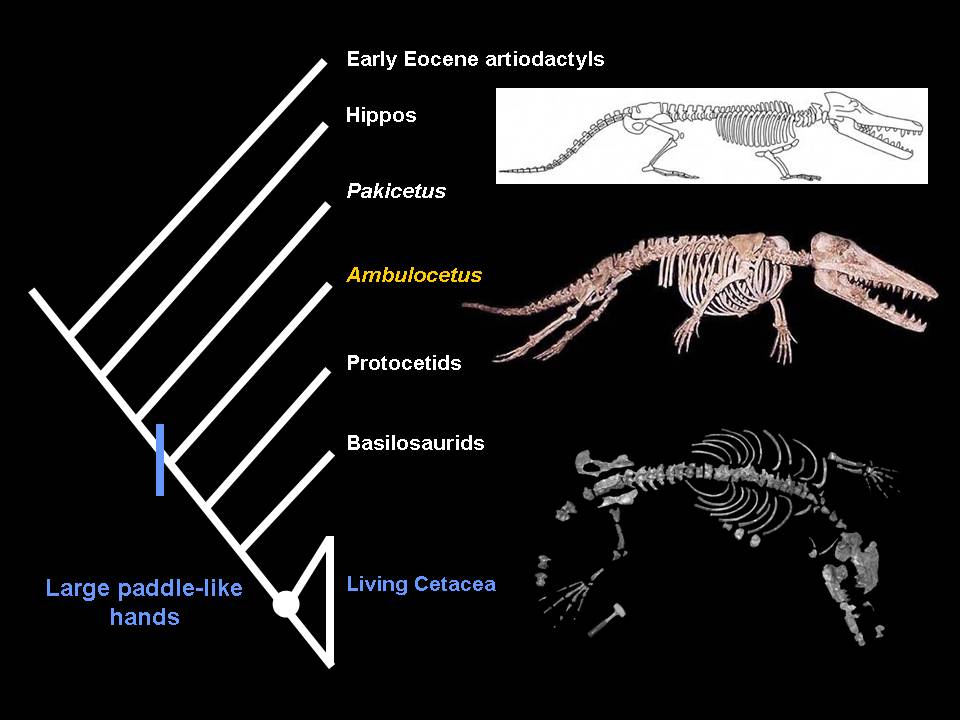 |
| Slide 71: Ambulocetus was fully aquatic or nearly so, but still had reduced limbs. |
| (Right-click to download pdf.) |
|
Credits: Ambulocetus reconstruction from Hans Thewissen's whale evolution page, http://web.neomed.edu/web/anatomy/Thewissen/whale_origins/index.html (public access granted) Ambulocetus fossil in the collection of the Northeastern Ohio Universities College of Medicine. Photograph from http://www.researchcasting.ca/ambulocetus.htm, reproduced with permission. Ambulocetus fossil photo modified from Hans Thewissen's whale evolution page, http://web.neomed.edu/web/anatomy/Thewissen/whale_origins/index.html (public access granted) |
The next slide I think is going to give you a sense of Ambulocetus, which means walking whale. Again it still has legs, and as the restoration at the top shows it looks like it's perfectly okay getting around on land,...
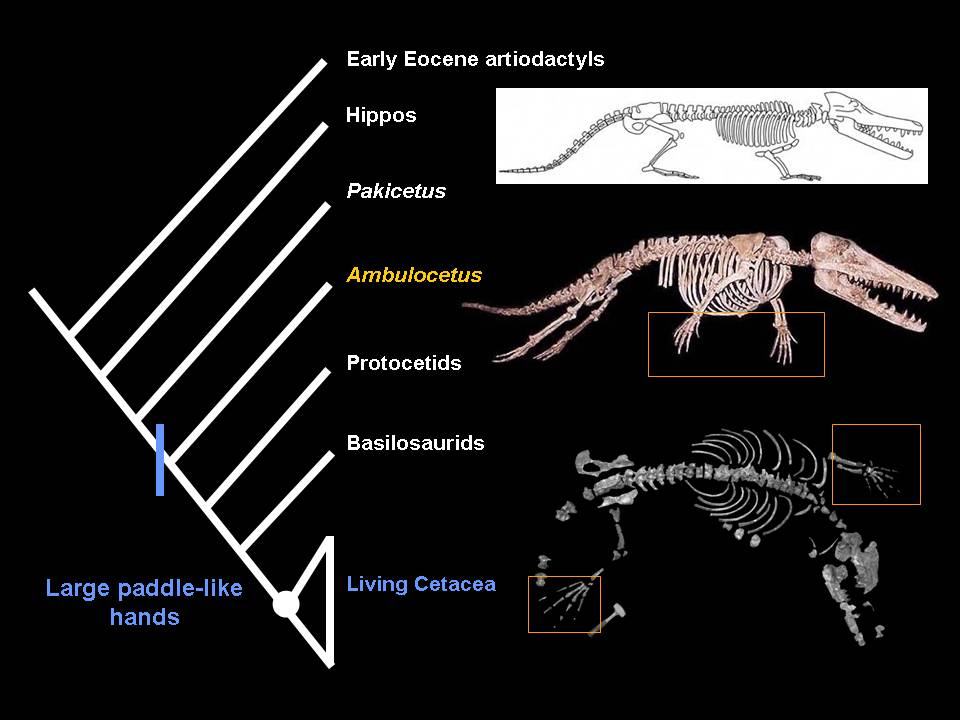 |
| Slide 72: The hands and feet are large and paddle-like. |
| (Right-click to download pdf.) |
...but the next indication on this slide will show you that the limbs are large and paddle like. So the hands and the feet are clearly already being broadened and are apparently some use to the animal in getting around in the water, and these are actual skeletons again from the Eocene.
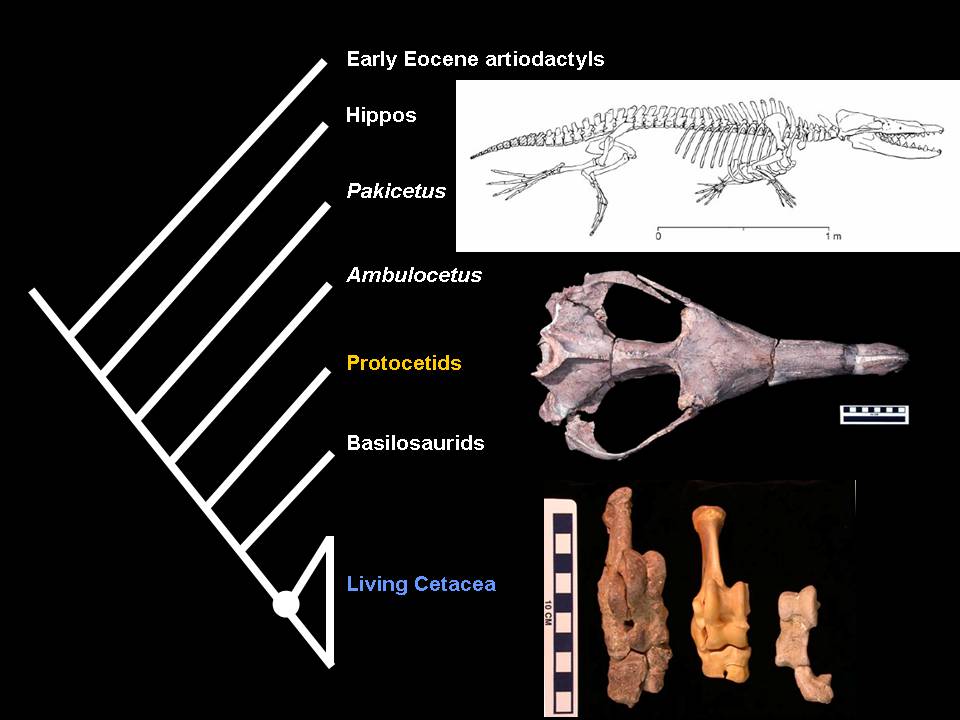 |
| Slide 73: Top and middle: Rodhocetus reconstruction and Artiocetus clavis skull. The bottom photo shows the ankle bones of Rodhocetus, a modern pronghorn antelope, and Artiocetus. |
| (Right-click to download pdf.) |
|
Credits: Rodhocetus from Figure 3, p. 2241 of: Gingerich, P. D.; M. Haq; I. S. Zalmout; I. H. Khan; and M. S. Malkani (2001). "Origin of Whales from Early Artiodactyls: Hands and Feet of Eocene Protocetidae from Pakistan." Science 293(5538), 2239-2242. (DOI) Reproduced with permission. Artiocetus clavis photograph from Philip Gingerich's whale evolution page. ©2001 Philip Gingerich. Reproduced with permission. Protocetid ankles from Philip Gingerich's whale evolution page. Photograph ©2001 Philip Gingerich. Reproduced with permission. |
The next slide shows you protocetids, which are ancient whale relatives that are a little bit closer than the last one was to the whales of today, and protocetids are kind of interesting.
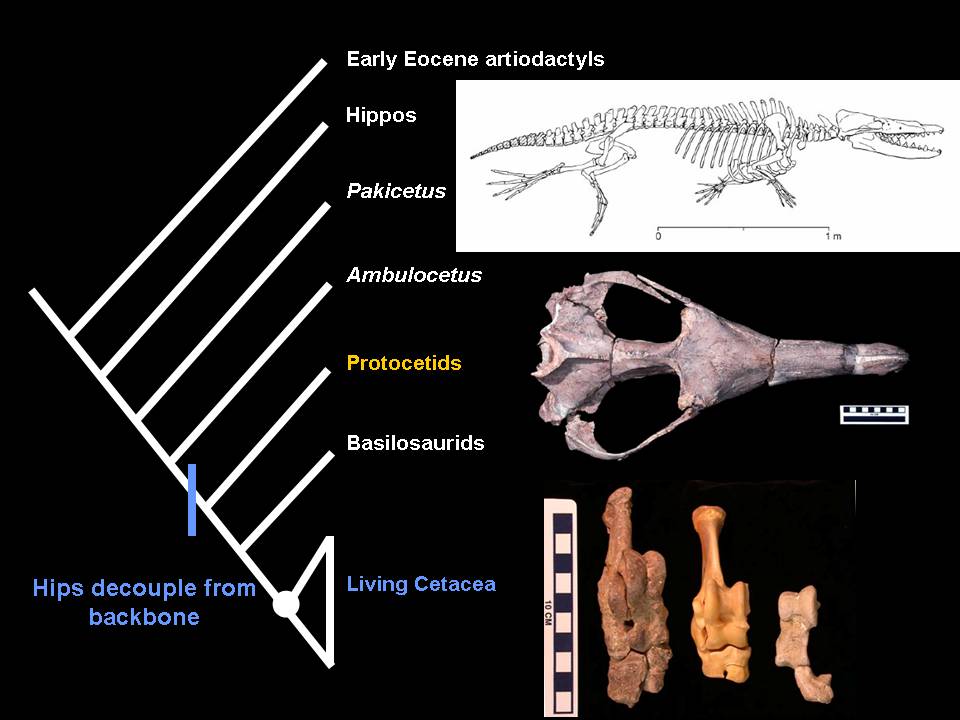 |
| Slide 74: In the protocetids, the hips are decoupled from the backbone. They definitely were not running animals. |
| (Right-click to download pdf.) |
If you, the next indication I think will show that the hips on these animals have been decoupled from the backbone. That is they are no longer connected to the spinal column.
Why this would be might be difficult to fathom, pardon the pun, except that these animals are probably using their backbone, moving it up and down the way whales swim in the water, and if you have your limbs encumbered to your backbone it's just going to be that much more difficult to do it.
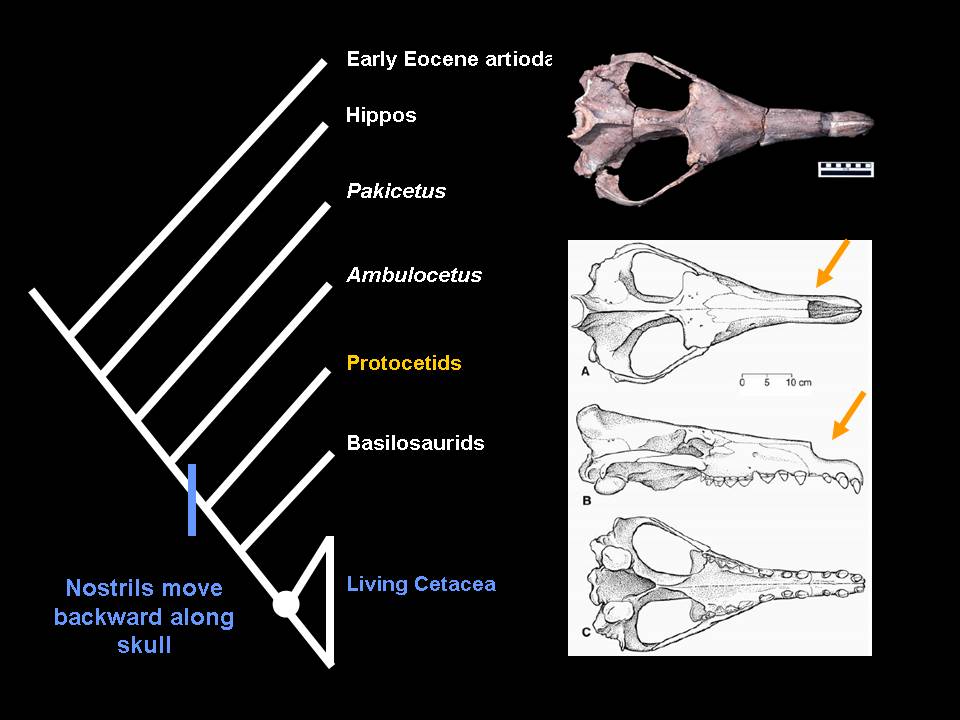 |
| Slide 75: Artiocetus clavis skull. The nose is still at the front of the skull, unlike modern whales. |
| (Right-click to download pdf.) |
|
Credits: Artiocetus skull from Figure 1, p. 2240 of: Gingerich, P. D.; M. Haq; I. S. Zalmout; I. H. Khan; and M. S. Malkani (2001). "Origin of Whales from Early Artiodactyls: Hands and Feet of Eocene Protocetidae from Pakistan." Science 293(5538), 2239-2242. (DOI) Reproduced with permission. |
This may be part of the reason why the decoupling is there, and yet these animals, as you'll see from the next indication, still have skulls in which they're getting some increasingly whale-like characteristics, including the nostrils, which are beginning to move backward along the skull.
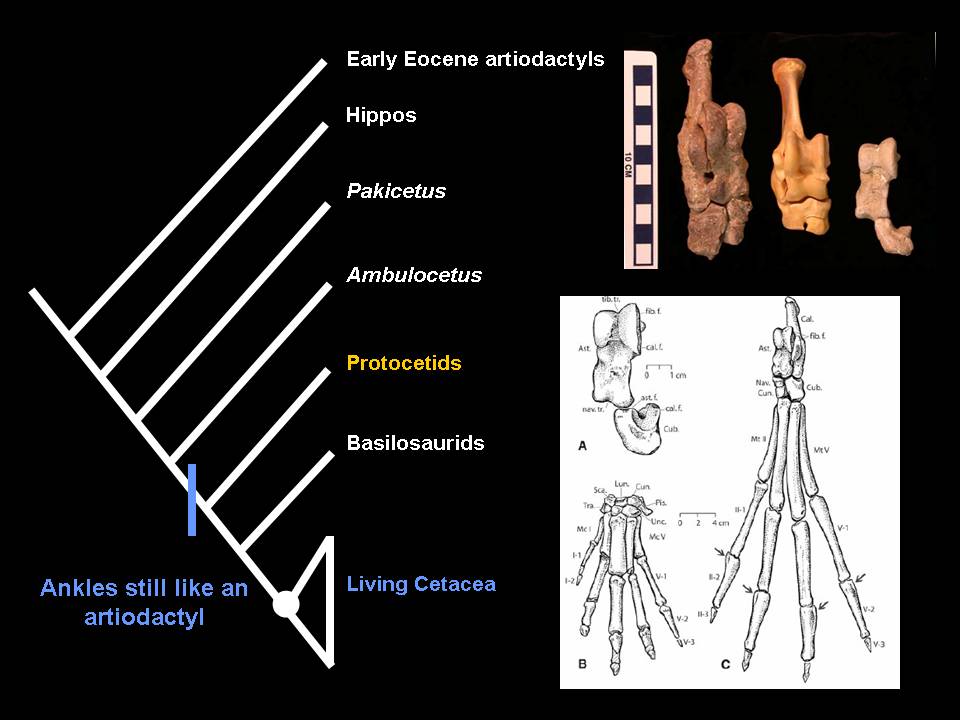 |
| Slide 76: The drawing shows the astragalus of Artiocetus (A) and full ankle of Rodhocetus balochistanensis (C) (astragalus bone near the top). Rodhocetus's foot was certainly a swimming flipper, but still retained small hooves. The photo shows three ankles, respectively those of Rodhocetus, a modern pronghorn antelope, and Artiocetus. Remarkably, all three show a "double-pulley" astragalus. The astragalus is the bone with the deep, rounded groove in it (imagine a rope fitting into the groove of a pulley wheel). This groove, called a trochlea, fits another bone to form a sliding joint. The artiodactyl astragalus -- in both the modern pronghorn and these ancient swimming whales -- has the unique feature of having two trochleas, one on each end. This is the "double-pulley." These protocetid whales were definitely not runners, but they retain a clear mark of their ancestry as hoofed running animals. See Gingerich's website and paleos for more details. |
| (Right-click to download pdf.) |
|
Credits: Protocetid hindlimb/ankle reconstructions from Figure 2, p. 2241 of: Gingerich, P. D.; M. Haq; I. S. Zalmout; I. H. Khan; and M. S. Malkani (2001). "Origin of Whales from Early Artiodactyls: Hands and Feet of Eocene Protocetidae from Pakistan." Science 293(5538), 2239-2242. (DOI) Reproduced with permission. |
As you know, in whales the blow hole is right up close to the eyes. The next slide I think shows that even though these animals are quite aquatic and have a lot of whale features, they still have ankle bones that are very much like the ankle bones in the hoofed mammals from which they evolved, including ankles with a double pulley joint and a lever arm off the end.
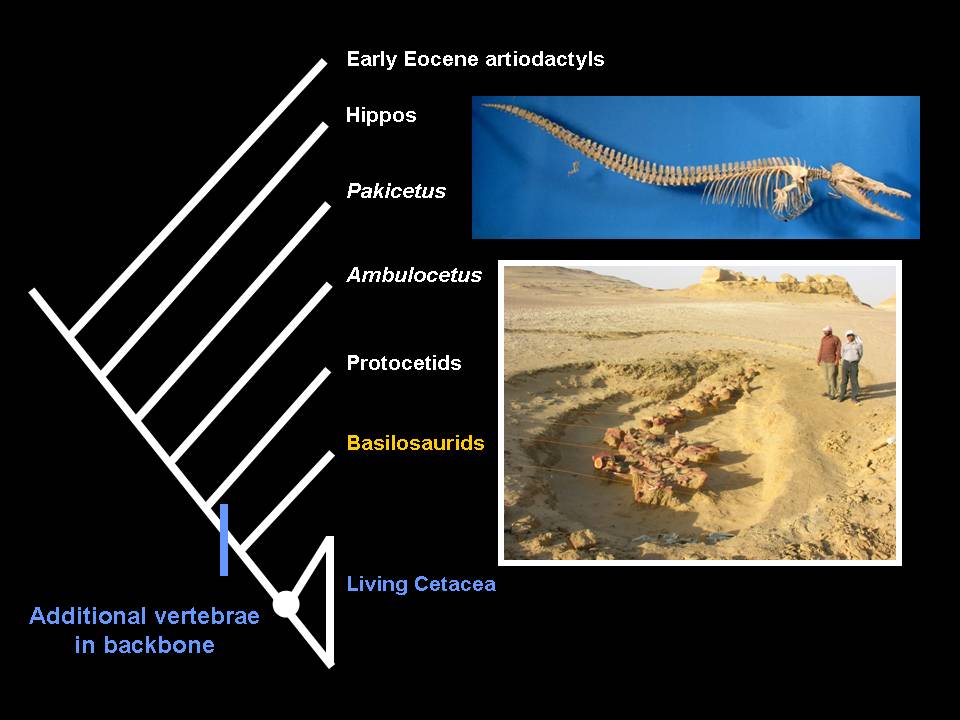 |
| Slide 77: Mounted skeleton of Dorudon atrox, a basilosaurid, and Basilosaurus isis fossil excavation in Egypt. Basilosaurus was first discovered in the southern U.S. in the early 1800s and was originally thought to be a reptile (thus the "saurus"). |
| (Right-click to download pdf.) |
|
Credits: Dorudon from Philip Gingerich's whale evolution page. Photograph ©1998 Philip Gingerich. Reproduced with permission. Basilosaurus in situ from Philip Gingerich's whale evolution page. Photograph ©2005 Philip Gingerich. Reproduced with permission |
Even though these animals are spending more and more time in water, they can still deal okay on lands. The next slide I think will show a basilosaurid, which is the next step toward living whales, and this is quite a different proposition.
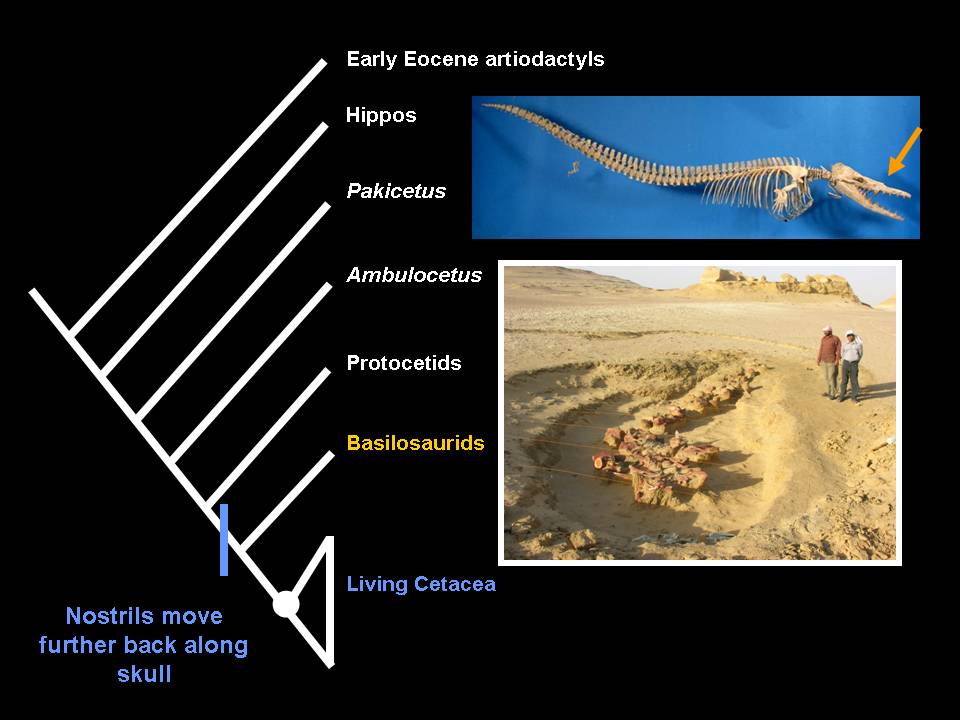 |
| Slide 78: In the basilosaurids, the nostrils have moved further back along the skull. |
| (Right-click to download pdf.) |
The next indication will show you where the nostrils are, they're moving even farther up along the skull,...
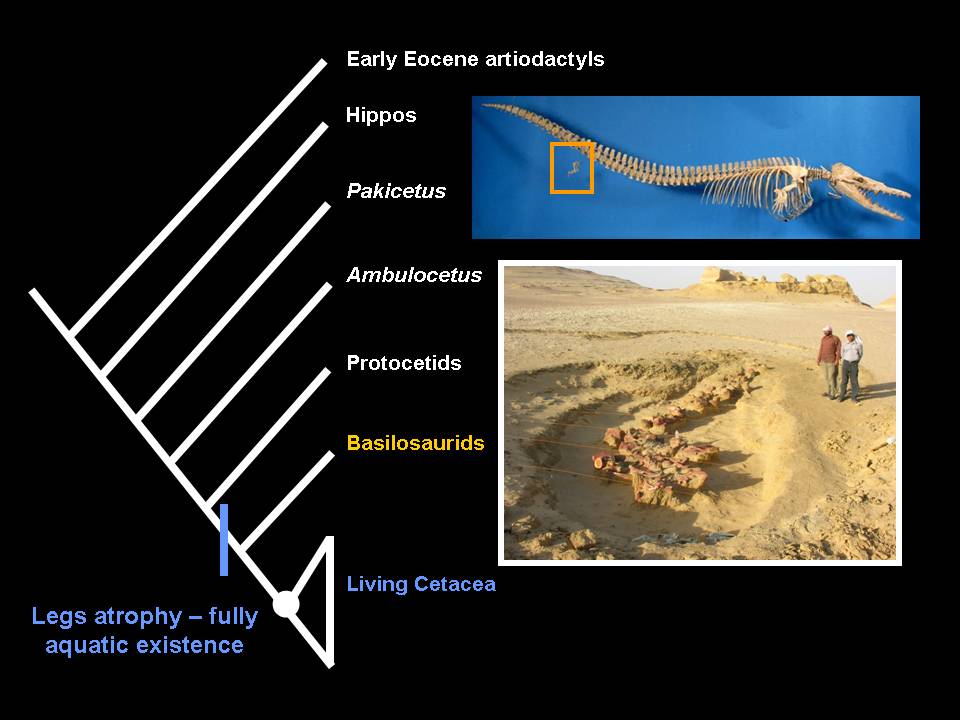 |
| Slide 79: The hind limbs of the basilosaurids were vestigial. These whales were fully aquatic and could not even drag themselves onto a beach. |
| (Right-click to download pdf.) |
... and the next indication shows you about the hind limb bones, which are again the next indication is a close-up of this, the hind limbs are now not just decoupled from the back bone, they've become extremely reduced.
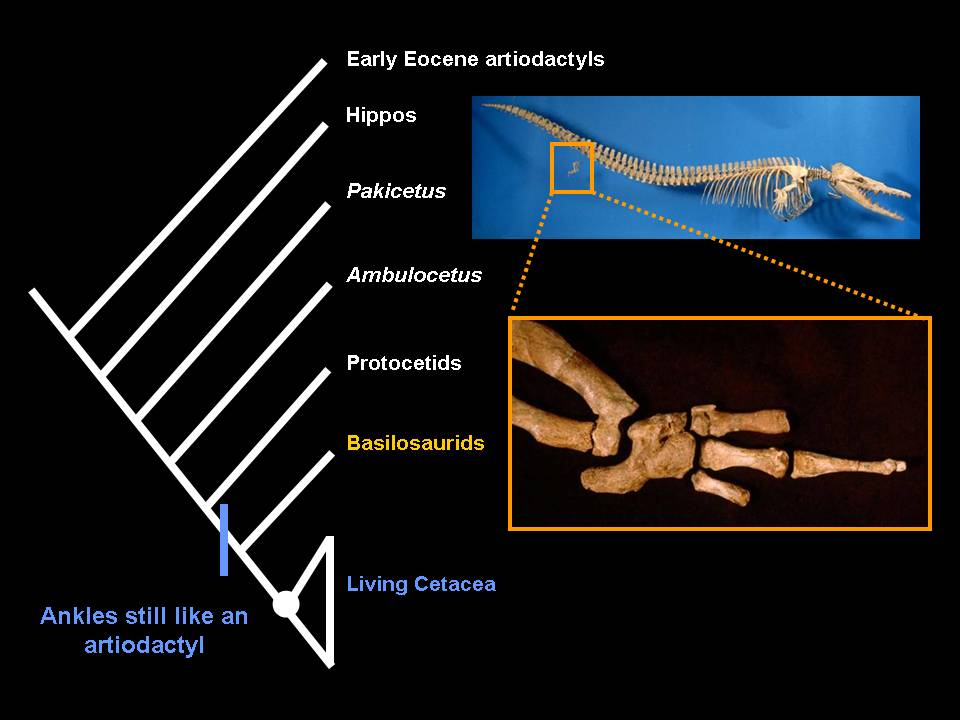 |
| Slide 80: Incredibly, the hind limbs still retain the "double-pulley" astragalus in the ankle. |
| (Right-click to download pdf.) |
|
Credits: Basilosaurus hindlimb from Philip Gingerich's whale evolution page. Photograph ©1991 Philip Gingerich. Reproduced with permission. |
But as you'll notice, right in the middle of that slide is that pulley shaped bone with a little hook off it. That is the ankle. And so the ankle is still like the ankle of a terrestrial animal, a hoofed mammal, from which they evolved, even though this animal couldn't any more walk on land than it could fly.
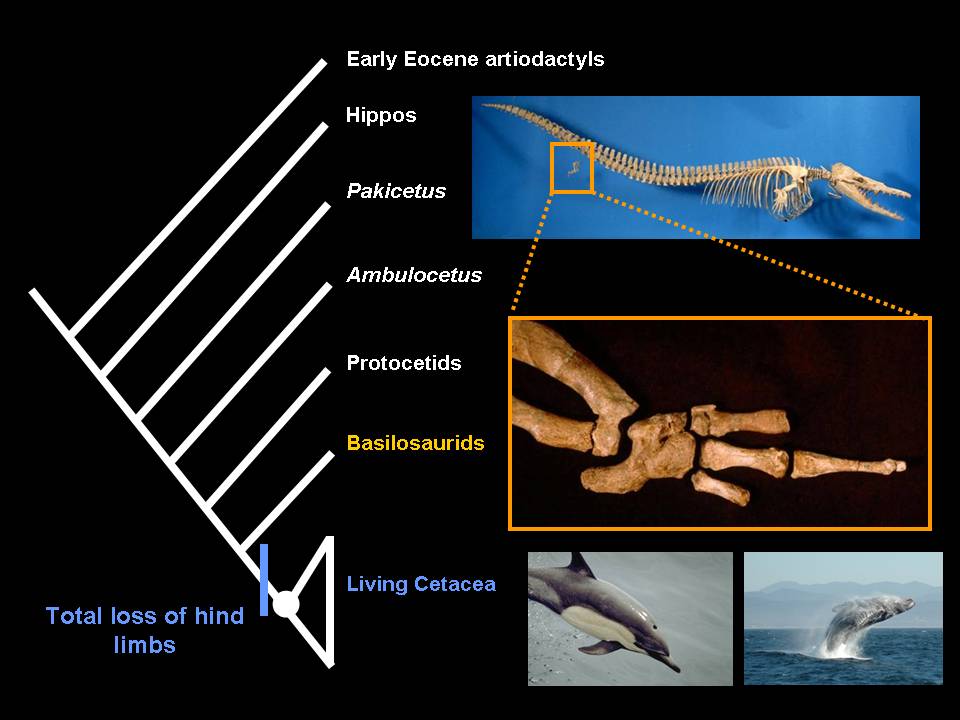 |
| Slide 81: In living dolphins and whales, the nostrils are at the top of the skull, and they have completely lost their hind limbs, except for rare atavisms. |
| (Right-click to download pdf.) |
|
Credits: Dolphin is a public domain image from NOAA, source: http://en.wikipedia.org/wiki/Image:Common_dolphin.jpg Humpback whale reproduced under the Creative Commons Attribution ShareAlike License v. 2.5. Source: http://en.wikipedia.org/wiki/Image:DSC_7334.JPG |
So what we're seeing here is the progression of features more and more whale-like from animals that are terrestrial and conventional land going animals through some really minor features beginning in such odd regions as the ear, which you might not expect to be one of the first things that would change, all the way down to this, the final thing we have here is the living cetacean, which looks, you know, very much like the whales of today because they are the whales of today, and they've almost completely lost the hind limbs. So this is the situation as paleontologists know it in a kind of a, you know, very vague general nutshell.
Q. And this is completely contradictory to which Pandas has said?
A. Well, you look at the treatment that they've given us and that we've just seen, they've told us that there are no clear transitional fossils and that the fossil record of whales is a poster child for the absence of unambiguous transitional fossils, but we think the transition is pretty good.
Q. Now, most of these fossils that you have just pointed to were in fact discovered after the publication of Pandas in 1993?
A. Many of them were. Some of them were still around. Basilosaurids, the last, second to last guys I showed, have been known since the Civil War.
Q. Does the fact that Pandas suggests that there are no transitional fossils and kind of insert an intelligent designer as the cause because of that, what's the implication of finding new evidence where Pandas asserts a designer?
A. Well, again I think it sets a very confusing message to students as well as to everybody, the public included, that I don't know what you're supposed to think from this. Either there is no designer or the methods of intelligent design are very badly flawed, but in each case it confuses rather than advances the educational purpose.
Q. Well, does it also not show up a flaw in the logic of intelligent design, so the fact that we don't have transitional fossils today means the only other possibility is there must have been a designer, whereas in fact what we have now found is now, there are other possibilities we may actually find natural causes for?
A. And so the fallacy is that if we don't have enough evidence for evolution, we must therefore conclude that these things had a supernatural origin.

